

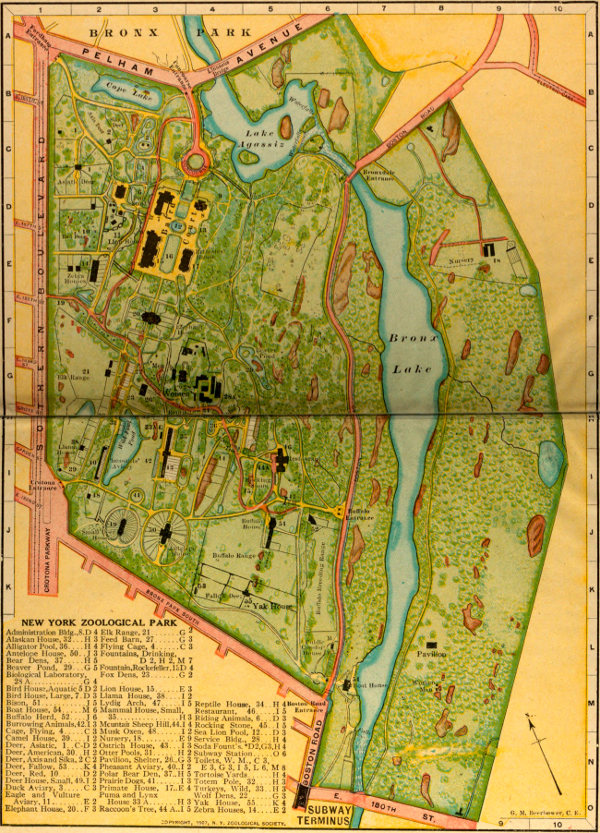
NEW YORK ZOOLOGICAL PARK
High-resolution Map
| Administration Bldg., 8 | D 4 |
| Alaskan House, 32 | H 3 |
| Alligator Pool, 36 | H 4 |
| Antelope House, 50 | J 3 |
| Bear Dens, 37 | H 5 |
| Beaver Pond, 29 | G 5 |
| Biological Laboratory, 28 A | G 4 |
| Bird House, Aquatic, 5 | D 2 |
| Bird House, Large, 7 | D 3 |
| Bison, 51 | J 5 |
| Boat House, 54 | M 6 |
| Buffalo Herd, 52 | J 6 |
| Burrowing Animals, 42 | I 3 |
| Cage, Flying, 4 | C 3 |
| Camel House, 39 | I 2 |
| Deer House, Small, 49 | I 2 |
| Deer, American, 30 | H 2 |
| Deer, Asiatic, 1 | C-D 2 |
| Deer, Axis and Sika, 2 | C 2 |
| Deer, Fallow, 53 | K 4 |
| Deer, Red, 10 | D 2 |
| Duck Aviary, 3 | C 3 |
| Eagle and Vulture Aviary, 11 | E 2 |
| Elephant House, 20 | F 3 |
| Elk Range, 21 | G 2 |
| Feed Barn, 27 | G 3 |
| Flying Cage, 4 | C 3 |
| Fountain, Rockefeller, 13 | D 4 |
| Fountains, Drinking, | D 2, H 2, M 7 |
| Fox Dens, 23 | G 2 |
| Lion House, 15 | E 3 |
| Llama House, 38 | I 2 |
| Lydig Arch, 47 | I 5 |
| Mammal House, Small, 35 | H 3 |
| Mountain Sheep Hill, 44 | I 4 |
| Musk Oxen, 48 | I 2 |
| Nursery, 18 | E 9 |
| Ostrich House, 43 | I 3 |
| Otter Pools, 31 | H 2 |
| Pavilion, Shelter, 26 | G 3 |
| Pheasant Aviary, 40 | I 2 |
| Polar Bear Den, 37 | H 5 |
| Prairie Dogs, 41 | I 3 |
| Primate House, 17 | E 4 |
| Puma and Lynx House, 33 A | H 3 |
| Raccoon’s Tree, 44 A | I 5 |
| Reptile House, 34 | H 4 |
| Restaurant, 46 | I 5 |
| Riding Animals, 6 | D 3 |
| Rocking Stone, 45 | I 5 |
| Sea Lion Pool, 12 | D 3 |
| Service Bldg., 28 | H 4 |
| Soda Fount’s. | *D 2, G 3, H 4 |
| Subway Station | O 6 |
| Toilets, W. M., | C 3, E 3, G 3, I 5, L 6, M 8 |
| Tortoise Yards | H 4 |
| Totem Pole, 32 | H 3 |
| Turkeys, Wild, 33 | H 3 |
| Wolf Dens, 22 | G 3 |
| Yak House, 55 | K 4 |
| Zebra Houses, 14 | E 2 |
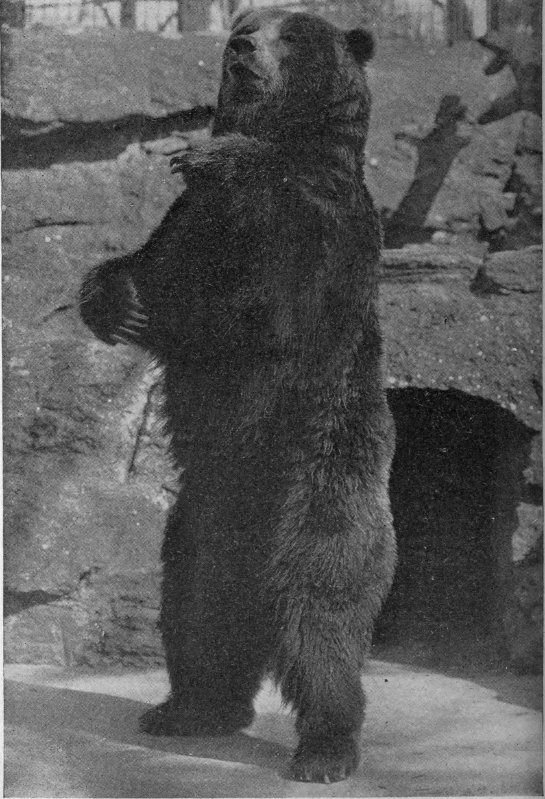
PENINSULA BEAR: IVAN
By WILLIAM T. HORNADAY, Sc.D.
Director and General Curator
ILLUSTRATED BY ELWIN R. SANBORN
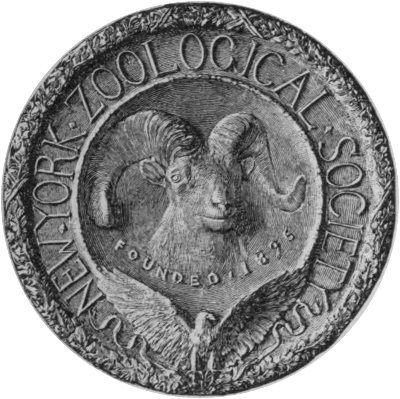
GORILLA EDITION
WITH MAPS, PLANS AND ILLUSTRATIONS
THIRTEENTH EDITION—SEPTEMBER, 1915
PUBLISHED BY THE
NEW YORK ZOOLOGICAL SOCIETY
11 WALL STREET, NEW YORK
Only Authorized Guide Price 25 Cents
COMPLETELY REVISED AND EXTENDED
| 1st | Edition, | October, | 1899— | 5000 |
| 2d | “ | May, | 1900— | 5000 |
| 3d | “ | December, | 1900— | 5000 |
| 4th | “ | October, | 1901— | 3000 |
| 5th | “ | June, | 1902— | 10000 |
| 6th | “ | “ | 1903— | 10000 |
| 7th | “ | “ | 1904— | 15000 |
| 8th | “ | “ | 1906— | 7000 |
| 9th | “ | “ | 1907— | 30000 |
| 10th | “ | October, | 1909— | 30000 |
| 11th | “ | June, | 1911— | 30000 |
| 12th | “ | “ | 1913— | 40000 |
| 13th | “ | September, | 1915— | 20000 |
Copyright, 1899, 1900, 1901, 1902, 1903, 1904, 1906, 1907, 1909, 1911, 1913 and 1915.
NEW YORK ZOOLOGICAL SOCIETY
The publication of this revised and extended edition of the Guide to the Zoological Park is necessary in order to bring our most important collections down to date. With the completion of the Zebra House and Eagle Aviary, we are now able to offer a Guide Book to the Zoological Park as practically finished.
The visitor is not to understand, however, that with the completion of the features named above nothing more will remain to be done. An institution of this kind never reaches a state of absolute completion, with no further possibilities of improvement. But the building of boundary walls, and the rebuilding of temporary entrances, are matters of small moment in comparison with the completion of a grand series of installations for animals, and buildings for public comfort.
Few indeed are the persons who know, or who ever will know, the extent to which both the general design and the details of the Zoological Park have been originated, and hammered out of the raw materials. From the inception of the undertaking, the work of development has involved a continuous struggle to meet new conditions. Although precedents and models for things to be done were sought far and wide, in all save a very few instances, our needs were so peculiar, and so different from those of other zoological gardens and parks, we have found really very little that we could copy. The abundant-room idea on which the Zoological Park was founded, and our desire for the full utilization of the works of nature, have from the first taxed the creative faculties of the Society to the utmost.
It has been gratifying to find in other zoological establishments a number of features which we could utilize here, thereby saving ourselves something in the eternal grind of invention and experiment, and we have gladly made prominent mention of such cases.
While it is possible to complete the equipment of animal installations for a Zoological Park, and fill them with fine collections, the demand for more animals is continuous. Our wild creatures are not immortal; and, like human beings, they live out their allotted lives and pass away. The great majority do not perpetuate themselves in captivity, 6 and the depleted ranks must be filled by new gifts and new purchases. Gifts of specimens, and funds for purchases, must constantly be forthcoming.
In the acquisition of certain representative species of great variety but particular desirability, the Society has been much favored by its friends, both at home and abroad. Frequently it happens that the greatest zoological rarities are obtainable only through the good will and tireless industry of friends who travel into the most remote and inaccessible regions of the earth. It is to such sources that we owe our musk-ox herd, walrus, mountain goat herd, spectacled bear and many other species.
The Executive Committee makes grateful acknowledgment of the loyal and generous support it has constantly received from the Board of Managers, the members of the Zoological Society, and from the Government of the City of New York. Thanks to a judicious union of these forces, the development of the Zoological Park has gone forward rapidly and satisfactorily. Although the actual period of construction has been remarkably short for so vast an undertaking, everything constructed is of the most permanent character. It is only just to note the fact that while the Zoological Park is an institution of national interest and importance, and free to all the world, with the exception of a few gifts of animals it has been created and is maintained wholly by the citizens of the City of New York. The State has contributed nothing.
The Executive Committee.
JUNE 1, 1913.
| January, 1915. | |
|---|---|
| Final plan of the Zoological Park approved by Park Board, November 22, 1897. | |
| Zoological Society assumed control of grounds, July 1, 1898. | |
| First building begun, August 11, 1898. | |
| Park formally opened to the public, November 9, 1899. | |
| Administration and Service Buildings | 2 |
| Large Animal Buildings (all heated) | 14 |
| Small Animal Buildings (4 heated) | 10 |
| Large Groups of Outdoor Dens, Aviaries and Corrals | 13 |
| Animal Storehouses, for winter use | 3 |
| Restaurants | 2 |
| Public-Comfort Buildings | 6 |
| Entrances | 7 |
| Area of Park Land and Water | 264 acres |
| Area of Water | 30 acres |
| Walks and Roads | 7.78 miles |
| Fences | 10.55 miles |
| LIVE ANIMALS IN THE COLLECTIONS. | ||||
|---|---|---|---|---|
| January, 1915. | ||||
| Mammals | 204 | species, | 586 | specimens. |
| Birds | 811 | “ | 2,753 | “ |
| Reptiles | 164 | “ | 1,014 | “ |
| Total | 1,179 | 4,353 | ||
| Attendance of visitors in 1914 | 2,020,433 |
| Total attendance of visitors from 1899 to Jan., 1915 | 19,325,590 |
President,
HENRY FAIRFIELD OSBORN.
MADISON GRANT, Secretary, 11 Wall Street.
PERCY R. PYNE, Treasurer, 30 Pine Street.
Executive Committee
MADISON GRANT, Chairman.
PERCY R. PYNE,
WATSON B. DICKERMAN,
SAMUEL THORNE,
WM. PIERSON HAMILTON,
WILLIAM WHITE NILES,
FRANK K. STURGIS,
LISPENARD STEWART,
HENRY FAIRFIELD OSBORN, ex-officio.
| General Officers | |
| WILLIAM T. HORNADAY, Director | |
| H. J. SHORTER | Assistant Secretary |
| R. L. CERERO | Assistant to Treasurer |
| DR. GEORGE S. HUNTINGTON | Prosector |
| C. GRANT LA FARGE | Architect |
| H. DeB. PARSONS | Consulting Engineer |
| Officers of the Zoological Park. | |
| WILLIAM T. HORNADAY, Sc.D. | |
| Director and General Curator. | |
| H. R. MITCHELL | Chief Clerk and Disbursing Officer |
| R. L. DITMARS | Curator of Reptiles, Asst. Curator of Mammals |
| C. WILLIAM BEEBE | Curator of Birds |
| LEE S. CRANDALL | Assistant Curator of Birds |
| W. REID BLAIR, D.V.S. | Veterinarian |
| H. W. MERKEL | Chief Forester and Constructor |
| ELWIN R. SANBORN | Editor and Photographer |
| GEORGE M. BEERBOWER | Civil Engineer |
| WILLIAM MITCHELL | Cashier |
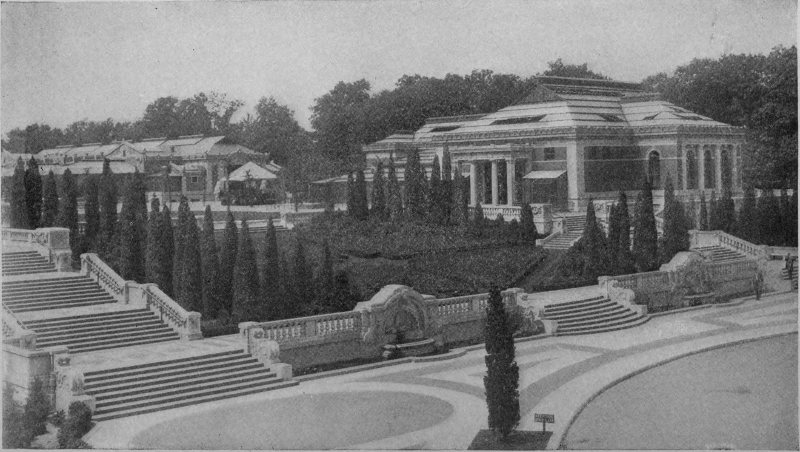
ITALIAN GARDEN, BAIRD COURT,
The structure on the right is the Large Bird-House, and in the distance, the Lion House.
Origin.—The New York Zoological Park originated with the New York Zoological Society, a scientific body incorporated in 1895, under a special charter granted by the Legislature of the State of New York. The declared objects of the Society are three in number—“A public Zoological Park; the preservation of our native animals; the promotion of zoology.” The Society has enrolled among its various classes over 2,000 members.
Henry Fairfield Osborn is the President of the Society. The affairs of the Society are managed by a Board of Managers of thirty-six persons, which meets three times each year. The planning and general development of the Zoological Society is in the hands of an Executive Committee of eight members, as follows: Madison Grant, Chairman; Percy R. Pyne, Samuel Thorne, William White Niles, Watson B. Dickerman, Wm. Pierson Hamilton, Frank K. Sturgis, Lispenard Stewart and Henry Fairfield Osborn, ex-officio. Madison Grant, the Chairman of the Executive Committee, is also Secretary of the Society, and his office is at No. 11 Wall Street. Dr. William T. Hornaday is the Director and General Curator of the Zoological Park, and his office is now located in the Administration Building on Baird Court. The address is 185th Street and Southern Boulevard. The Society assumed control of the grounds on July 1, 1898, and began the first excavation, for the Bird House, on August 11th. The Park Department began work, on the Wild-Fowl Pond, on August 29, 1898.
Sources of Income.—The funds devoted to the development of the Zoological Park have been derived from the following sources:
1. From the Zoological Society, obtained by subscriptions from private citizens—funds for plans, for the erection of buildings, aviaries, dens and other accommodations for animals; and for the purchase of animals.
2. From the City of New York—by vote of the Board of Estimate and Apportionment—funds for the construction of walks, roads, sewers and drainage, water supply, public comfort buildings, entrances, grading, excavating of large ponds and lakes, annual maintenance, and also for animal buildings.

SKETCH MAP SHOWING LOCATION OF ZOOLOGICAL PARK.
The Zoological Society has expended, of its own funds, for plans, construction and live animals, over $641,000. This sum has been derived from its special subscription fund, and from the annual dues and fees of its members.
Privileges.—Because of the fact that the Zoological Society has undertaken to furnish all the animals for the Zoological Park, the City of New York has agreed that all the revenue-producing privileges of the Park shall be controlled by the Society. All net profits derived from the restaurants, boats, refreshments, riding animals, the sale of photographs, books, etc., and all admission fees, are expended by the Society in the purchase of animals for the Park. It is well that visitors should know that all net profits realized in the Park go directly toward the increase of the animal collections.
The Society maintains a supply of boats for hire, and riding animals of various kinds for the amusement of children.
Location.—The Zoological Park is the geographical center of that portion of Greater New York now known as Bronx County. From east to west it is half-way between the Hudson River and Long Island Sound, and from north to south it is midway between the mouth of the Harlem River and Mount Vernon. From the City Hall to the Reptile House the distance is eleven miles. The distance by automobile from the Central Park Plaza to the Concourse Entrance is 9½ miles. The Northwest Entrance is about half a mile from Fordham station on the Harlem Railway.
The area of the Park is 264 acres, divided as follows:
| Land area west of the Boston Road | 150 | acres. |
| Land area east of the Boston Road | 80 | “ |
| Bronx Lake | 25 | “ |
| Lake Agassiz | 5½ | “ |
| Aquatic Mammals’ Pond, Cope Lake and Beaver Pond | 3½ | “ |
| Total area | 264 | acres. |

SKETCH MAP OF THE ZOOLOGICAL PARK AND VICINITY.
Via the Subway, to the Boston Road Entrance.—The terminus of the eastern branch of the Subway, at “180th St., Zoological Park,” lands visitors at the southeastern entrances to the Zoological Park, at West Farms. Visitors from points below 96th Street must be careful to board the “Bronx Park” trains, and not the “Broadway” trains.
Routes for Automobiles or Carriages.—Via Central Park, Lenox Avenue, Macomb’s Dam Bridge and Jerome Avenue or Grand Concourse to Pelham Avenue, thence eastward to the Concourse Entrance, where motor cars and carriages are admitted to the Park.
Via the Third Avenue Elevated.—The Third Avenue Elevated Railway has been extended to Bedford Park, and visitors coming to the Zoological Park on it or on the Harlem Railroad should alight at Fordham Station, from which the northwest entrance is half a mile distant, due eastward, on Pelham Avenue, via the Union Railway surface cars.
Surface Cars.—The Southern Boulevard and the Zoological Park Cars of the Union Railway now run to both the Crotona (Southwest) Entrance and the Fordham Entrance. The Crosstown cars of the same line intersect the Southern Boulevard three blocks south of the Crotona Entrance.
Free Admission.—On all holidays, and on Sunday, Tuesday, Wednesday, Friday and Saturday, the Zoological Park is open free to the public.
Pay Admission.—On every Monday and Thursday, save when either of those days falls on a holiday, all members of the Zoological Society who surrender coupons from their membership tickets, and all other persons holding tickets from the Society, will be admitted free. All other persons seeking admission will be admitted on payment of twenty-five cents for each adult, and fifteen cents for each child under twelve years of age. Tickets are sold only at the entrance gates.
Holidays on Pay Days.—Whenever a legal holiday falls on a Monday or Thursday, admission to the Park will be free on that day.
Hours for Opening and Closing.—From May 1st to November 1st the gates will be opened at 9 A. M. daily, and closed half an hour before sunset. From November 1st to May 1st the gates will open at 10 A. M.
Entrances, Walks, etc.—The portion of the Zoological Park situated west of the Boston Road has been enclosed. Access to this area is provided by six entrances, one situated at each corner—one on the Boston Road and one at the bridge on Pelham Avenue. The latter is a carriage entrance for visitors wishing to drive to the north end of Baird Court. From all these entrances broad walks lead into the Park and through it, reaching all the collections of animals now installed.
Carriage Roads.—The only wagon road which enters the central portion of the Park now occupied by animals is the Service Road, which enters from the Southern Boulevard, at 185th Street, and runs eastward, to the Service Building, Reptile House, Bear Dens, and Rocking Stone Restaurant.
This road is for business purposes only, and is not open for the vehicles of visitors. It is utterly impossible to admit carriages to the center of the Park, save those of officers entering on business, and visitors must not ask for exceptions to this very necessary rule.
Automobile and Carriage Entrance.—A fine public carriage road and concourse, leading from Pelham Avenue Bridge and to the upper end of Baird Court, was completed in 1908. This drive is open to carriages or motors, daily, and it affords easy access to the most important group of buildings. It is subject to the same regulations as all other entrances, except that carriages and automobiles are admitted.
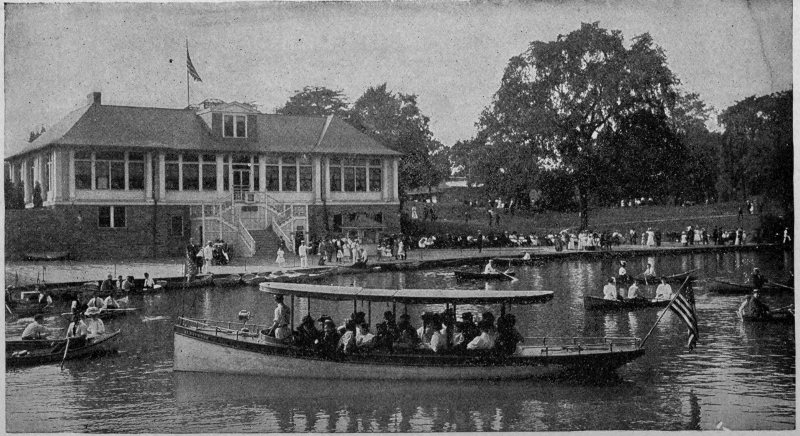
THE BOAT HOUSE, BRONX LAKE.
The Boston Road, which runs through the Park from south to north, near the western bank of the Bronx Lake, is open at all hours. It has recently—and for the first time—been finely improved by the Park Department for the Borough of the Bronx, and a drive through it affords a fine view of the eastern side of the Buffalo Range, and the finest portion of the heavy forest of the Zoological Park.
As a matter of course, the ranges of the buffalo, antelope, deer, moose, and elk, are in full view from the Kingsbridge Road and Southern Boulevard, and the Zoological Society has planned that the view from those avenues shall be left open sufficiently that the herds may be seen to good advantage.
The Rocking Stone Restaurant, No. 46, has been designed to serve all the purposes that its name implies. It contains dining-rooms in which full meals may be obtained, lunch-rooms wherein choice food will be served at popular prices, and in the basement, toilet-rooms will be found.
The Service Building, No. 28.—Near the Reptile House, and at the geographical center of the enclosed grounds, is situated a building which contains the Bureau of Administration of the Zoological Park. Here will be found the offices of the Chief Clerk, several other Park officers, and the workshops and storerooms.
Children lost in the Park, and property lost or found, should be reported without delay at the Chief Clerk’s office in this building. The telephone call of the Zoological Park is 953 Tremont.
Wheeled Chairs.—By persons desiring them, wheeled chairs can always be obtained at the entrances, by applying to gatekeepers, or at the office of the Chief Clerk, in the Service Building. The cost is 25 cents per hour; with an attendant, 50 cents per hour.
Arrangement of Collections.—Inasmuch as the physical features of the Zoological Park grounds were important factors in locating the various collections of animals, a perfect zoological arrangement was impossible. The existing plan represents the limit of acceptable possibilities in grouping related animals.
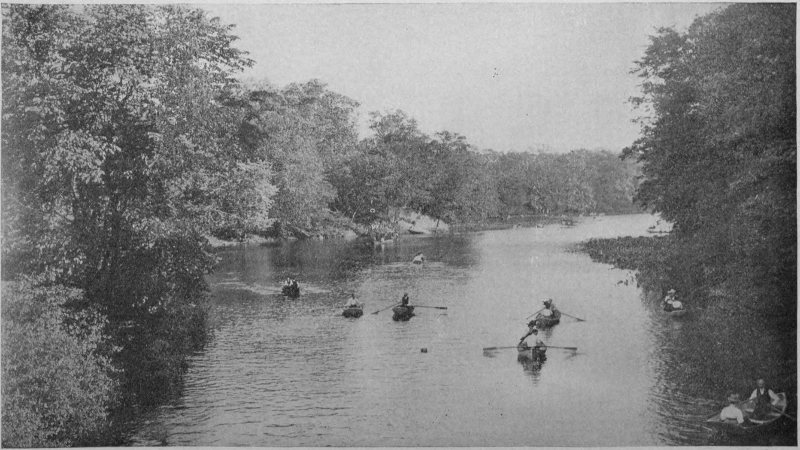
BOATING ON BRONX LAKE.
The entire southern and western sides of the Park are exclusively devoted to the Hoofed Animals, in addition to which other members of that Order will be found at the Elephant and Small-Mammal Houses. The Carnivorous Animals will be found at the Lion House, Wolf and Fox Dens, Small-Mammal House and Bear Dens. The Birds are in two groups; one in the lower end of Bird Valley, and the Large Bird-House on Baird Court; the other around the Wild-Fowl Pond, south of the Wolf Dens.
The existence of six entrances to the Park renders it impossible to lay out an all-embracing “tour” for the visitor, and develop the Guide Book accordingly. The various collections will be handled in zoological groups, but the various groups cannot follow each other in zoological sequence. The table of contents and a comprehensive index will render each item of the subject matter quickly available.
The extreme length of the Park from north to south is 4,950 feet, or 330 feet less than one mile; and its extreme width is 3,120 feet, or three-fifths of a mile. Roughly estimated, one-third of the land area is covered by heavy forest, one-third by open forest, and the remaining third consists of open meadows and glades. The highest point of land in the Park is the crest of Rocking Stone Hill, the elevation of which is 94.8 feet above sea level.
Topography.—Speaking broadly, the Zoological Park is composed of granite ridges running from north to south. In many places their crests have been denuded of earth by the great glacier which once pushed its edge as far south as New York City. In the valleys lying between these glacier-scraped ridges, great quantities of sandy, micaceous soil have been deposited; but in one spot—the Wild-Fowl Pond—what was once a green, glacial lake fifteen feet deep, presently became a vast rock-walled silo filled with vegetable matter and a trembling bog of peat. Everywhere in the Park glacial boulders of rough granite or smoothly rounded trap-rock, varying in size from a cobble-stone to the thirty-ton Rocking Stone, have been dropped just where the warm southern sun freed them from the ice. The Park contains thousands of them, many of which have been removed from walks and building sites only with great labor.
In three of the four principal valleys of the Park, bogs have been converted into ponds, and in the largest and deepest of all lie Bronx Lake and Lake Agassiz. The bed-rock underlying or cropping out in the Park exhibits pink granite, gray granite, rotten gneiss, and quartz in bewildering variety. Occasionally in trench-digging a ledge is encountered which yields good building-stone for rough work, but usually our rock is so full of mica as to be worthless.
The water-levels in the various portions of the Park are as follows:
| Above Sea Level. | ||
|---|---|---|
| Surface of Bronx Lake | 20.40 | feet |
| Surface of Lake Agassiz | 31.70 | “ |
| Surface of Cope Lake and Duck Ponds | 47.00 | “ |
| Surface of Wild-Fowl Pond | 65.00 | “ |
| Surface of Beaver Pond | 44.00 | “ |
The floor levels of some of the important buildings are as follows:
| Above Sea Level. | ||
|---|---|---|
| Of the Antelope House | 88 | feet |
| Of the Reptile House | 78 | “ |
| Of the Lion House | 64 | “ |
| Of the Aquatic-Bird House | 57 | “ |
Soil.—The soil varies from rich black muck in the valleys, to light and very dry soil, full of mica and sand, on the ridges and meadows. Where not packed hard, the latter is very porous, and the heaviest rainfall is quickly absorbed, or carried away on the surface. As a result, the valleys are always moist and rich in grass, and the slopes and ridges are always dry and warm.
Streams and Ponds.—The Zoological Park contains about 34 acres of still water, of which Bronx Lake comprises 25 acres, Lake Agassiz 5½ acres, Cope Lake, the Wild-Fowl Pond, and Beaver Pond together, about 3½ acres. The two larger lakes are fed by the Bronx River, which drains a valley about 15 miles long. Even in the driest seasons the volume of water carried down by the Bronx River is sufficient to keep the lakes well filled. The areas of still water available for animal collections are very generous for an institution like this, and are highly prized.
The Waterfall.—At the lower end of Lake Agassiz, and about 300 feet above the Boston Road Bridge, is a natural waterfall nearly 12 feet in height, where the Bronx River falls over a rugged ledge of pink granite. In times of high 23 water the foaming flood that thunders over the rocks makes an imposing spectacle, and it constitutes a most unusual feature to be found in a city park. During the year 1901, an improvement was made which added very greatly to the beauty of this feature by extending the rock ledge about 200 feet farther, to the rocky side of Wilson Hill, thereby greatly increasing the water area of Lake Agassiz, and at the same time forming a beautiful island.
Forests.—The crowning glory of the Zoological Park is the magnificent forest growth which covers, thickly or sparsely, about two-thirds of its land area. It consists chiefly of white, scarlet, black, red and pin oaks, tulip, sweet gum, hickory, beech, sassafras, maple, wild cherry, hornbeam, dogwood, tupelo, hemlock and cedar; but there are at least thirty other species of trees and shrubs. Thanks to the wise foresight and broad views of David and Philip Lydig, who for about eighty years were the sole owners of nearly the whole of the Zoological Park site, the virgin forest was not cut down for firewood or lumber, but was carefully preserved for posterity. As the legal custodian of this splendid domain of Nature, the Zoological Society is as rapidly as possible going over the entire forest, to arrest decay and death, and take all needed measures for the preservation of the trees. It is safe to say that nowhere else within fifty miles of New York can there be found any more beautiful forests than those in the central and eastern portions of the Park. Throughout the enclosed grounds, it is absolutely necessary that visitors should be restricted to the walks; for otherwise the feet of our millions of visitors would quickly destroy every ground plant.
The Rocking Stone, No. 45, a colossal cube of pinkish granite, poised on one of its angles on a smooth pedestal of rock, is the Zoological Park’s most interesting souvenir of the glacial epoch. Across the bare face of the rocky hill in which lies the Crocodile Pool, there are several glacial scratches pointing directly toward the famous boulder; and who will say it had no part in making one of them?
The Rocking Stone stands on a smooth table of granite on the southern shoulder of the hill overlooking the Buffalo Range. Its extreme height is 7 feet 6 inches; breadth, 10 feet 1 inch; thickness, 8 feet 1 inch, and its weight, as roughly calculated, is 30 tons. A pressure of about 50 lbs. exerted on the most northern angle of the stone causes its apex to swing north and south about two inches.
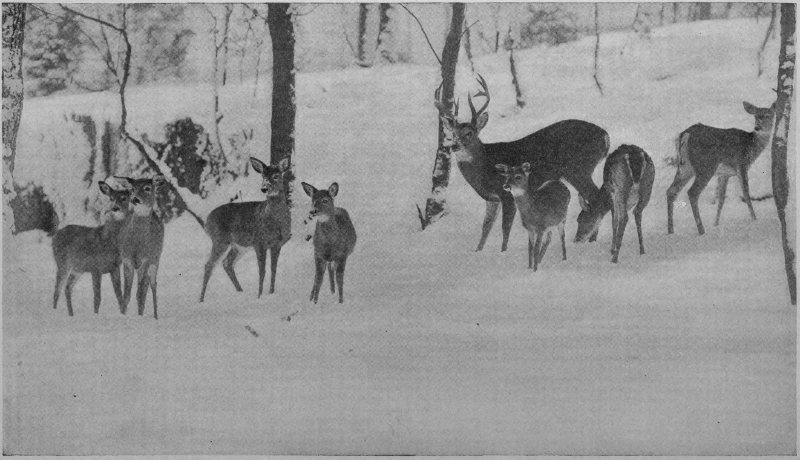
WHITE TAILED DEER.
The forming of a collection which shall fairly represent the hoofed animals of the world is necessarily a work of years. It is now (in 1915) fifteen years since the Zoological Society entered upon this task, and during that period the work of providing installations and living specimens has been pursued with unflagging industry. In no feature of our development has the Society been more liberal than in the purchase of specimens for this collection, and the gifts to it have been both numerous and valuable. In our 82 species and 330 specimens we feel that the Order Ungulata is strongly represented. On April 1, 1913, the summary of groups stood as follows:
| Summary of the Ungulates. | ||||
|---|---|---|---|---|
| Deer | 24 | species | 164 | specimens |
| Giraffes | 1 | “ | 2 | “ |
| Bovines: Bison, etc. | 3 | “ | 38 | “ |
| Musk Ox | 1 | “ | 6 | “ |
| Wild Sheep, Goats, etc. | 8 | “ | 41 | “ |
| Antelopes | 22 | “ | 41 | “ |
| Hippopotamus | 2 | “ | 4 | “ |
| Wild Swine | 3 | “ | 5 | “ |
| Camels and Cameloids | 5 | “ | 10 | “ |
| Rhinoceros | 2 | “ | 2 | “ |
| Tapirs | 2 | “ | 3 | “ |
| Wild Equines | 6 | “ | 9 | “ |
| Elephants | 3 | “ | 5 | “ |
| Total | 82 | “ | 330 | “ |
The arrangement of this section of the Guide Book begins at the Buffalo Entrance with the Bisons, and follows the ranges, corrals and buildings for Hoofed Animals, along the southern and western sides of the Park, to the Axis Deer Range. The Elephant House is introduced as the visitor leaves Baird Court, going south.
The large, open pastures are called “ranges,” and the smaller fenced enclosures are known as “corrals.” The fences are chiefly of hard steel wire, so strong and elastic that the animals cannot break through them.
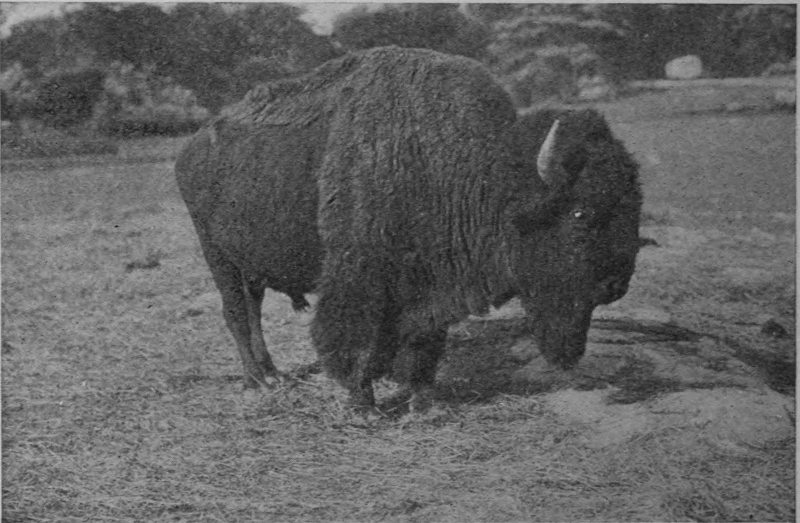
AMERICAN BISON: BULL.
Warning.—Visitors must never stand close beside a wire fence or gate, because its elasticity between posts might enable a charging animal to strike a person so standing and inflict a serious injury, even though the fence or gate is not in the least affected by the blow.
Stretching from the Boston Road to the large Antelope House (No. 50), and from the Rocking Stone to the southern boundary, lies an open expanse of rolling meadow land, with a total area of about twenty acres. It is almost surrounded by shade-trees. Its easterly edge is a low-lying strip of rich meadow, which lies under the shelter of the rocky, tree-covered ridge that forms the natural retaining wall of the higher plateau toward the west. This is the Bison Range. It is the first enclosure seen on the left as the visitor enters the Park from West Farms by way of the Boston Road.
On the north side of the main range, near the Rocking Stone, are the four corrals, and the Bison House. The latter is a rustic hillside barn, eighty feet in length, with a semicircular front, affording shelter and feed storage for thirty-four buffaloes. The flat roof of the Buffalo House is open to the public from the main walk, and has been specially designed as a convenient lookout over the main range 27 and corrals. There are other corrals, and a shelter shed, at the Buffalo Entrance.
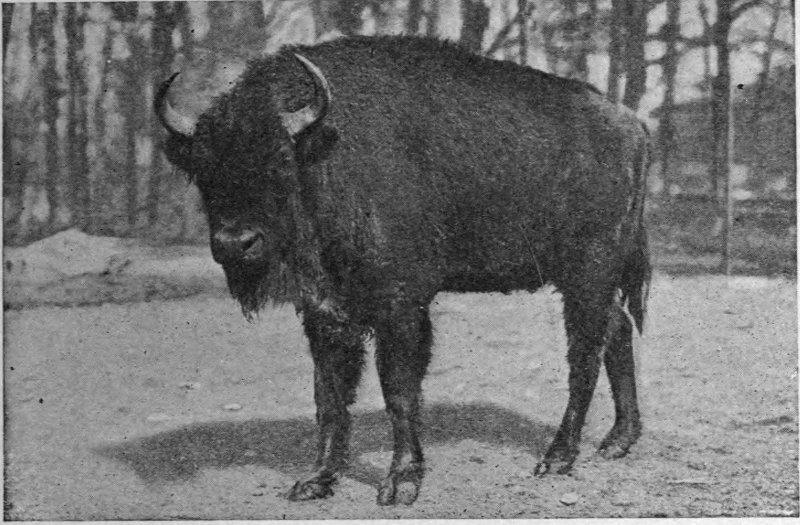
EUROPEAN BISON: BULL.
The American Bison, or Buffalo, (B. americanus), is the largest and the best known of all North American hoofed animals. What was once the universal herd, which occupied the whole pasture region of the West, was cut in twain in 1867, by the building of the first trans-continental railway. The great “southern herd,” of several millions of animals, was destroyed by skin hunters during the years 1871, 1872, 1873, and 1874, and the practical extinction of the northern herd was accomplished between 1880 and 1884.
At present there are but two herds of wild bison in existence. The largest band, now containing by estimate about 300 individuals, inhabits a wide stretch of barren and inhospitable territory southwest of Great Slave Lake. About twenty head remain in the Yellowstone Park, more than nine-tenths of the original herd having been slaughtered by poachers since 1890. There are now about 2000 bison alive in captivity, chiefly in large private game preserves.
Usually bison calves are born in May, June, and July. Full maturity is not reached until the end of the seventh year, when the horns of the male—at first a straight spike—have attained their full semi-circular curve. Like all thick-haired animals of the temperate zone, the American bison 28 sheds its coat in spring, and does not regain full pelage until October or November.
The bison breeds in confinement about as readily as domestic cattle. In appearance, it is the most imposing of all bovine animals, and with two exceptions it is also the largest. In captivity its disposition is mild, though inclined to stubbornness. Occasionally, however, an old bull becomes so vicious that it is necessary to seclude him from the herd, and treat him as a dangerous animal.
With the exception of a very few individuals, our entire bison herd is the gift of the late William C. Whitney, and the increase therefrom. The total number of head on hand on April 1, 1913, was forty-two.
In 1906, the New York Zoological Society presented to the United States Government a herd of fifteen bison to serve as a nucleus for an independent National herd. The Government very promptly fenced an area of twelve square miles of fine grazing grounds in the Wichita Forest and Game Reserve, for the proper reception of the herd. The plan was consummated during 1907. The effort has proven completely successful, and on April 1, 1913, the herd contained thirty-seven bison, all in fine condition.
European Bison.—In a corral adjoining the Buffalo Entrance, on the Boston Road, are to be found two specimens of the rare and almost extinct European Bison, (Bos bonasus). This species is the nearest living relative of the American bison, and the two specimens (male and female), now exhibited, came quite unexpectedly into the possession of the Zoological Society in April, 1904. They were acquired from the small captive herd in the forest of the Prince of Pless, in Silesia, south-eastern Germany, and are the first living specimens of the species to be exhibited in America. They were presented to the Society by Mr. Norman James, of Baltimore, Mr. Charles Sheldon and Dr. Leonard J. Sanford.
The distinguishing characters of this species are shorter and less abundant hair on the head, neck and shoulders than our bison, a tail densely covered with hair throughout its length, very long legs, and a short body.
But for royal protection, this species would long ere this have become extinct. In the year 1857, about 1,898 head were living, but in 1892 the total had decreased to 491. It 29 appears, however, that an increase can safely be announced. An estimate recently published (1906) places the total number of wild and semi-wild individuals at 1,400, while in the captive herds of the Czar and the Prince of Pless there are 46 more. About 700 of the survivors inhabit the forests of Bielowitza and Swisslotsch, Lithuania, west Russia, and are strictly protected by the Czar. Other bands still exist on the northern slope of the Caucasus Mountains around the sources of the Laba and Bjellaja, sometimes ranging up to an elevation of 8,000 feet. Wherever found, they live in scattered bands of from three to ten individuals. All the survivors of this species are so jealously guarded that very few of the zoological gardens of Europe have been able to procure specimens.
This animal is very often miscalled the “aurochs,” and from this error much confusion has arisen. The true aurochs, (Bos primigenius), was the wild progenitor of some of the existing breeds of domestic cattle, but it is now extinct.
The wild sheep and goats of the world form an exceedingly interesting group of animals. In form they are odd and picturesque, and in temper and mentality they are everything that could be desired. All the year round, deer are either nervous or dangerous, and difficult to handle. Wild sheep, goats and ibex appreciate man’s interest in them, and even when not fond of attention, they act sensibly when it is necessary to handle them.
The Zoological Park collection of wild sheep and goats is one of the most interesting features of the Park. Mountain Sheep Hill is the first high ridge west of the Rocking Stone, and its northern end is very near the Bear Dens and Reptile House. It consists of a ridge of pink granite 500 feet long and 25 feet high, its southern end fully exposed, but the northern end well shaded by oaks and cedars. For grazing animals that love to climb, and pose on the sky line, the slopes of bare rock, set in patches of hard, green turf, are almost ideal. In the eastern face of the ridge, rock excavations have been made, and five roomy caves have been constructed in such a manner that they are cool in summer, warm in winter, and dry at all times. On April 1, 1913, the six wire enclosures on Mountain Sheep Hill contained the following species:
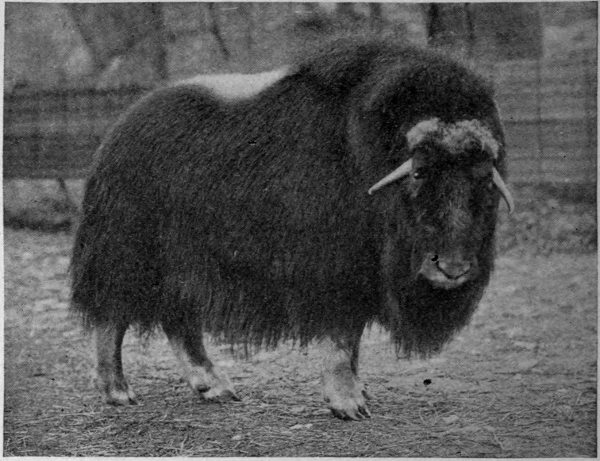
WHITE-FRONTED MUSK-OX.
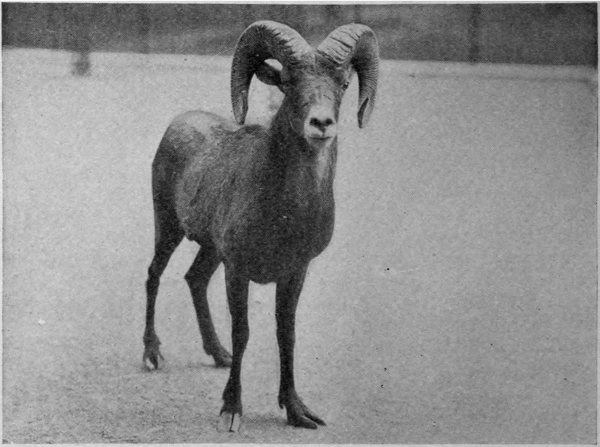
BIG-HORN MOUNTAIN SHEEP RAM.
Because of the curious (and unaccountable) fact that they do not thrive on Mountain Sheep Hill, the Rocky Mountain Goat and Chamois are exhibited elsewhere. The former will be found near the Pheasant Aviary, next to the Musk-ox.
Visitors are requested to make note of the fact that in winter, the Arcal Sheep, Mouflon, and other delicate sheep are exhibited in the Small-Deer House.
The White-Fronted Musk-Ox, (Ovibos wardi, Lydekker), is represented in the Park by a herd of six specimens. Five of these animals were born in May, 1910, in Ellesmere Land, and captured in that year by Paul J. Rainey and Harry C. Whitney, and presented by Mr. Rainey. The sixth individual, a vigorous and rather vicious female, was born on Melville Island, in May, 1909, and captured by Captain Joseph Bernier. Owing to the domineering temper of “Miss Melville,” it is not possible to keep her with the animals a year younger than herself, because she resents their presence in her corral.
The Musk-Ox is an animal of strange form, inhabiting a small portion of the Arctic regions of the western hemisphere, up to the very northernmost points of land east of the Mackenzie River. At Fort Conger (Latitude 81°, 40′), its flesh was a godsend to General Greely, and later on to Commander Peary, also. Structurally, this animal stands in a genus of its own (Ovibos), midway between the cattle and the sheep, but it is unqualifiedly a misnomer to call it a “musk-sheep.”
An adult male Musk-Ox stands 4 ft. 5 in. high at the shoulders and is 6 ft. 7 in. in total length. Our first specimen was a female, two years old. She stood 3 ft. 2 in. high at the shoulders, and was 4 ft. 10 in. in total length. Her entire body was covered by a dense mass of fine light brown hair, of a woolly nature, overlaid by a thatch of very long, straight hair specially designed to shed rain.
The Musk-Ox inhabits the Barren Grounds of northern Canada north of Latitude 64° from Great Bear Lake to Hudson Bay, Grant Land, and the northeast coast of Greenland from Franz Josef Fiord (Latitude 70°) to the most 32 northerly point of land. About twenty living specimens have been taken when very young at Franz Josef Fiord, by Swedish and Norwegian whaling parties. The Peary Arctic Club, of New York, presented to the New York Zoological Society a young calf which was captured by Commander Peary at Fort Conger, in 1902, but it lived only a few months.
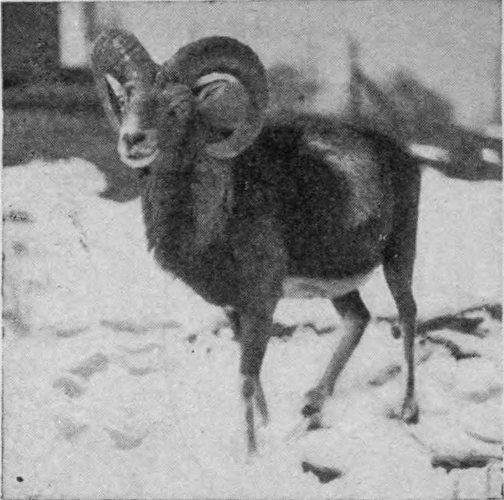
MOUFLON
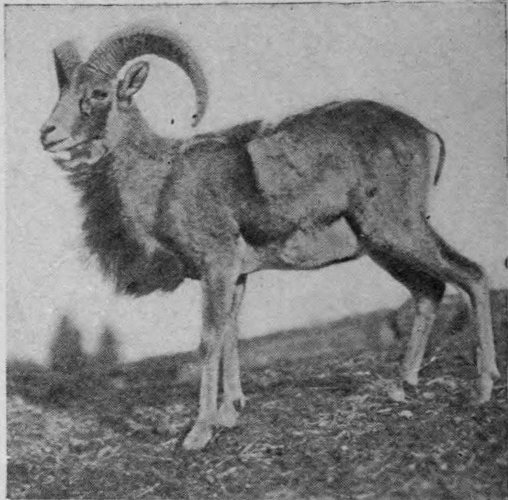
ARCAL SHEEP
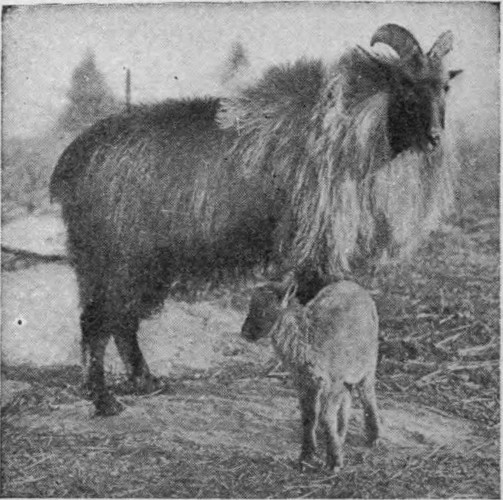
HIMALAYAN TAHR
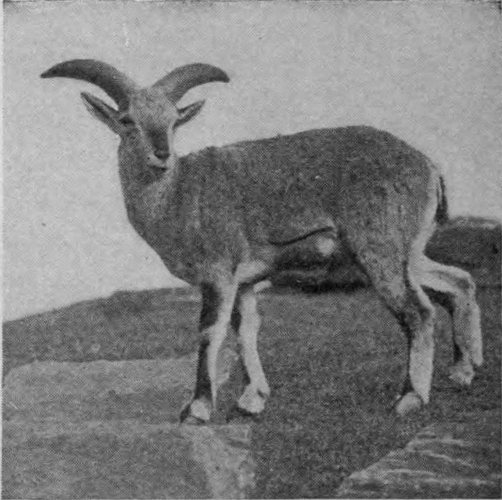
BURRHEL
The Big-Horn Mountain Sheep, (Ovis canadensis), is exhibited in the Zoological Park, whenever it may be obtained. The efforts that have been made in New York, Philadelphia, Washington and Chicago to acclimatize the Big-Horn of the Rocky Mountains have proven the extreme difficulty involved in keeping specimens of that species alive and in good condition anywhere in the Mississippi Valley, or on the Atlantic coast. The changes of atmosphere 33 and temperature seem more violent than American mountain sheep are fitted by nature to endure, and thus far all specimens tried have died within a comparatively few months.
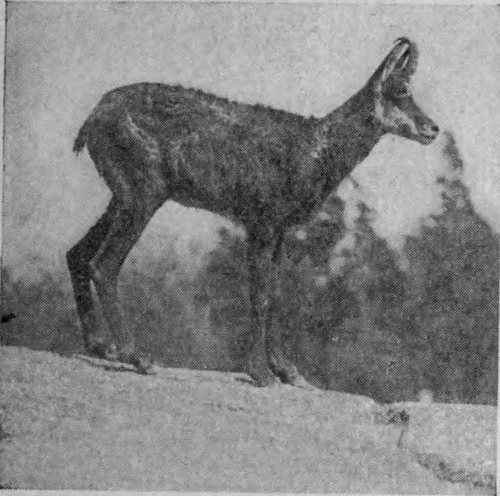
CHAMOIS
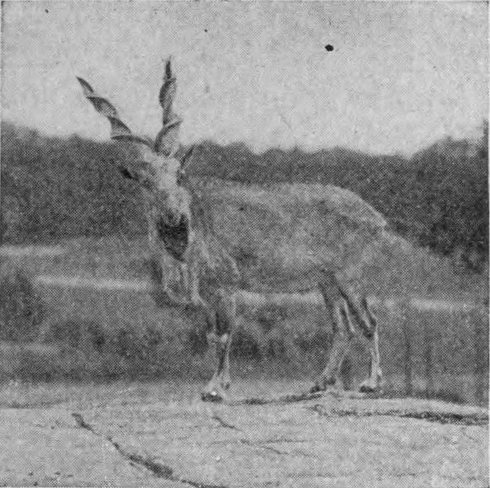
MARKHOR
In his own country, the Rocky Mountain Big-Horn is a bold, hardy and robust animal. He is high-headed, keen-sighted, and a sure-footed mountaineer. He dwells in the wildest and most picturesque country that he can find between the “bad-lands” of western North Dakota and the line of perpetual snow on the Rockies. His massive circling horns render his head a much-coveted trophy, and his flesh is most excellent food. A full-grown ram (Ovis canadensis) stands 41 inches in height at the shoulders, and weighs 316 pounds.
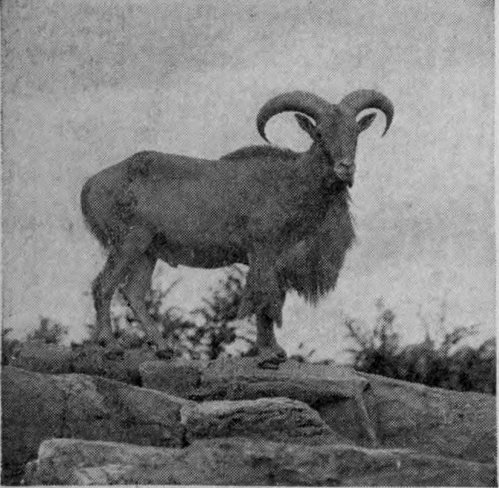
AOUDAD
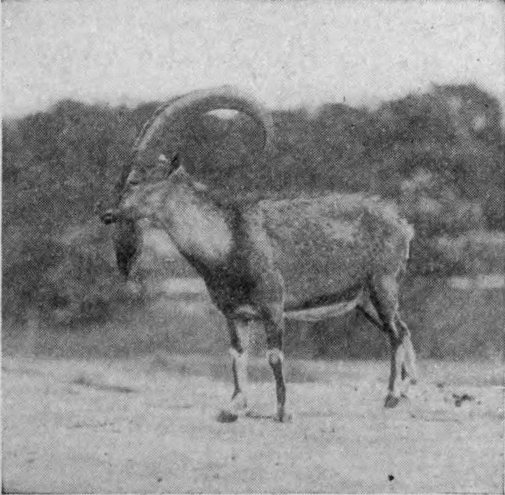
PERSIAN WILD GOAT
This species ranges from the northern states of Mexico to northern British Columbia and it culminates (i. e., 34 reaches its finest development) in southeastern British Columbia. In Northwest Alaska other related species occur. A female specimen from southeastern British Columbia was exhibited in the Zoological Park during 1905 and 1906, and in 1902, a male specimen of a closely related species (Ovis nelsoni) was also here.
As opportunities offer to procure male specimens, that have been kept in their home region until they are at least a year and a half old, they will be purchased and exhibited.
The Mouflon, (Ovis musimon), or Wild Sheep of Sardinia, is represented by a fine pair of specimens presented by Maurice Egerton, Esq., of London, and a young male born in the Park. The female of the adult pair was captured when a lamb in the mountains of Sardinia by Mr. Egerton. The ram of this species is handsomely colored, and this specimen is noted for his friendliness, and his fondness for admiration.
The Arcal Mountain Sheep, (Ovis cycloceros), is one of the smallest mountain sheep of India of the “big-horn” type (with circling horns). The fully adult male, with its long undermane of coarse, shaggy hair and proud postures, is a very noteworthy creature. This species inhabits the mountains of northern India, Tibet, Afghanistan, Beluchistan and southern Persia.
The Burrhel, or Blue Mountain Sheep, (Ovis burrhel), also of northern India, is of quite a different mould from the preceding species. Its countenance has almost a benign expression, and its curious out-pointing horns, of large size give it a most jaunty air. By some it is regarded as the most beautiful of all mountain sheep. In size, however, it is not imposing, for it is one of the smallest species. It is not so hardy as the preceding species, and there may be periods when there are no specimens on exhibition.
The Aoudad, or Barbary Wild Sheep, (Ovis tragelaphus), comes from the hot, dry mountains of northern Africa, and it endures the cold, wet climate of New York in a manner sufficient to put to shame our American mountain sheep, goat and other western ruminants. The largest male Aoudad of our herd is a very fine specimen of its kind. He is as fond of admiration as any peacock, and often poses in striking attitudes on the highest point of his rocks. He was born here on March 19, 1902.
The Himalayan Tahr, (Hemitragus jemlaicus), is really a wild goat, of very odd and picturesque aspect, native of 35 the higher ranges of the Himalayas of northern India. Its horns are short and thick, and its body is covered with long, purplish-brown hair which is much blown about by the wind. It dwells amongst the most dangerous crags and precipices, just below timber-line, and in reality is a forest-loving animal. Its hair is the longest to be found on any member of the two subfamilies of goats and goat-like animals. The pair on exhibition have bred here, and the young have been successfully reared to maturity. The young Tahr is very small, but remarkably nimble-footed and capable.
The Chamois, (Rupicapra tragus), has usually been represented in the hoofed-animal collection, but always out of its proper installation. Our individuals have not thriven on Mountain Sheep Hill, always becoming ill soon after being placed there. They thrive well, however, in a small wire pen with a sanded floor quite near the Puma and Lynx House (No. 33A), and there we keep them.
This animal is one of the rock antelopes, and is related to the American Mountain Goat. It is a bold mountaineer, and even to-day is pictorially represented as leaping “from crag to crag” across chasms apparently 200 feet wide! Its home is in the mountains of southern Europe, especially the Pyrenees, the Swiss Alps and the Caucasus Mountains. But it is not so exclusively a crag-dweller, as most persons have been led to suppose, for in many localities it inhabits mountain forests. Like most other mountain ungulates, the Chamois dwell high in summer, and in winter they seek lower and more sheltered situations. They are exceedingly wary and agile, and sure-footed on dangerous ground.
The Antelope House occupies a commanding situation on a high, tree-covered knoll at the south end of the Zoological Park. The situation seems as if specially formed by Nature to be occupied by this building, and its outside enclosures. The drainage is quite perfect, and the yards are well-shaded.
The building has been designed to meet the wants of giraffes and large African antelopes of all kinds, more especially those which require 60° of heat in winter.
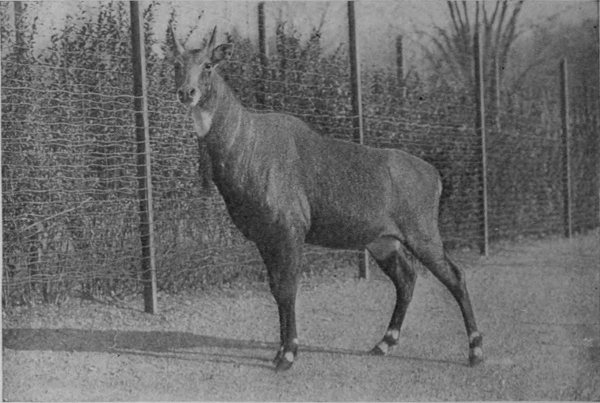
NILGAI: INDIAN ANTELOPE.
The Antelope House is 142 feet long by 78 feet in extreme width. In architectural style it conforms with the other large animal buildings of the Park. Both for visitors and for its animals, it is roomy and well lighted, and in every way fitted to house and display a large and valuable collection of tropical hoofed animals. It contains 24 interior compartments, directly connected with 23 open-air yards for use in mild weather. This building was completed and occupied on October 17, 1903, and with all its surrounding improvements has cost about $80,000.
As the visitor will observe from the following enumeration of species, our collection of large and rare African and Asiatic antelopes is very rich. Unfortunately, until the completion of the Zebra House releases the apartments now occupied by the equines, a number of species which belong in the Antelope House must temporarily be quartered elsewhere.
The Nubian or Three-Horned Giraffes, (Giraffa camelopardalis), are at present the most important and interesting animals in the building. The pair came from German East Africa, are now (April, 1913) about twelve years old, and cost $5,500. The male stands 14 feet 4 inches in height, and the female 12 feet 6 inches. Both are good-tempered 37 animals, and have been in good health ever since their arrival. Their food consists of clover hay, broken forage-biscuits, an assortment of raw vegetables carefully cut into small pieces, a small quantity of bran, and rock salt.
A study of the Giraffes reveals most interesting conditions. According to the point of view, the total number of species and subspecies may be reckoned at any number from three to six, inclusive. According to the specimens in hand, the Southern, or Two-Horned Giraffe, (Giraffa capensis), seems clearly defined from the Northern, or Three-Horned Giraffe, (G. camelopardalis). Next, the Somali Giraffe, (G. reticulata), of the Lake Rudolph region and northern British East Africa, seems fairly separable. At first the Five-Horned Giraffe, of western Uganda, seemed quite distinct, but now British naturalists hesitate about according to it rank as a separate species, because of its intergradation with the Nubian form, (camelopardalis).
Judging from all evidence now available, it seems that the Giraffes of to-day represent the midway stage of an effort to develop several species from the parent stock, the Three-Horned Giraffe, which is the species here represented. The existing forms, including all species and subspecies, intergrade and run together in a manner that is fairly bewildering; but if the Giraffes could remain uninfluenced by man for a sufficiently long period the probabilities are that the species now branching off would be clearly established.
The oldest, the best-known and the most common Giraffe is the three-horned species, found from central Uganda southward. The five-horned variety meets the former in Uganda, and occurs from that region westward to the edge of the great equatorial forest, and on westward even to Lake Tchad, and the lower Niger Valley. Excepting in Uganda, Kahma’s country, and a few other protected districts, the Giraffe is now rare, particularly throughout the regions that are accessible to hunters. Thousands of these wonderful creatures have been killed by hunters, both white and black, solely for the sake of seeing them dead, and leaving them as prey to the hyænas and hunting-dogs. It seems to be beyond the power of most men who can shoot to see living wild animals, no matter how large or wonderful, without desiring to reduce them to carcasses, fit only for scavengers.
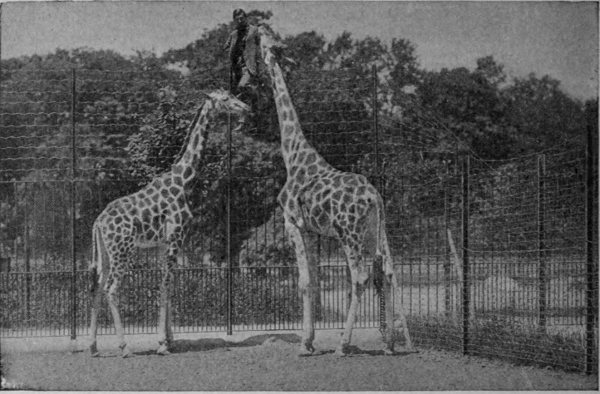
NUBIAN GIRAFFES.
The Eland, (Taurotragus oryx), is the largest and most imposing of all antelopes. As might be inferred from its great size, it is now so nearly extinct that it has almost disappeared from the lists of dealers in wild animals. The fine young pair now in the Antelope House was presented by the Duke of Bedford, from his famous animal collection at Woburn Park. The fully adult female is the gift of Mr. C. Ledyard Blair.
Of Elands there are two well-marked species. That of eastern and southern Africa, here represented, was once numerous on many of the fertile plains of the great plateau now known as Rhodesia, and in fact throughout nearly the whole of the uplands of eastern Africa, from the Cape to the Sahara. Unfortunately, however, white hunters and modern firearms have reduced the countless thousands of the great herds to numbers so small that the capture and exportation of Elands have practically ceased.
Although a number of Elands have been born in captivity, the number on public exhibition still remain very small. The only captive herd known to the writer is that of the Duke of Bedford, in Woburn Park, England, which is at once the admiration and envy of all collectors of living wild animals.
The White-Tailed Gnu, (Connochaetes gnu), once was abundant in South Africa, south of the Vaal River. But it has shared the fate of all the other large mammals of that 39 region, and only a few scattered bands still exist. Nearly all of the specimens now living in captivity were born in captivity, for both species of Gnu take kindly to life in parks and gardens.
Every way considered, the Gnu is an animal of odd and remarkable form. It has a nose of strange shape, its horns are curiously formed, the hair on its head and neck exhibits various peculiarities, and its hips are oddly modeled. Its long, flowing tail is so horse-like that for many years this animal was pictured and popularly known as the “Horned Horse.”
The White-Bearded Gnu, (Connochaetes albojubatus), is noticeably larger than the white-tailed species, and in some respects it presents a finer appearance. Its bulk is considerably greater, and its color is more pleasing. This species bears a strong resemblance to the third species, which is known as the Brindled or Blue Gnu, (Connochaetes taurinus), from which the former is distinguished by its white mane and jaw-tufts, and generally paler color. At wide intervals the White-Bearded species inhabits southern East Africa, from about S. Lat. 23°, to the Albert Nyanza and Lake Rudolph, but chiefly near the coast. In only one locality do we learn of its occurrence west of the 30th meridian. To-day it is most numerous in German East Africa and the southern portions of Uganda.
The Addax Antelope, (Addax naso-maculatus), is a spiral-horned antelope which inhabits the southern edge of the Sahara Desert from Dongola quite across Africa to Senegal. Its extremely broad and spreading hoofs betoken a dweller upon sand, and are strongly suggestive of the snow-shoe hoofs of the caribou. It is said that this animal is not to be taken without making a journey into the desert, with camels.
The Leucoryx Antelope, (Oryx leucoryx), is the only member of its genus which has curved horns. Because of the length and very slight curvature of the horns, this species has by some writers been spoken of as the Sabre Antelope, and by a mischievous perversion that name has been turned into “Sable” Antelope, which refers to a totally different creature, (Hippotragus niger). Anyone who places an order for the purchase of a real Sable Antelope, and receives a Leucoryx instead of Hippotragus niger, is profoundly disappointed.
This species is a desert habitant, and its home is the desert region of North Africa from Dongola to the Senegal country. 40 It is breeding regularly here, and the offspring mature successfully. The largest Leucoryx horns on record measure 39⅝ inches.
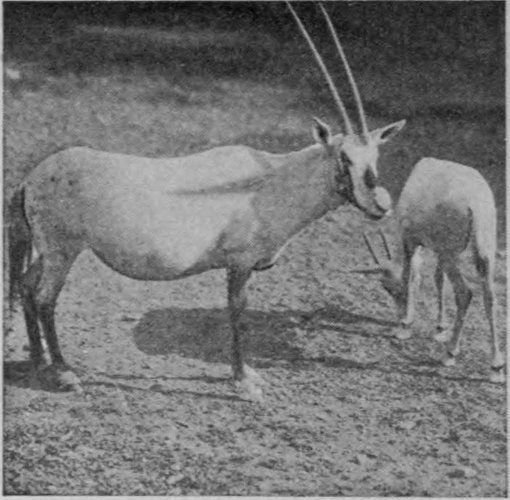
BEATRIX ANTELOPE
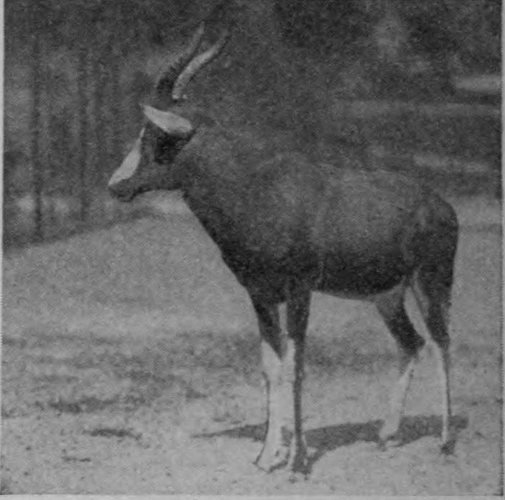
BLESSBOK
The Beisa Antelope, (Oryx beisa), is a good representative of the group of straight-horned antelopes found in the genus Oryx. Of all the long-horned species, the two Beisas and the Gemsbok of Africa, and the Beatrix of Arabia, are the only species possessed of horns that are practically straight from base to tip. The Gemsbok is the largest and most showy species, being painted like a harlequin, in a startling pattern of roan, black and white. The Beisa is a good second, however. The horns of all these antelopes grow to great length, and are excellent weapons for use in encounters with the smaller game-killing carnivores. The largest horns of record measure 40 inches.
The Beisa inhabits eastern Central Africa, from Suakin on the Red Sea southward to the Equator.
The Beatrix Antelope, (Oryx beatrix), of the Arabian Desert, is one of the rarest antelopes to be found in captivity, and at this date this interesting species is represented by a fine pair of specimens. The longest horns of record measure 26 inches. Very few sportsmen have seen this animal in its native haunts. Our pair has been breeding for three years, and has reared two young.
The Sable Antelope, (Hippotragus niger), is by many persons regarded as the handsomest of all the numerous species of African antelopes. In appearance it is very proud and high-headed; it has imposing horns that sweep backward in a semicircular curve; its large eyes and alert air betoken keen intelligence, and its glossy black coat, marked with pure 41 white, render it a most conspicuous animal. On its native veldt it has now become a very rare species, and seldom is taken by sportsmen. The fine male specimen in the Park was presented by Miss Jean Walker Simpson.
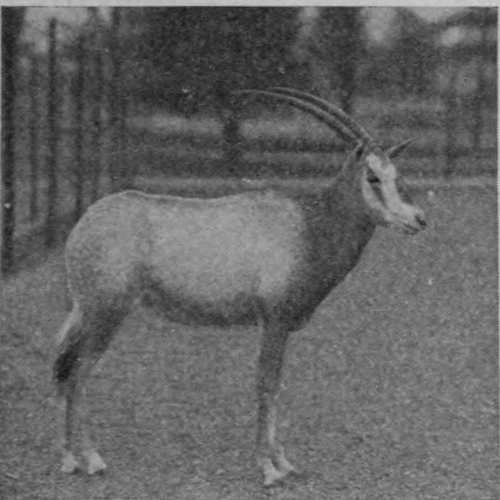
LEUCORYX ANTELOPE

WHITE-TAILED GNU
The Sing-Sing Waterbuck, (Cobus unctuosus), is a creature of the lowlands, and frequents the dense tangles of tall reeds that border many of the rivers of West Africa, above the great equatorial forest. In captivity it sometimes is one of the most insanely nervous and irrational creatures imaginable, ever seeking self-inflicted injuries.
The Blessbok, (Damaliscus albifrons), is a small but handsome purple-and-white antelope which is now very nearly extinct. Formerly a number of herds were preserved on fenced farms in the Transvaal and Orange Free State, but it is feared that none of them survived the Boer War. This species never lived north of the Limpopo, but south of that river it once was so numerous that a truthful traveler described a vast plain as being “purple with Blessbok.”
The Nilgai, (Portax tragocamelus), is the largest of the Indian antelopes, and while it has the stature and the high shoulders of a Baker roan antelope, its absurdly small horns give it, beside the large antelopes of Africa, a very commonplace and unfinished appearance. The males and females are as differently colored as if they belonged to different species. This animal inhabits the roughest portions of the central plains of Hindustan, from Mysore to the Himalayas. In northern India it is found along the rivers Jumna and Ganges, in rugged and barren tracts of ravines which in character and origin resemble our western “bad-lands.”
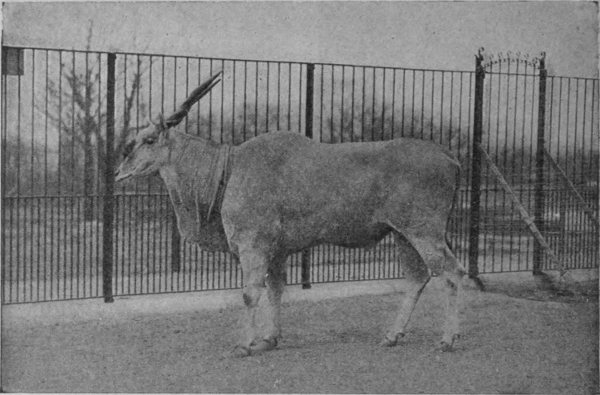
ELAND
The small antelopes will be found in the Small-Deer House, the next building in order.
In captivity the small and delicate species of deer, antelopes and gazelles are better cared for in enclosures that are not too large. For such creatures, freedom in a large enclosure usually means early death from accident or exposure.
The very important building called the Small-Deer House has been erected with special reference to the wants of the interesting little hoofed animals which are too small for the Antelope House and the large ranges. In winter it will shelter the small tropical mountain sheep and goats, which are unable to withstand the rigors of outdoor life on Mountain Sheep Hill, and the tropical swine may also be expected here.
The Small-Deer House is situated in close proximity to the Antelope House, and westward thereof. Of the buildings of secondary rank, it is one of the most satisfactory, being roomy, well-lighted and capable of comfortably housing and displaying a large and varied collection. The structure is 158 feet in length by 46 feet in width. It contains thirty compartments, each of which, under stress of necessity, 43 can be partitioned, and formed into two. The interior compartments are each 10 feet wide by 10 feet deep. The building is surrounded by a series of 34 corrals, connecting with the interior compartments, the average size of each being 75 feet long by 20 feet wide at the outer end. All the fences are of wire, and were specially designed in the Park for this installation.

SABLE ANTELOPE.
It is a practical impossibility to offer an enumeration of the living animals in this building which will permanently apply, and the best that can be attempted is an approximation. It is an inexorable law of Nature that the smallest animals shall have the shortest periods of life, and in a zoological park a small hoofed animal may be here to-day and gone to-morrow. In the following enumeration, mention will be made only of those species which are likely to remain longest on exhibition; and it may be observed that in this building there will be found various animals which are neither deer nor antelopes.
Osceola White-Tailed Deer, (Odocoileus virginianus osceola), is an interesting geographic race of the northern White-Tailed Deer which forms the parent stem of a group of six or seven subspecies. The robust and hardy northern type, often with large and strong antlers, gradually diminishes 44 in size and in antlers, until in Mexico it becomes a small and delicate creature, with very small and light antlers bearing only two or three small tines. The next form has so widely diverged from the original type that it is necessary to accord it rank as a full species.
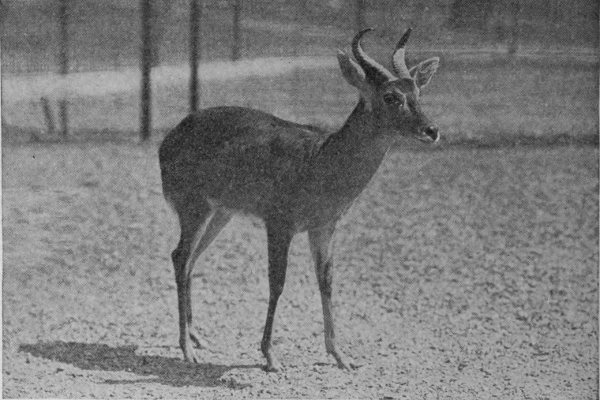
REDUNCA ANTELOPE.
The Sinaloa White-Tailed Deer, (Odocoileus sinaloae), is still smaller and weaker than the preceding. Our pair of specimens shown was obtained by Mr. and Mrs. C. William Beebe, in the State of Guadalajara, Mexico, and are highly interesting as a link near the lower terminus of the Odocoileus chain. On a majority of the antlers of this species there are no branches whatever, but simply a weak main beam, curving over at the tip, and terminating in a rounded point.
It should be noted here that the White-Tailed Deer group, (Odocoileus), is very well represented in South America by O. weigmanni of the Guianas.
The Marsh Deer, (Blastoceros paludosus), of eastern South America, is the largest South American deer. Our first specimen was obtained in 1904. Its antlers are strongly built but short, and in architecture resemble the antlers of a Siamese species known as Schomburgk Deer, (Cervus schomburgki); but the latter has on each beam three double bifurcations, while the former has but two. The Marsh Deer has very large, wide-spreading hoofs, which it would 45 seem have been developed by many generations of existence on soft ground. It inhabits the jungles along river banks, in Brazil. The head of this animal is of remarkable length.
This important species is rather weak in captivity, and it is by no means certain that it can constantly be exhibited here. There is another South American species, (Blastoceros campestris), which is a zoological understudy, or miniature, of the large Marsh Deer.
The Black-Faced Brocket, (Mazama tema), whenever it can be obtained, will represent a group of American deer which is as little known in the United States as if it inhabited the heart of Borneo. The Brockets are smaller than the Sinaloa white-tailed deer, and they are so nearly hornless that the antler is merely a small, straight, sharp-pointed spike of bone only three inches long. The adult animal is only 25 inches in shoulder height, which is about the size of the muntjac of India. Of the Brockets there are several species, mostly South American, but from skulls and horns received we now know that it is found as far north as the State of Puebla, Mexico. A correspondent in that locality is constantly endeavoring to secure specimens for us, and no doubt will shortly succeed. For the reason that we expect specimens in the near future, this species is included.
The Hog Deer, (Cervus porcinus), which is very unlike a hog, and is libeled by its name, is a small species from India, which is provided with long and well-shaped antlers having a total of six points. Sometimes the adult males are spotted in summer, and sometimes they are not. This species stands next to the beautiful axis deer. It breeds well in captivity, but is a very nervous and even hysterical animal.
The Molucca Deer, (Cervus moluccensis), is a thick-bodied, scantily-clad and coarse-haired understudy of the Malay sambar, (Cervus unicolor). Of all deer it is one of the least beautiful. Its hair resembles the bristles of a wild hog, and its color is a dull, raw-umber brown. It belongs to the sambar group of East Indian deer, and really marks, both geographically and in size, the farthest departure from the type species of the group.
The Muntjac or Rib-Faced Deer, (Cervus muntjac), is one of the most interesting of all species of small deer. In one respect it is unique. Its tiny antlers, which are only 4½ inches in length, are placed high up on stems of solid bone, which sometimes rise 3¾ inches clear of the cranium. 46 These pedicles of bone are covered with skin, quite up to the burr of the antler. The front angles of these pedicles are continued down the face to the nasal bones, and form the two sharply defined facial ridges which have given this creature one of its popular names.
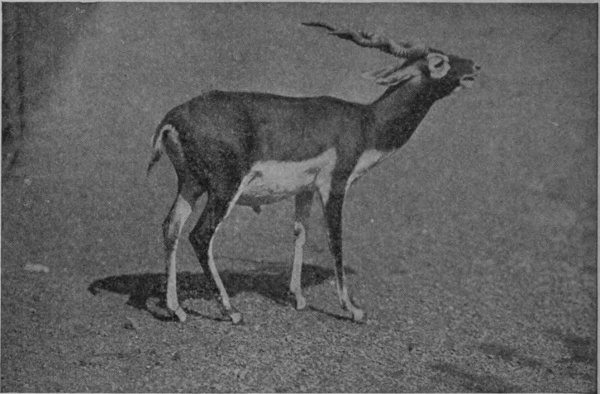
SASIN ANTELOPE.
In India the Muntjac inhabits the jungles of the tiger, the leopard, axis deer and sloth bear, and escapes from its numerous enemies by hiding behind logs, and scurrying through the thick underbush so swiftly that its pursuers can not keep it in view. Its flesh is most excellent food. From its peculiar, yapping cry, many times repeated, it is often called the Barking Deer. It breeds readily in captivity, and its bright fawn color attracts to it much attention.
The Musk Deer, (Moschus moschiferus), of northern India, Tibet and Southern China is the creature which produces the well-known musk perfume of commerce. The product is secreted by the male in the “rutting” season. This species is one of the smallest of the true deer. Its most remarkable anatomical feature is a pair of very long and sharp canine teeth in the upper jaw, the points of which project far below the lower jaw. No horns are present in this animal. Being short-lived in captivity, and also difficult to obtain, it must be classed as an intermittent exhibit.
In addition to the grand array of large antelopes inhabiting 47 Africa, of which many fine examples will be found in the Antelope House, there is an extensive series of small species. Indeed, the richness of Africa in antelopes, great and small, is almost beyond belief. The species of Asia and Europe are so few, and so inconspicuous, that they seem like so many stray wanderers from the Dark Continent. The fertile, grassy plains of the great Central African plateau have cradled scores of species, some of which have wandered into the deserts, the forests and the fluviatile swamps, and there made their permanent homes.
The Black-Buck, or Sasin Antelope, (Antilope cervicapra), of the central plains of Hindustan, is one of the handsomest of the smaller antelopes. The horns of the male are long, strongly ringed, twisted spirally, and rise from the head in the shape of a V, sometimes to a length of 28 inches. At first the young males are fawn-colored, like the females, but as they grow older they steadily grow darker, until finally the whole upper body and lower neck are suffused with a rich, brown-black color. On the plains between the rivers Ganges and Jumna, herds of Black-Buck live in densely populated agricultural regions, and one of the greatest difficulties attendant upon its pursuit lies in shooting an animal without also shooting the native.
The Reedbuck, (Cervicapra arundinum), of South Africa, below Angola and Mozambique, is closely related to the larger and much more showy waterbucks, but is distinguished from them by the pronounced forward curve of its horns. In the western districts of Cape Colony, the number alive, in 1905, was estimated at 350 individuals.
The Common Duiker Antelope, (Cephalophus grimmi), or for that matter, any species of Duiker—may be regarded as the representative of a large group of very small African antelopes, of wide distribution. There are about twenty species in all, and the great majority of them are very modestly colored, in coats of one or two colors only. The prevailing tints are grayish brown and tawny red. The horns of the various species of Duikers are all very much alike. With but one or two exceptions, their horns are straight spikes from 3 to 5 inches in length. In shoulder height the Duikers vary from 14 to 30 inches, but the majority are between 17 and 22 inches. Only three or four species are strikingly colored.
The Four-Horned Antelope, (Tetraceros quadricornis) is a small creature which looks like a duiker, but is very far 48 from belonging to that genus. It is an inhabitant of the brushy plains of India, and enjoys the unique distinction of possessing two pairs of horns. In addition to the 4-inch pair, normally placed, it has a much smaller pair, usually only 1 inch in height, which rises from the central area of the forehead. I believe it is the only species of antelope which possesses two pairs of horns.
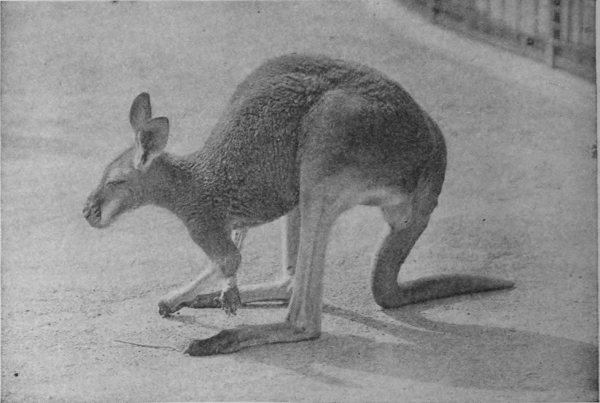
GREAT GRAY KANGAROO.
The Springbuck, (Antidorcas euchore), is to South Africa as the “prong-horn” is to our great western plains. Once, both were abundant, and the first hoofed animal to greet the traveler who entered their respective domains. To-day, both species are so nearly extinct that the hunter must search long before finding even one. The Springbuck received its name in recognition of its remarkable habit of leaping high into the air when running—a habit which also is displayed by the black-buck of India.
The Gazelles are found only in Asia and Africa, and the number of species is about 25. In general terms they may be described as dainty antelopes,—so slender and delicate in leg construction that it seems strange that such slender bones can support a tall animal without breaking.
The Dorcas Gazelle, of Arabia, (Gazella dorcas), is the species which most frequently finds its way into captivity, and it will serve very well as a specimen species for the whole group. Despite its delicate and frail appearance, it 49 is much more enduring in captivity than many animals which seem far more robust. A pair which entered the Park in 1900 is still living. The male has a temper which quite belies the reputation of the “gentle gazelle.” Although loyal and kind to his cage-mate, toward human beings generally he has manifested a very savage disposition, and in one of his fits of bad temper he broke off one of his own horns.
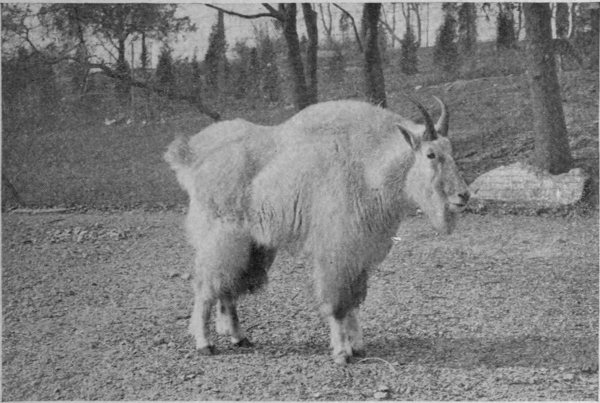
ROCKY MOUNTAIN GOAT.
The Indian Gazelle, (Gazella benneti),—frequently called in its home country Ravine “Deer,”—is a habitant of the sterile, water-washed ravines of northern and central India, which are the oriental counterpart of our western “badlands.” This animal inhabits the same regions as the black-buck, but because of the religious scruples of the Hindoos against the taking of life, both species are secure from attack—until the arrival among them of the white sahibs. A full-grown Indian Gazelle is 26 inches in shoulder height. The females of this species possess horns, which are very slender, and vary in length from 4 to 8½ inches.
The Small-Deer House will at all times contain various mammals which are there shown because it is a practical impossibility to provide a separate building for each group.
The Wild Swine of the world are here represented by three noteworthy species:
The Red River-Hog, (Potamochaerus pencillatus), of West Africa, is about the only handsome species of swine that Nature has produced. In form it is compact and well-turned, its long pencil-tipped ears are of pleasing pattern, and its hair is a rich auburn color, and the temper of our specimen is everything that could be desired. Beside it is shown “Clarence,” the East African Wart-Hog, (Phacochaerus aethiopicus), who is equally interesting, but in a different way. This species is very weird in form. The Collared Peccary, (Tagassu angulatum), beside it is more like the wild swine of Europe and Japan, and is not nearly so dangerous as general reputation demands.
The Kangaroos.—Seldom is there found in Nature a group of large-animal species whose members are so monotonously similar in general appearance as are the Kangaroos and Wallabies, of Australia. The great majority are either gray or gray-brown, and the only striking variation is found in the big Red Kangaroo, (Macropus rufus).
Fortunate indeed is the zoological park or garden which can exhibit even one living specimen of the White Mountain Goat. It is a very difficult matter to take an animal from a rarified dry atmosphere, at an elevation of 8,000 feet, and induce it to live at sea level, in a dense and humid atmosphere, on food to which it is by nature wholly unaccustomed.
We have been successful in establishing here, on a breeding basis this rare and difficult animal, (Oreamnos montanus). One kid was born in 1908 and another in 1910, and both have thriven, the former now being so large as to look like an adult specimen.
For some subtle reason which we can not explain, these animals—like the chamois and mouflon quartered in small pens near the Small-Mammal House—do not thrive in any of the large, rock-bound corrals of Mountain Sheep Hill. They are kept in a rock-paved corral near the Pheasant Aviary and the Crotona Entrance, and to their use has been devoted a rustic barn, which they shelter in or climb over, according to the weather. To see them walking nonchalantly 51 over the steep roof, or perching upon its peak, is one of the drollest sights of the Park.
The White Goat, sometimes mistakenly called “goat antelope,” belongs to a small group known as the Rupicaprines or rock antelopes. It inhabits many different kinds of territory, but usually the rugged sides and summits of high mountains, at irregular intervals from southwestern Montana and northern Washington, northward to the head of Cook Inlet on the coast of Alaska. (See map of distribution, with label.) The valley of the upper Yukon contains practically no goats. They are most abundant in southeastern British Columbia, where in a very small area, in September, 1905, Mr. John M. Phillips and the writer actually counted 239 individuals.
Of the five animals now exhibited in the Park, three were captured a few days after their birth, in May, 1905, about seventy miles north of Fort Steele, British Columbia. They arrived here October 9, 1905, and up to this date they have thriven as well, and grown as rapidly, as they would have in a state of nature. Their food consists of the best clover hay obtainable, and crushed oats. When they shed their coats, in the spring, they are almost as white as snow, but with months of use, their pelage becomes soiled and slightly discolored.
A fully adult male mountain goat stands from 39 to 41 inches in shoulder height, and weighs, on scales, from 258 to 300 pounds.
The Prong-Horned Antelope, (Antilocapra americana), is an animal in which Americans should now take special interest. Structurally, the Prong-Horn is so peculiar that it has been found necessary to create for it a special zoological family, called Antilocapridae, of which it is the sole member. This is due to the following facts: (1) This is the only living mammal possessing hollow horns (growing over a bony core) which sheds them annually; (2) it is the only animal possessing a hollow horn which bears a prong, or bifurcation; (3) it has no “dew claws,” as other ruminant animals have; (4) the horn is placed directly above the eye; (5) the long hair of the body and neck is tubular; and (6) that on the rump is erectile. Beyond all possibility of doubt, it will be our next large 52 species to become extinct, and if we may judge by the rate at which the bands have been disappearing during the last fifteen years, ten years more will, in all probability, witness the extermination of the last individuals now struggling to exist outside of rigidly protected areas. It was the intention of the Society to make liberal provision for the study of the species while it is yet possible to obtain living specimens, for fifty years hence our graceful and zoologically interesting Prong-Horn will be as extinct as the dodo. Unfortunately, however, it fares so badly on the Atlantic coast, there will, no doubt, be periods wherein this species will be temporarily absent from the Park.
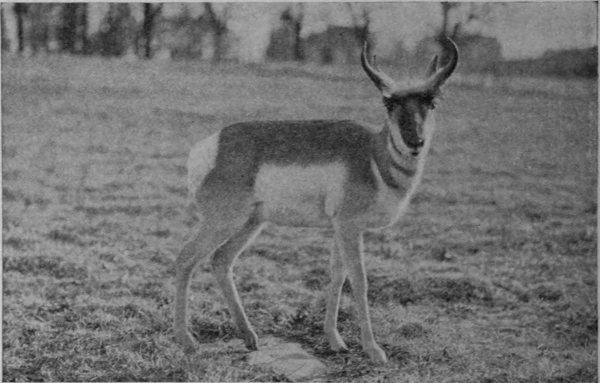
AMERICAN PRONG HORNED ANTELOPE.
Forty years ago this animal inhabited practically the whole of the great pasture region which stretches eastward from the Rocky Mountains to the western borders of Iowa and Missouri. Northward its range extended far into Manitoba; southward it went far beyond the Rio Grande, and it also ranged southwestward through Colorado and Nevada to southern California. Its chosen home was the treeless plains, where the rich buffalo grass and bunch grass afforded abundant food, but it also frequented the beautiful mountain parks of Wyoming and Colorado. It even lived contentedly in the deserts of the southwest, where its voluntary presence, coupled with the absence of water, constituted a problem which has puzzled the brain of many a desert traveller.
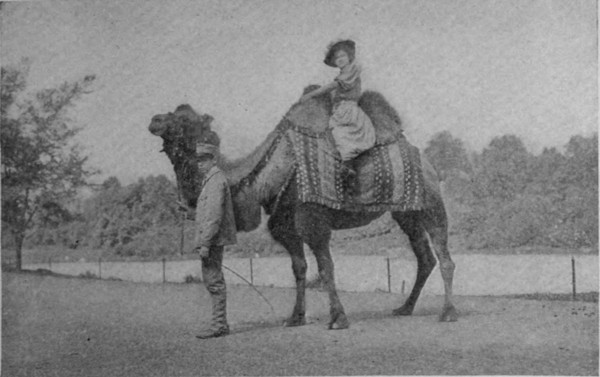
BACTRIAN CAMEL.
To-day, all observers agree that in all regions wherein the antelope are not rigidly protected, they are going fast. Those in the Yellowstone Park are protected against man only to be devoured by the wolves which infest the Park.
Unfortunately, the Prong-Horned Antelope is not a hardy animal. The kids are very difficult to rear; they are at all times easily hurt by accident, and even in a state of nature this species suffers more severely in winter than any other North American ruminant. Often the herds drift helplessly before the blizzards, with numerous deaths from freezing and starvation, and in spring the survivors come out thin and weak.
Speaking in a collective sense, the Camel is much more than an ordinary animal unit in a zoological park. On the high plains of central and southwestern Asia, and throughout the arid regions of Africa, it is an institution. Without it, many portions of the Old World would be uninhabitable by man. Take either Dromedary or Bactrian Camel, and it is a sad-eyed, ungainly, slow-moving creature, full of plaints and objections; but remember that it goes so far back toward the foundations of man’s dynasty, that beside it the oldest American history seems but a record of yesterday. 54 It is only a species of the utmost tenacity which could for fifty centuries or more withstand constant use and abuse by man without being altered out of all resemblance to its original form. All races of mankind and all breeds of domestic animals save one, change and continue to change, indefinitely, but the Camels apparently go on the same, forever.
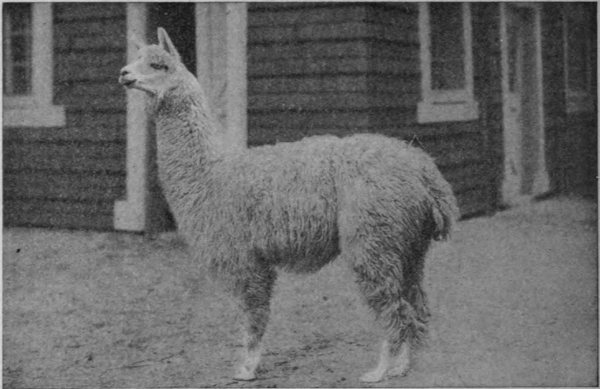
ALPACA.
The Bactrian Camel, (Camelus bactrianus), he of the long shaggy hair—when not shedding—and the two great humps, is the beast of heavy burden, the four-footed freight-car of the desert sands. He can carry 550 pounds of freight, for three or four days between drinks; but a swift pace is not for him. It is an animal of this remarkable species, from distant Turkestan, southwestern Asia, which daily in fine weather offers its services as a riding animal, at the stand near the Large Bird-House.
It is unfortunate that the Bactrian Camel is in its finest pelage only in winter, when visitors to the Park are few, and camel-riding is out of the question. Promptly upon the approach of warm weather and a million visitors, it sheds its long, shaggy brown coat, and stands forth as if shorn by a shearer. Of this species, the Zoological Society possesses two fine specimens (the gift of Captain John S. Barnes), one of which will at all times be found regularly exhibited at the Camel House, close by the Crotona (southwest) Entrance.
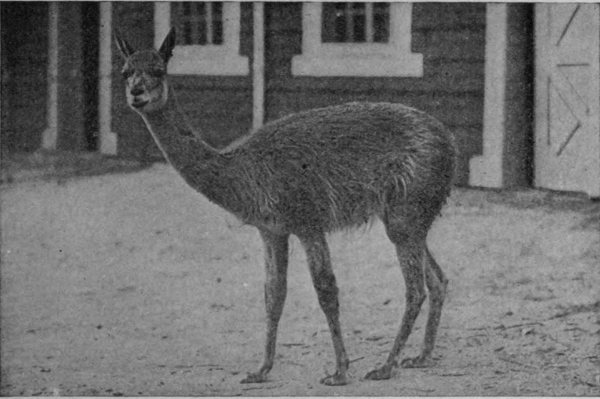
VICUNIA.
The Dromedary, or Single-Humped Camel, (Camelus dromedarius), is a smaller animal than the preceding, of lighter build, and therefore capable of much more speed in travelling. This species never is clothed with long hair.
Next to the Camel House and corrals is the installation for the nearest relatives of those species,—the Llamas, Guanacos and other cameloids of South America.
Collection of Cameloids was presented by Mr. Robert S. Brewster.
The arid regions of South America are inhabited by four species of long-necked, long-haired, soft-footed animals, so closely related to the camels of the Old World that they are called cameloids. There are four species. The llama and alpaca are in a state of domestication, and are supposed to have been derived from the wild guanaco and vicunia. All of them might almost be described as small-sized, humpless camels; and their tempers and mental traits are as odd as their forms.
The ordinary cameloid is a quiet and inoffensive creature; but the exception is a rogue of rogues. It will bite with the persistence of a bull-dog, and with its massive, chisel-like 56 lower incisors inflicts ugly wounds. At times a llama or vicunia becomes actually insane, and seeks to destroy every living creature within its reach. Regardless of punishment, such creatures attack their keepers and their herd-mates, spit upon visitors, and rage up and down their corrals in most absurd fashion. Occasionally such individuals require to be completely isolated.
The Llama, (Lama glama), is the largest and strongest member of the group. Its body is covered with a thick mass of long, wavy hair of fine texture, which may be either brown, white, white and brown, or almost black. The head and legs are short-haired like those of the guanaco. From time immemorial, this animal has been used as a beast of burden, and in the Andes has played an important part in the mineral industry by carrying silver ore and bullion from the mines.
The Alpaca, (Lama pacos), is bred for its wool. It is smaller than the llama, but more abundantly haired on the legs, neck and head. Its fleece is long, and lies in stringy tufts. Usually its color is dark brown or black, but occasionally a white Alpaca is seen. A white specimen in the Zoological Park collection has blue eyes.
The Guanaco, (Lama guanacus), is one of the most interesting and valuable wild animals now found in Patagonia. Unfortunately, it is so stupid and incapable that it is easily killed. The natives of Terra del Fuego, themselves almost the lowest and most ignorant of men, slaughter Guanacos for food by surrounding groups of them and clubbing them to death.
In size the Guanaco is between the llama and vicunia, and its shoulder height is about 4 feet. Its hair is thick and woolly, of a pale reddish color, and there are naked patches on the legs. This species is found on the Andes, from Ecuador to Terra del Fuego, and appears to be most abundant in Patagonia.
The Vicunia, (Lama vicunia), is the only member of the cameloid group which is not clothed with a mass of long hair. It is the smallest member of the group, comparatively short-haired, its color is a uniform light brown, its head is small, and there are no callosities on the hind legs. The Vicunia is found from southern Ecuador, through Peru to central Bolivia.
The American members of the Deer Family will be found in the ranges situated on the hill west of the Wild-Fowl Pond, stretching from the Llama House northward to the Service Road.
After several years of experiments, we must admit that to all the American members of the Deer Family save the wapiti white-tailed and mule deer, the climate of New York City is decidedly inimical. This densely humid and extremely saline atmosphere is about as deadly to the black-tail, caribou and moose as it is to the Eskimo; and thus far we have found it an absolute impossibility to maintain satisfactory herds of those species in the ranges available for them. In great tracts of forests, some of them might become acclimatized; but, be that as it may, all experiments made thus far both here and in two of the great game preserves of New England, prove conclusively that black-tail deer, mule deer, caribou, moose, and also prong-horned antelope, are among the most difficult of all ruminants to acclimatize anywhere in the United States eastward of the great plains.
Although the Zoological Society will continue its experiments with some of these preserve species, and will always strive to exhibit some of them, our original hopes regarding them have been abandoned. We are certain that the difficulty lies not in the food, but in climate conditions, that are beyond our control, and especially our very salty atmosphere.
The American Elk, or Wapiti, (Cervus canadensis.)—Of all the numerous members of the Deer Family, this animal is second in size to the moose only; and in the autumn, when its pelage is bright and luxuriant, its sides well rounded, its massive antlers clean and held conspicuously aloft, the elk may justly be called the king of the Cervidae. It is well that in the Yellowstone Park we have an unfailing supply of Elk, which bids fair to perpetuate this handsome species for another century.
Our Elk Range might well stand for a mountain park, in which is set a natural lakelet of real value. In October, when the splendid groves of beech, oak, and maple along the eastern ridge put on all the glorious tints of autumn, and the big thicket of sumacs, ash, and haw on the northern hill fairly blaze with scarlet—then are the elk also at their best. There is no finer picture in animate nature than a herd of elk in October, with such a setting of greensward, tree-trunk, and foliage.
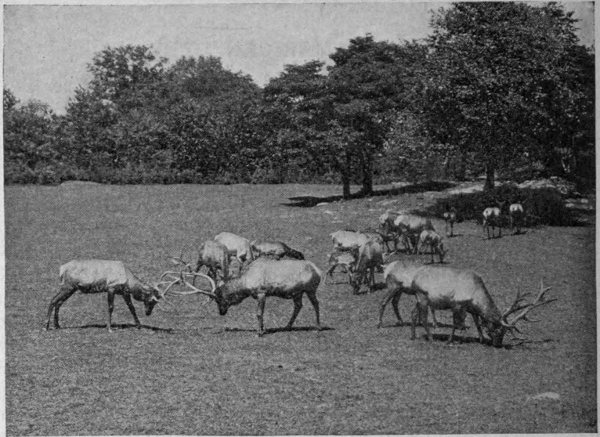
AMERICAN ELK.
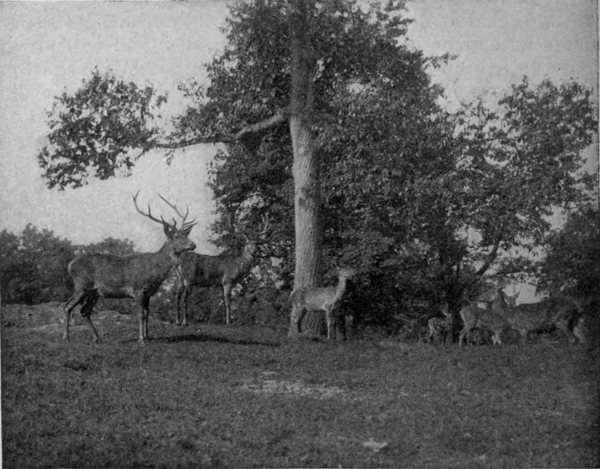
EUROPEAN RED DEER.
The maximum shoulder height of the Elk is 5 feet 4 inches, or thereabouts, and the heaviest weight noted thus far is 927 pounds.
The calves are born from May to July, and are spotted during the first six months. During the first year the antlers are merely two straight spikes, called “dag antlers.” As in all members of the Deer Family, the antlers are shed every year—which to many persons is almost beyond belief. Any person who visits a zoological garden in midsummer will see that the old antlers have dropped off bodily, just below the burr, and that new antlers, covered with hair, soft, full of blood, and with club-like “points,” have sprung up like mushrooms in place of the old ones. In supplying the great drain on the system necessary to support this remarkable growth, the Elk grows thin, and the fear of hurting his tender young antlers makes him quite timid and inoffensive. He is no longer the tyrant of the herd, and a constant menace to his keepers.
At this point it is not amiss to call attention to the differences between horns and antlers.
A horn is a hollow sheath, growing over a bony core, and except in the case of the prong-horned antelope, is never shed. Horns are worn by both sexes of all bison, buffaloes, cattle, antelope, sheep, and goats.
An antler is of solid bone throughout, growing from the skull; it is shed every year close to the skull, and quickly renewed. Usually antlers have several branches. They are worn by nearly all male members of the Deer Family—moose, elk, caribou, deer, etc., and also by the female caribou. The prongs on an antler are no index of the wearer’s age. Some of the finest and most massive elk antlers have only twelve or fourteen points. During August and September the hairy covering, or “velvet,” of new antlers is rubbed off against trees and bushes. This period is quickly followed by the mating season, during which the neck of the bull becomes unusually large, and often the animal becomes dangerous.
Although the Elk is essentially a timber-loving animal, it also wandered far into the plains bordering the Rocky Mountains on the east—until driven from them by man. The ideal home of this animal is the timbered foothills of our western mountains, up to 8,000 feet. Although once 60 found from Virginia and New York to Oregon, and from northern Manitoba to the Gulf of Mexico, it is now numerous only in and adjacent to the Yellowstone Park, in central Colorado, where it is well protected, and in western Manitoba. The number of Elk in the National Park is variously estimated at from 10,000 head to a much larger number.
In a wild state, the Elk feeds on grasses, weeds, and the leaves and twigs of various trees and shrubs. Of all American deer, it is the most easy to acclimate and breed in captivity. Large herds are now being maintained and bred in numerous private game preserves in New Hampshire, New York, Minnesota, Massachusetts, and elsewhere. About 200 head have been released in the Adirondacks.
The Mule Deer, (Odocoileus hemionus.)—This fine animal is universally known throughout the Rocky Mountain region, which constitutes its home, as the “Black-Tailed Deer.” Because of its very large ears, and the absence of a black tail, it is known to naturalists as the Mule Deer. Inasmuch as its tail is not black, the above more common name properly applies to Odocoileus columbianus, the true black-tailed deer of the Pacific coast. In Manitoba this animal is called the “Jumping Deer,” because when running at a gallop, it makes a series of stiff-legged jumps, or “bucks,” of great length.
The weight of full-grown bucks ranges from 250 to 300 pounds, and specimens have been known to reach 325 pounds. The antlers of the Mule Deer are larger and handsomer than those of the white-tailed deer, and are much better poised on the head. Instead of dropping forward, they partake more of the set of an elk’s antlers, and many a “tenderfoot” hunter has mistaken a heavily-antlered Mule Deer for an elk. The antlers of a Mule Deer are easily distinguished from those of the white-tailed species by the two Y-shaped prongs on each antler. It will be remembered that instead of these, the white-tailed deer antler bears three straight, perpendicular spikes.
The Mule Deer makes its home in rugged ravines and bad lands so common along the creeks and rivers of the Rocky Mountain region, extending well eastward into the plains. Of late years it has been driven out of the most accessible of its former haunts, and forced to take shelter in the rugged fastnesses of the foothills and mountains. West of the Rocky Mountains it was formerly found along the whole Pacific slope, from Cape St. Lucas to British Columbia, although in northern California it is almost replaced by the Columbian Black-Tail, (O. columbianus).
DEVELOPMENT OF THE ANTLERS OF A MALE DEER.
These pictures show the stages of growth of the antlers from the time the old ones are dropped, to the full development. Number 1 shows the bull with the one antler gone—picture made early in March. Number 6 shows the full grown antlers, with the velvet hanging in strips. Number 6 was made August 24 of the same year as Number 1. This remarkable antler development takes place every year in the life of all male deer.
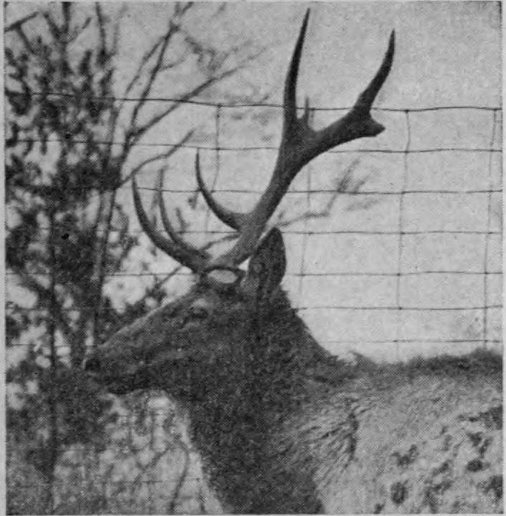
1.
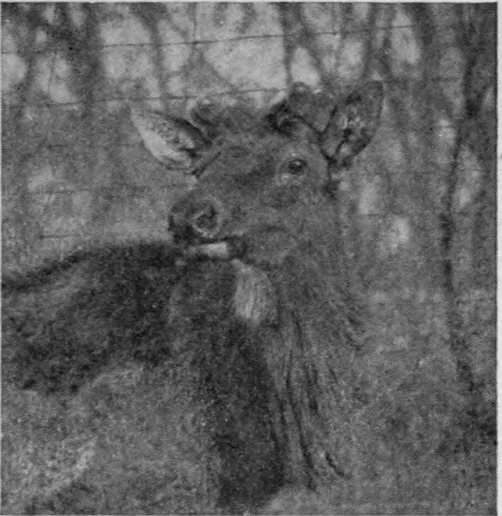
2.
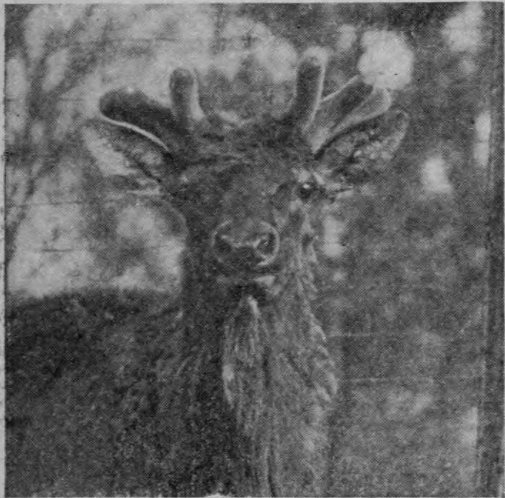
3.
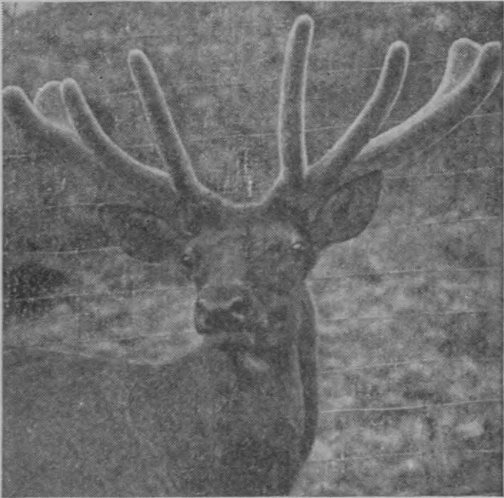
4.
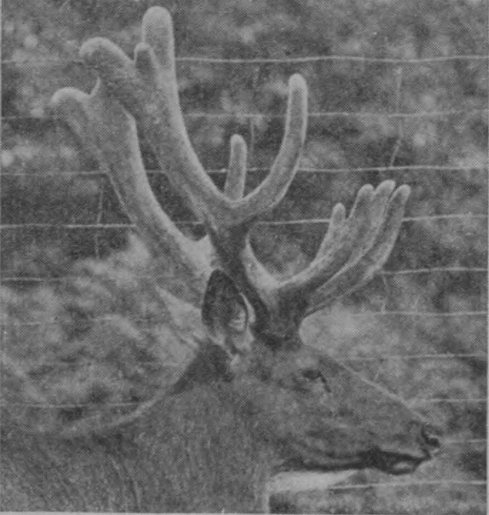
5.
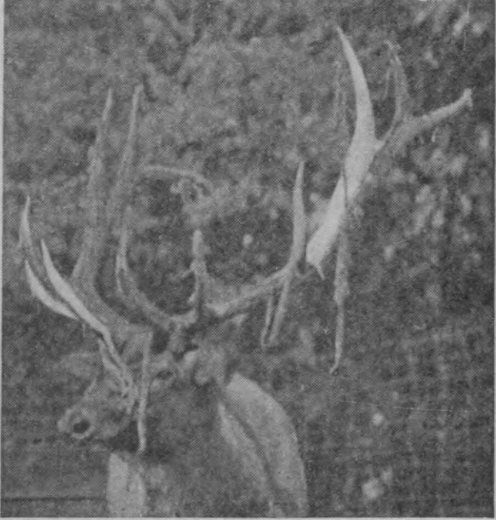
6.
The White-Tailed Deer, (Odocoileus virginianus), is the species most widely known throughout the United States, partly by reason of the fact that it was the first species with which the early settlers of America became acquainted, partly because of its wide distribution, and also its persistence in holding its own. In various localities this animal is known under various names, such as “White-Tailed Deer,” “Flag-Tailed Deer,” and “Fan-Tailed Deer.” Although not at all in need of it, quite recently it has received still another name—American Deer. The small deer of Florida, and also of New Mexico and the Southwest, have been described as separate forms; and if size is to be accepted as a factor in the differentiation of species, the diminutive proportions of the proposed southern species are quite sufficient to establish their separate identity.
The White-Tailed deer of Virginia and the northern United States is a fine animal—large, strong-limbed, heavily-antlered, and hardy. Between it and the deer of Florida the difference is as great as that between a setter dog and a mastiff. Thanks to the fact that this species is a born skulker and lives only in thick brush and timber, it still holds its own throughout the forest regions of the South generally, Pennsylvania, the Adirondacks, Maine, Michigan, Minnesota, the Dakotas, Montana, and Colorado. In the West it is often found inhabiting brushy ravines and river bottoms.
This species breeds readily in confinement, and when protected in any large tract of brush or timber, increases rapidly. During the months of September, October, and November, the bucks are dangerous and untrustworthy. The peculiar formation of the antlers—three strong, spear-like points thrust straight upward from the beam—makes them dangerous weapons; and when an ill-tempered buck lowers his chin and drives straight forward with eight sharp spears of solid bone, and nearly three hundred pounds of weight to back them, he may well be considered a dangerous animal. He is to be feared less than the elk only because he is smaller.
The Woodland Caribou, (Rangifer caribou).—The first hoofed animal to arrive at the Zoological Park was a young 63 female of this species, which was procured in Champlain County, Canada, and forwarded to the Society by one of our members, Mr. George S. Huntington. These animals, when present in the Park, will be kept in a small enclosure, because a large range containing an abundance of green grass is fatal to them.
The wild range of the Woodland Caribou extends from Newfoundland, Nova Scotia, and Maine, with many wide gaps, to the head waters of the Yukon River, in southern Alaska. The following localities are worthy of special mention: northern Quebec and Ontario; James Bay; the northern end of Lake Winnipeg (occasionally); Lake of Woods, Minnesota; Oregon near Mount Hood; northern Idaho; northwestern Montana, and the mountains of British Columbia.
Quite recently, three new species of caribou have been added to our fauna, one from the Alaskan Peninsula (Rangifer granti), one from the Kenai Peninsula (Rangifer stonei), and one from the Cassiar Mountains (Rangifer osborni).
The Woodland Caribou attains nearly twice the bodily bulk of its more northern congener, the Barren-Ground caribou. In a state of nature it lives on browse, reindeer moss, tree moss, and lichens, and it loves ice-covered lakes and ponds as much as any boy. Its loose-jointed and wide spreading hoofs and enormously developed “dew-claws” have been specially designed by Nature to enable this animal to run freely, as if on snow-shoes, over snow or bogs, which to any small-hoofed deer would be quite impassable.
The female Woodland Caribou is provided with small antlers, which, like those of the male, are shed and renewed annually.
In the absence of caribou in the Park, visitors are advised to look for specimens of the Lapland Reindeer, (Rangifer tarandus), for we shall endeavor to keep this genus represented.
Although the main building of this installation has not yet been erected, the plan for the various buildings and corrals has been approved, and the main building was begun in 1911 and completed in 1912. The three buildings, and the extensive corrals connecting with them, as a 64 whole, do justice to the important and picturesque Family Equidae, which includes all the zebras, wild asses and wild horses of the world.
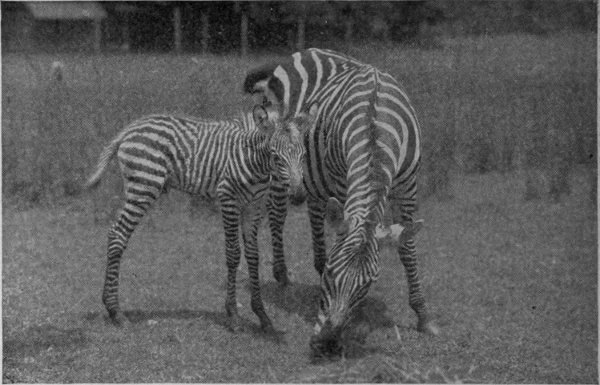
GRANT ZEBRA.
The Prjevalsky Horses, (Equus prjevalskii).—Of all the wild equines which either now or hereafter may be seen in the Zoological Park, the strange little wild horses from western Mongolia are, and probably will remain, the most interesting, from a zoological point of view. Broadly speaking, they are the connecting link between the many-striped zebras, the little-striped quaggas and the wild asses on one side, and the domestic, unstriped horse on the other. These wild horses possess a narrow, dark dorsal stripe, which, in the winter pelage is scarcely visible, but in summer is plainly evident. A perfect specimen has an erect mane, no long forelock and no “chestnuts” on its legs. On the upper half of its tail the hair is short, and mule-like, but on the lower, or terminal half, it is long and horse-like. The winter coat of this animal is very long and shaggy.
Mountain Zebra, (Equus zebra).—This species has been nearly exterminated by man, and is rarely seen in captivity. It inhabits the mountains of Cape Colony, and it is estimated that only 400 individuals remain, which now are carefully protected.
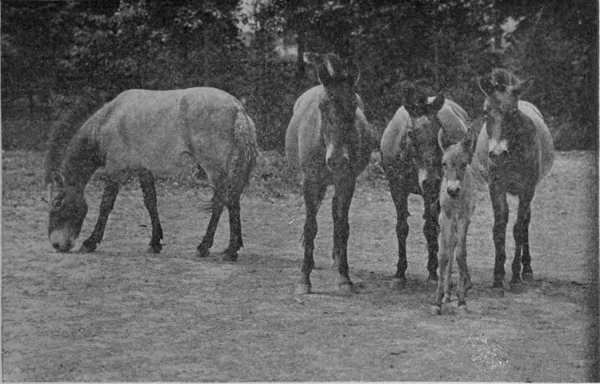
PRJEVALSKY HORSES.
Grevy Zebra, (Equus grevyi).—This picturesque species was discovered in Abyssinia, when Jules Grevy was president of France, and it was named in his honor. It is of large size, covered with very narrow stripes all over its body, head and limbs, and its huge ears are of remarkable form. This species is limited to southern Abyssinia and British East Africa southward to the Tana River.
Grant Zebra, (Equus burchelli granti).—Of all the zebras now seen in captivity, the great majority belong to what very properly may be designated as the group of Burchell Zebras. This group contains, besides the type species, which has practically no stripes on its legs, four subspecies, whose legs are more or less striped, and which may or may not possess “shadow stripes” on the hind-quarters. A “shadow stripe” is a faint, dark stripe in the middle of a wide white or pale yellow stripe which lies between two broad black stripes.
Grant Zebra is the most heavily striped of the subspecies composing the Burchell group. The visitor will observe that its horizontal leg-stripes are very pronounced, and so numerous that they are carried quite down to the hoofs. The ground-color of the animal is a cold white, and the thigh and body stripes are very wide and intense. This fine pair was captured in Masailand, East Africa, in 1902.
Chapman Zebra, (Equus burchelli chapmani), also belongs to the Burchell group, and in its color pattern it approaches quite nearly to the type. The legs of the male bear a few stripes, those of the female almost none. There are visible on the hind-quarters of the female a few faint shadow-stripes.
The Persian Wild Ass, (Equus persicus), is a very satisfactory representative of the wild asses generally. Its dorsal-stripe is very wide and sharply defined, but it bears no shoulder-stripe, and those that are faintly indicated on its legs are nothing more than oblong blotches of dark color. As its name implies, it inhabits Persia, and Syria, and a closely related form, the Onager, (E. onager), is found in Beluchistan and western India. A third species, the Kiang (E. hemionus), is found on the plains of Tibet.
In representatives of the deer, (Family Cervidae), Asia far surpasses all other countries. Her species number about 38,—fully double that of any other continental area,—and from the great Altai wapiti to the tiny musk deer, the variations in size and form are fairly bewildering. The entire hill that rises between the Fordham Entrance and Bird Valley, from Cope Lake to the Zebra Houses, is devoted to the series of houses, corrals and ranges that are occupied by the deer of Asia and Europe.
It is quite certain that a number of desirable species of Asiatic deer can successfully be acclimatized in the parks and game preserves of America, and induced to breed. Almost without an exception they are strong and vigorous feeders, and they keep fat and sleek when our own black-tail, mule deer and white-tail mince like pampered epicures, grow thinner and thinner, and finally die of “malnutrition.”
Believing that the members of the group amply justify the effort, the Zoological Society has been at considerable pains to bring together a fine, representative collection of the Old World Cervidae and properly install its members. Although the series proposed is not quite complete, it contains such rarities as the Altai Wapiti, Barasingha, Burmese Thameng, Malay and Indian Sambar, and several others. 67 They are sheltered by four houses, the largest of which crowns the summit of the hill on the right of Osborn Walk as the visitor enters from Fordham. For the visitors’ convenience we will make note of the various species about in the order of their appearance, and not in zoological sequence.
The Axis Deer, (Axis axis), is the handsomest of all the tropical deer. Indeed, it may even be said to be the only species of the tropics possessing both form and pelage which are alike pleasing to the eye. In contrast with the many beautiful and splendidly colored antelopes of Africa, the deer of the tropics, all round the world, are poorly provided with those characters which make a handsome animal. With the sole exception of the Axis Deer, nearly all the other deer of the East Indies have thin, coarse, dull-colored hair, their antlers are small, and seldom have more than four points. This is equally true of the deer of Mexico, Central and South America. Even our own white-tailed deer, so lusty and fine in the North, becomes in Florida and Texas so dwarfed that it has now been called a subspecies.
Considering the severe plainness of all the other deer in the tropics, it is a little strange that the coat of the Axis should be the most beautiful possessed by any deer. But it is quite true; and apart from the majesty of the elk, there is no more beautiful sight in cervine life than the picture offered by a herd of Axis Deer feeding in a sunlit glade surrounded by forest.
This species adapts itself to out-door life in the temperate zone with surprising readiness, not even second in that respect to the eland. As a matter of course the Axis can not withstand the fierce blizzards of midwinter as do the elk and other northern deer; but a reasonable degree of care in providing it with a dry barn, and shelter from cold winds, enables it to live even as far north as northern Germany with perfect comfort. In winter our Axis Deer barn is moderately heated by a stove.
The Japanese Sika Deer, (Cervus sika typicus), is a small representative of a large group of deer species inhabiting far-eastern Asia, and known as the Sika Deer group. A ridiculous number of forms have been described as species and subspecies, of which possibly one-third are entitled to stand. Some of those on the Asian mainland, as the Pekin Sika Deer, are much larger than the Japanese Sika, and 68 also more strikingly colored. The latter species, shown in our northernmost corral, is about 33 inches in height, and of a dull and uninteresting smoky-brown color. Its antlers are quite large for a deer so small, and in the mating season males are sometimes dangerous. This species is very hardy, breeds persistently, requires no heat in winter, and very rarely sends a case to the hospital.
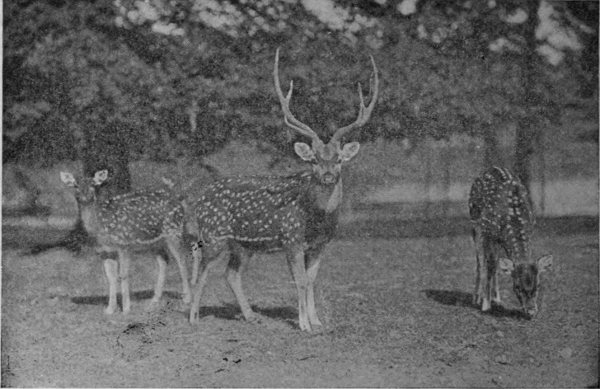
AXIS DEER.
The Fallow Deer, (Dama vulgaris), is the type of a distinct group of deer which are distinguished by the possession of antlers widely palmated throughout the upper half of the beam. In some old Fallow bucks the antlers are quite moose-like, and give this small deer an imposing appearance far out of proportion to its actual size. The weight of a large buck in prime condition generally is between 180 and 200 pounds, and its shoulder height is between 36 and 40 inches. The largest antlers recorded by Mr. J. G. Millais, in his beautiful work on “The British Deer,” measured 29½ inches in length, 28½ inches spread, width of palmation 8 inches, and the number of points 14. The extinct Irish elk, with the most colossal antlers ever carried by a cervine animal, was a near relative of the two living species of Fallow Deer.
Although a native of northern Africa and the north shore of the Mediterranean, the Fallow Deer was acclimatized in 69 England and northern Europe so long ago that the exact date records of the event have disappeared, and the species is now at home in very many European forests and game preserves. The deer parks in England possess many fine herds, but they sometimes exhibit one unfortunate result of long breeding in a semi-domesticated state—departure from the original type.
The typical Fallow Deer is in winter very dark brown, with light brown legs and under parts, and in summer light red with white spots—quite like the axis. From this standard, the variations run from pure white through the color of the wild type to jet black.
The fine herd in the Zoological Park is the gift of Mr. William Rockefeller. Six of its original members came from the donor’s herd at Greenwich, Connecticut, and six were purchased from one of the imperial parks of Russia, by consent of the Czar, and represent the most hardy stock obtainable.
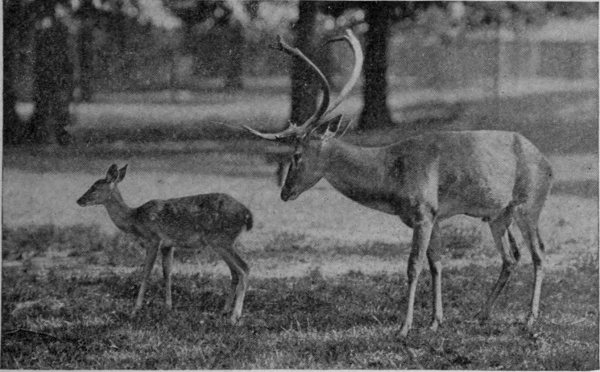
BURMESE DEER.
The Burmese, or Eld Deer, (Cervus eldi), also known as the Brow-Antler Deer, is one of the rarest species to be seen in captivity. Living specimens are acquired only through special expeditions to northern Burma. Its most characteristic feature is the antlers of the male, which sends forward a very long and almost straight brow tine, while 70 the main beam sweeps backward in the opposite direction, and describes a full semicircle. The antlers are both very heavy and long for the size of the animal. The specimens shown here, which are breeding satisfactorily, are the gift of Mr. William Rockefeller.
The Barasingha Deer, (Cervus duvauceli), also called the Swamp Deer, is to India what the mule deer is to North America. To my mind, the antlers of the former always suggests the latter species, and in size the two species are much alike. In summer the coat of the Barasingha is of a beautiful golden-yellow color, conspicuous from afar, and the antlers of old males reach a length of from 35 to 41 inches, with three bifurcations on each beam. The antlers sometimes are shed and renewed twice in twelve months. With us this species breeds very regularly, and the offspring mature well.
The Altai Wapiti, (Cervus canadensis asiaticus), is, in all probability, the parent stock of our American elk, but it happens to be a fact that our species was the first to be discovered by systematic zoologists, and described. To all visitors who are interested in deer, the Altai Wapiti—and also the Tashkent Wapiti—are a constant source of wonder, because of their well-nigh perfect similarity in all points to our own wapiti, or American elk. Our Asiatic wapiti are exhibited in ranges connecting with the western rooms of the Asiatic Deer House, where they have bred twice, and produced two fine fawns. In the rutting season the males are very cross and dangerous. They are hardy, and require no heat in winter.
The Indian Sambar, (Cervus unicolor), always suggests a tropical understudy of the Altai wapiti, clad with thin, coarse, bristly hair, and with shorter and smaller antlers, and a bristly mane all over the neck. Each antler possesses three points, only. Of all the Old World Cervidae, this species most nearly approaches the size of the Altai and Tashkent wapiti. It inhabits the hill forests of India, and in Burma, Siam and farther south it is replaced by the next species.
The Malay Sambar, (Cervus equinus), also called—most inappropriately—the “Horse-Tailed Deer,” very strongly resembles the preceding species, except that the bristly mane of the former is generally absent. The antlers of this species are shorter, also, but very thick in proportion to their length. The Malay Sambar is confined to the Malay 71 Peninsula and the countries immediately above, and Borneo and Sumatra.
This species possesses many admirable qualities, and it might be introduced to advantage in our southern states. It is very even-tempered and sensible, easily handled, is a vigorous feeder, breeds persistently, and matures very rapidly; but in every New York winter, it requires some heat in its barn.
The Maral Deer, (Cervus maral), is in appearance like an extra large red deer or a small elk. It is a midway member of the Wapiti group, which extends in a somewhat broken chain from Colorado, northward across Bering Strait to Asia, and thence across Asia and Europe to Scotland. We have owned a fine pair of Maral Deer, from the Caucasus district, but they have failed to breed as expected.
The European Red Deer, (Cervus elaphus), is an understudy of the American elk, which it much resembles in form and in habits. Next to the elk it is the finest living deer, and for many generations has held its own against the dangers of in-breeding. In the parks and forest preserves of Great Britain and Europe, it exists abundantly, but only as private property, subject to the guns of the owner and his friends. This species has been successfully crossed with the American elk.
Other Asiatic Deer will be found in the Small-Deer House, in the southern end of the Park.
As a spectacle of captive animal life, there is none more inspiring than a spacious, well-lighted and finely-appointed lion house, filled with a collection of the world’s greatest and handsomest wild beasts. To build an ideal lion house, and to fill it with a first-class collection of large felines, are matters involving no little time and much money; but the sight,—for the millions of visitors,—of lions, tigers, jaguars, pumas, leopards, cheetahs, black leopards, snow leopards and clouded leopards, all under one roof, surely is worth what it costs.
The Lion House of the Zoological Park was completed, excepting a few minor details, early in the year 1903, and was formally opened to the public in February. It is 244 feet long, 115 feet wide, including the outdoor cages, and its cost when completed reached $150,000. The materials of the building are the same kind as those used in the Reptile 72 House and Primate House, but the animal sculptures, all by Mr. Eli Harvey, are more abundant and conspicuous than on any other structure erected heretofore. The building contains 13 indoor cages, and 9 outdoor cages, and between the two there is free communication. The sizes of the various cages are as follows:
Interior cages: Largest, 14 feet wide, 22 feet deep; smallest, 13 feet wide, 14 feet high.
Exterior cages: two end cages, 40×44 feet, 17 feet high; central cage, 40 feet square, 14 feet high; smallest, 13 feet wide, 12 feet deep, 13 feet high.
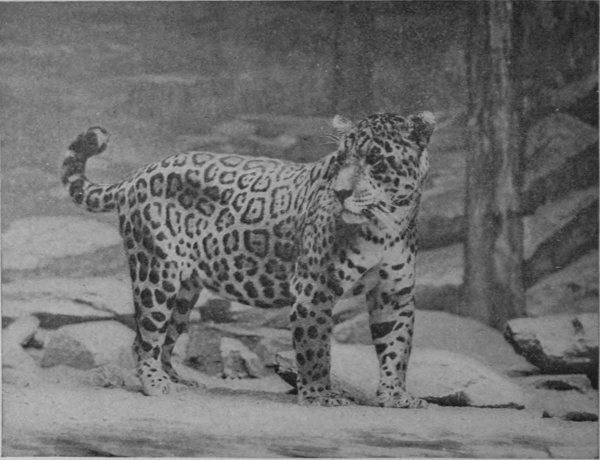
JAGUAR.
Excepting for the single fact of having interior and exterior cages, the Lion House of the Zoological Park is—like the Primate House—an entirely original development. Its most important new features are as follows:
All cage service, the introducing and withdrawal of animals, is conducted from the rear, by means of a track underneath the sleeping dens, and an elevating platform car.
The communication between indoor and outdoor cages is direct and continuous.
Instead of upright iron bars, all the cage fronts are of hard-steel wire netting, in rectangular pattern, attached to 73 wrought iron frames. This is considered by the Zoological Society a great improvement upon the heavy bar-work hitherto in universal use for cage fronts in lion houses.
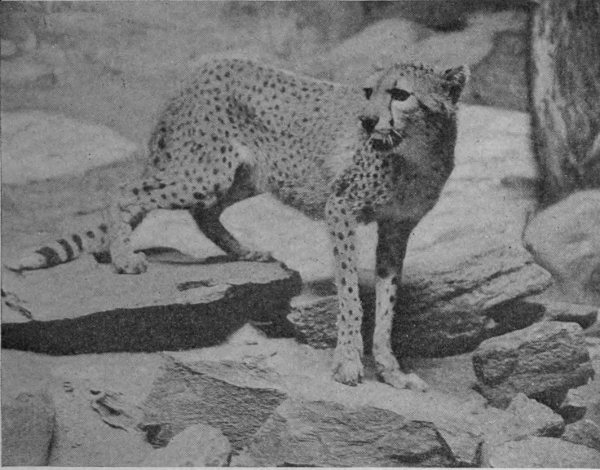
CHEETAH.
The space above the sleeping dens has been developed as a sunlit balcony, whereon the animals will be very conspicuous, even to large crowds of visitors.
Jungle-green tiling, impervious to moisture and dirt, is used as a back-ground for the animals.
The Lion is an animal of perpetual interest, but like every other noteworthy wild animal, its haunts are constantly being claimed by civilization, and its members are rapidly decreasing. It is not a difficult matter to exterminate or drive out from a given territory any large and conspicuous quadruped, and at the present rate of settlement and industrial development in Africa, it may easily come to pass that by the end of the present century, the king of beasts will be without a home, outside of zoological collections.
Like everything great, the Lion has his share of critics and detractors. A few writers have asserted that because he does not stalk through his native forests with head proudly erect, like a drum-major on parade, he is mean-spirited and cowardly. But the beast of noble countenance believes in 74 the survival of the fittest, and both by inheritance and observation he knows that a lion who needlessly exposes himself in the field captures the smallest amount of game, and attracts the greatest number of steel-tipped bullets.
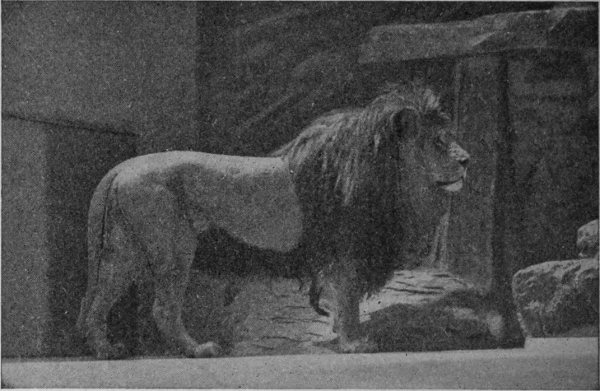
BARBARY LION.
Although Lions vary greatly in their color, and in the length of the mane, it is conceded by naturalists that only one species exists. In the same district and under precisely similar conditions are found short-maned and long-maned individuals, and all shades of color from tawny yellow to dark brown. The present geographic range of the species is from Southern Rhodesia to Persia and northwestern India, but in northern Egypt there is a large extent of territory which is lionless.
By reason of his heavy mane and massive countenance, supported by the grandest roar that issues from throat of beast, the Lion appears to be a larger animal than he really is. It is yet an unsettled question whether it exceeds the tiger in length, height or weight, and it is certainly true that in point of size these two species are very evenly matched.
In captivity, the Lion is reasonably contented, and under good conditions breeds readily, and lives a goodly number of years.
The Siberian Tiger.—Strange to say, the tiger ranges far to the northward of its proper home in Hindustan, even to Corea, Manchuria and Russian Siberia. In those cold 75 regions the tiger grows to its greatest size, and is clothed with a dense coat of long and shaggy hair. In collections, the great northern tigers are the most highly prized. The Zoological Park has recently acquired from East Siberia two fine young specimens, born early in 1909, and all the year round they inhabit the great northern outdoor cage attached to the Lion House. It is a strange sight to see tigers living outdoors in winter in New York.
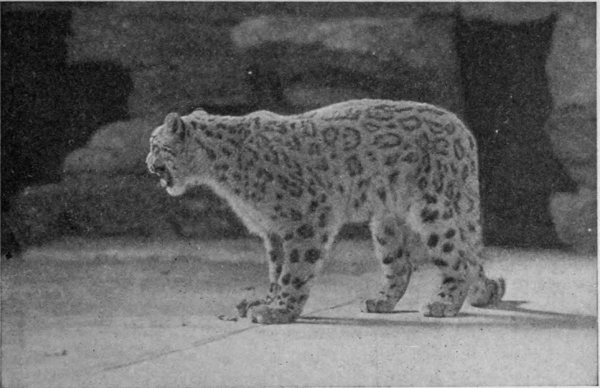
SNOW LEOPARD.
The Tiger will be found upon the earth long after the lion has disappeared. He is a far better hider, a more skillful hunter, less given to taking foolish risks, and he does not advertise his presence and invite his enemies by the bombastic roaring in which the lion delights to indulge. The Tiger is an animal of serious mind, and he attends strictly to business. A lion will stalk out into the open, in broad day, but the Tiger sticks closely to cover until the friendly darkness renders it safe to roam abroad.
Despite the density of the population of India, and the omnipresence of sahibs with rifles of large caliber, the Tiger still inhabits all India from Cape Comorin to the Himalayas, the Malay Peninsula, Sumatra, Burma, Siam, and certain portions of China up to the region of snows. Corean and Siberian Tigers are much sought after by zoological gardens, partly on account of their size, and also because they are so hardy they are able to live out doors all winter in 76 the temperate zone. The Tiger is not found in Africa, nor in any country westward of India.
The maximum length attained by this animal, head, body and tail, is 10 feet 2 inches. A very large specimen killed by Dr. Hornaday measured 9 feet 8½ inches in length, stood 3 feet 7 inches high at the shoulders, and weighed, on the scales, 495 pounds. In India, Tigers are classed according to their habits, as “game-killers,” “cattle-lifters,” or “man-eaters.” Fortunately, in comparison with the total number of these animals, the latter are few and far between.
Of yellow-coated felines, The Jaguar, (Felis onca), is next in size to the tiger. In South America, it is almost universally called “El Tigre” (pronounced Te’-gre), which is Spanish for tiger. Comparatively few Americans are aware that this superb animal belongs in the fauna of the United States, but such is the fact. The northern limit of its distribution is found in southern Texas, where it still exists in small numbers. In South America it extends to Patagonia.
The Jaguar is a stocky, heavily-built animal, with a massive head and powerful forearm. It is a good climber, and many wonderful stories of its strength have been told and printed. Among leopards of all kinds it can always be identified by the great size of the black rosettes on its body, as well as by its heavy build.
The splendid male specimen, named “Senor Lopez,” in honor of a former President of Paraguay, was the first to arrive for the new Lion House. It was captured in August, 1901, in the wilds of central Paraguay, expressly for us, through the efforts of Mr. William Mill Butler, of Philadelphia, and by him presented to the Zoological Park. After a long journey in small river craft, in a flimsy wooden cage that several times came near collapsing, the animal reached Asuncion, was taken to Liverpool by Mr. Butler, and finally reached New York.
The Leopard, (Felis pardus), is fourth in size from the lion, and is distinguished from the jaguar by smaller spots and less powerful form. It inhabits both Asia and Africa, from Japan to Cape Colony. While the species is regarded as the same throughout that vast extent of territory, it is undoubtedly true that the Leopards of Africa have smaller spots and more intense coloring than those of Asia. The maximum size for this species is a total length of 8 feet, which is attained only by a very large animal, with a long tail.
Naturally, the Leopard preys upon smaller animals than those most sought by the lion and tiger. It prefers small antelopes, and young animals generally, goats and sheep. When pursued, it is very skilful in hiding, and will shelter in brushy cover until fairly beaten out.
The Black Leopard is the most ill-tempered of all feline animals—perpetually snarling and growling, and seeking to do some one an injury. Naturalists regard it as of the same species as the common leopard, (Felis pardus), despite the fact that it is found only in southeastern Asia, and both in appearance and disposition is totally different from the typical pardus. With but few exceptions, the world’s supply of Black Leopards comes from Singapore.
The Cheetah, or Hunting Leopard, (Cynaelurus jubatus), is marked by its long legs, slender body, small head, small spots, and claws that are only partially retractile. Its structure suggests that of the dogs. It is distributed very irregularly through portions of Africa and southern Asia, and is by no means a common animal like the leopard and tiger.
In central India, this animal is trained to hunt the sasin antelope, a form of sport indulged in chiefly by native rajahs. The Cheetah takes kindly to captivity, and permits handling to an extent quite unknown with other large felines. Its keepers place the animal upon an open cart, blindfold it, and then drive to within 200 yards of a herd of antelope. At the point of nearest possible approach, the hood is removed, and the animal is set free. Leaping to the ground, the Cheetah stalks the herd of antelope as closely as possible, then makes a sudden rush forward, and endeavors to seize a victim. If successful, the animal is pulled down and killed. If not, the Cheetah sullenly retires, and again places itself in the hands of its friends.
The Snow Leopard, or Ounce, (Felis uncia), is the rarest, and also one of the most beautiful of all the large felines. It inhabits the high plateau of central Asia from the Himalayas to the Altai Mountains of Mongolia, above 9,000 feet. It is the neighbor of the Marco Polo sheep, the giant-horned argali, and the Siberian ibex. In its home country, this creature is sufficiently numerous that 2,000 tanned skins sometimes reach Shanghai in a single year, but owing to its great distance from railways and sea, not more than fifteen or twenty specimens have reached the zoological gardens of Europe and America. Some individuals are good-natured and playful, but others are morose.
The Puma, or Mountain Lion, (Felis concolor), is the most widely-known feline in North America. At present it is at home in Florida, Montana, Wyoming, Colorado, Texas, and all the states westward thereof. Southward it inhabits Mexico and Central America, and ranges through South America quite down to southern Patagonia. It attains its maximum size (8 feet in length, weight 225 pounds) in Colorado, where it appears to be more numerous than in any other state. In Routt County it is hunted very successfully with dogs. When pursued, it is compelled to take refuge in a low tree, in which it can be photographed or shot without danger.
Despite the numerous thrilling stories that have been written and published about the dangerous doings of this animal, it is by no means really dangerous to man. No Puma holding an option on a safe line of retreat ever stops to fight a man.
The Puma was formed for agility rather than strength. It swims well, and it is the most agile climber of all the large felines. The head of this animal is particularly beautiful, and its temper in captivity is entirely satisfactory. The first specimen of this species to enter the Zoological Park came from Peru, as a gift from Mr. Joseph P. Grace, and during the years 1901 and 1902 it lived out doors, constantly, in the Puma House (No. 33A), where its health was excellent.
Of all animals which find permanent homes in zoological gardens and parks, very few afford the public more constant entertainment than Sea-Lions. They are delightfully active, and in one way or another—diving, swimming, climbing or hopping about—are nearly always “showing off.” No one within a quarter of a mile of their pool need inquire where they are, for their loud and cheerful “Hook! hook! hook,” is heard far and wide, and draws visitors like a magnet.
The Sea-Lion Pool is situated about in the center of Baird Court.
The California Sea-Lion, or “Barking Sea-Lion,” (Zalophus californianus), is the species most easily caught alive, and the one usually seen in captivity. Its home is the coast of California, but it is said to enter the Sacramento River and travel upward for a considerable distance in pursuit of 79 spawning salmon. Comparatively few Sea-Lions are now found on the mainland coast of California. On the United States Light-House reservations their slaughter is prohibited by the Light-House Board.
The California Sea-Lion is very similar in size, and, leaving the old males out of consideration, it is almost the exact counterpart in form of that apple of perpetual international discord—the Alaskan “fur seal.” The unfortunate fact that the latter animal has become known as a “seal,” has caused much confusion in people’s minds regarding the classification of pinnipeds (fin-footed animals) generally. For this reason, it is proper to observe at this point that:
Sea-Lions have flat, triangular, naked front flippers, without claws; they have long necks, and carry their heads high. There are nine species, of which the so-called “fur seal” is one.
Seals always have short and stubby front flippers, which are covered with hair, and provided with claws. In most species the hair is coarse and valueless. The seal has a very short neck and by reason of the weakness of its front flippers, it is not nearly so active nor so interesting as the sea-lion.
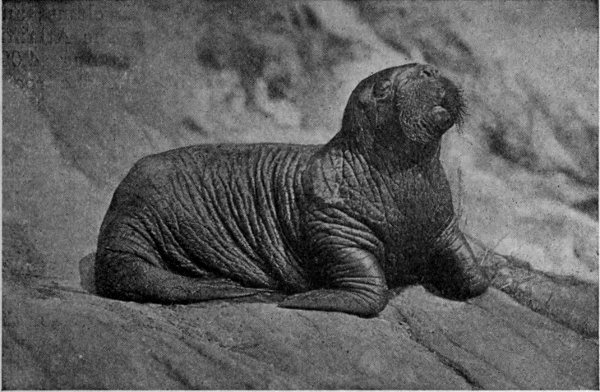
ATLANTIC WALRUS.
The Atlantic Walrus inhabits the arctic regions between America and Europe, and it is estimated that not more than ten specimens ever have been exhibited in captivity. Because of their unusual feeding habits, Walruses are very 80 difficult to keep alive. Their standard food is clams; and frequently clams are very difficult to obtain. The Atlantic Walrus grows to great size, probably exceeding 4,000 pounds in weight. The specimen exhibited in the rocky pool near the Reptile House was presented by Mr. Paul J. Rainey, in 1911, and has thriven continuously ever since its arrival. It was captured in Kane Basin, north of Baffin’s Bay.
The Harbor Seal, (Phoca vitulina), is the species common along our Atlantic coast, and since it serves so well as a type of hair seals, or true seals, it will occasionally be shown in the Park. In comparison with the active and vivacious sea-lion, it is a tame and rather uninteresting creature; but neither has any commercial value, save for the purposes of exhibition when alive.
The Primates are the four-handed animals belonging to the zoological order called by that name, which includes man, the anthropoid apes both great and small, the baboons, monkeys and lemurs. The word “monkey” is by no means sufficiently comprehensive to embrace all these forms. Were it otherwise, this building would be called, officially, the Monkey House.
The Primates include the creatures which stand nearest to man in the zoological scale, and in interest to all classes of humanity they stand above all others. There is no intelligent person, civilized or savage, to whom the humanlikeness of apes and monkeys does not appeal. On the other hand, some of the baboons are in feature and temper so thoroughly beast-like, their diabolism is almost as fascinating as the man-like character of the great apes. The variety of forms in the Order Primates, and the wide differences between the various groups, imperatively demand, for the proper representation of this Order, a large collection.
The Primate House was erected in 1901, at a cost of $65,000, and opened to the public on December 22d, of that year. It is 162 feet in length, 74 feet in width, contains 16 large interior cages, 22 small cages, and 11 exterior cages, two of which are of great size. The points of special excellence in this building are as follows: An abundance of room for the animals, an abundance of sunlight, perfect ventilation, an extensive series of open-air cages, freedom 81 of communication between outside and inside cages, floors and walls impervious to moisture and disease germs, and the absence of iron bars from all cages save three.
During the months of mild weather, all the inmates of the large interior cages occupy, at will, corresponding cages in the outdoor series. It is also intended that certain hardy species of baboons, and the red-faced monkey of Japan, shall be provided with comfortable sleeping quarters and live outdoors, every winter. It is believed that they can do this, not only with comfort, but with great physical benefit.
For general convenience, and the promotion of a universal understanding of the primates, we propose to set them forth in four groups, a subdivision strictly according to Nature, readily comprehended, and easily remembered They are as follows, with typical examples of each:
| I. Anthropoid Apes. | |||
|---|---|---|---|
| Chimpanzee | Anthropopithecus calvus | of | Africa. |
| Orang-Utan | Simia satyrus | “ | Borneo. |
| Gray Gibbon | Hylobates leuciscus | “ | “ |
| II. Old World Monkeys and Baboons. | |||
| Mona Monkey | Cercopithecus mona | “ | Africa. |
| White-Collared Mangabey | Cercocebus collaris | “ | “ |
| Magot: Barbary “Ape” | Macacus inuus | “ | N. Africa. |
| Japanese Red-Faced Monkey | “fuscatus | “ | Japan. |
| Pig-Tailed Monkey | “nemestrinus | “ | E. India. |
| Rhesus Monkey | “rhesus | “ | India. |
| Entellus Monkey | “entellus | “ | “ |
| Black “Ape” | Cynopithecus niger | “ | Celebes. |
| Golden Baboon | Papio babuin | “ | N. Africa. |
| Hamadryas | “hamadryas | “ | Arabia. |
| Mandrill | “mormon | “ | W. Africa. |
| Gelada | Theropithecus gelada | “ | Abyssinia. |
| III. New World Monkeys. | |||
| White-Throated Sapajou | Cebus hypoleucus | “ | S. America. |
| Red-Faced Spider Monkey | Ateles paniscus | “ | “ “ |
| White-Headed Saki | Pithecia leucocephala | “ | “ “ |
| Yarkee: Short-Tailed Monkey | Brachyurus calva | “ | “ “ |
| Squirrel Monkey | Chrysothrix sciurea | “ | “ “ |
| Common Marmoset | Hapale jacchus | “ | “ “ |
| Douroucoli | Nyctipithecus trivirgatus | “ | “ “ |
| IV. Lemurs and Lemuroids. | |||
| Ring-Tailed Lemur | Lemur catta | “ | Madagascar. |
| Indri | Indri brevicaudata | “ | India. |
| Galago | Galago galago | “ | Madagascar. |
| Slow Lemur | Nycticebus tardigradus | “ | Madagascar. |
| Aye-Aye | Cheiromys madagascariensis | “ | India. |
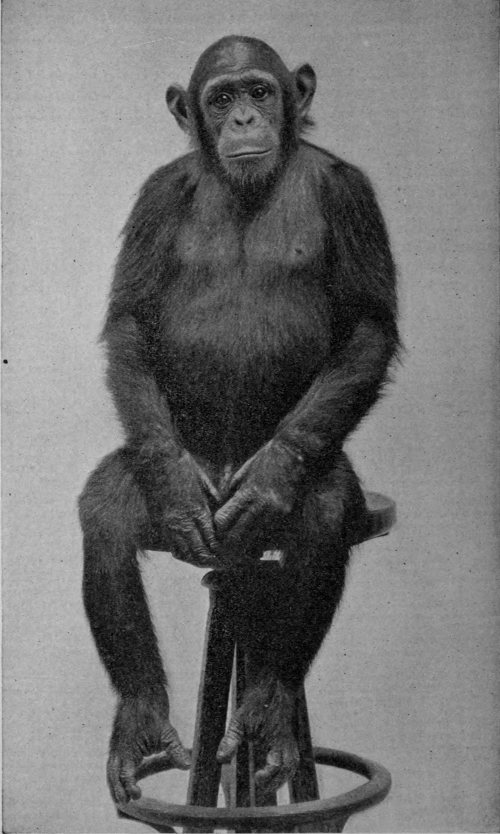
CHIMPANZEE BALDY.
Nearly all the above-named species are now living in the Primate House, besides which there are many others. So far as the available supply of captive primates will permit, these typical species will constantly be kept on exhibition, together with many others equally interesting. In this small volume it is possible to notice only the most important forms.
The Gorilla, (Gorilla savagei), of equatorial West Africa, is the largest and ugliest of the great apes, walks erect, and in form of body and limbs, it most resembles man. Its brain, however, is less man-like than that of the chimpanzee and orang-utan. It is very rarely seen in captivity. The only specimen which up to 1911 had reached America alive lived but five days after its arrival. Despite the fact that these creatures seldom live in captivity longer than a few months, they are always being sought by zoological gardens. The agents of the New York Zoological Society are constantly on the watch for an opportunity to procure and send hither a good specimen of this wonderful creature; and whenever one arrives, all persons interested are advised to see it immediately,—before it dies of sullenness, lack of exercise, and indigestion.
The Orang-Utan is intellectually superior to the gorilla, and is equalled only by the chimpanzee. Unfortunately, as a rule, none of the great apes are long-lived in captivity, and in zoological gardens they come and go. For this reason, it is seldom that an adult specimen, 4 feet in height, and weighing 150 pounds, is seen in captivity. Among other apes, the Orang-Utan is readily recognized by its brown skin, red hair and small ears.
In disposition this creature is naturally docile and affectionate. It is fond of the society of human beings, takes to training with wonderful readiness and success, and young specimens can easily be taught to wear clothes, sit at table, and eat with spoon and fork. In the summer of 1911, the daily open-air exhibition of nine apes dining at 4 o’clock on an elevated platform in the large outside cage at the Primate House, will long be remembered by the crowds of visitors who saw it. Such exhibitions are entirely germane to the educational purposes of a zoological garden or park, for they illustrate the mentality of animals and their wonderful likeness to man, far more forcibly than the best printed statements.
The north hall of the Primate House is specially intended for the anthropoid apes, and it is not likely that any 84 lengthy periods will elapse during which it contains neither orang-utans nor chimpanzees.
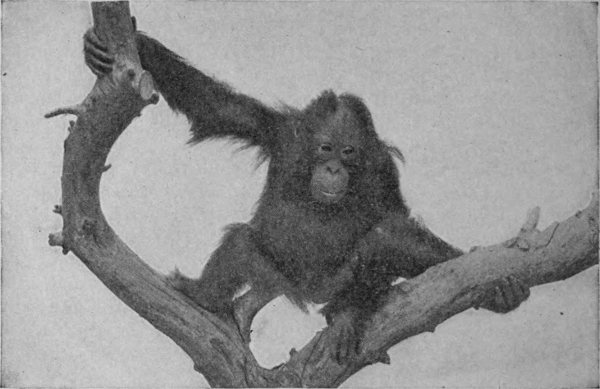
ORANG-UTAN.
The Chimpanzee, (Anthropopithecus calvus), of equatorial Africa from the west coast to the central lake region, is quite as common in captivity as the orang-utan. Both structurally and mentally this animal is very much like the orang-utan, and for keenness of intellect and susceptibility to training, it is second to none of the animals lower than man. A Chimpanzee is easily recognized by its black hair and large ears. There are two or three species.
The Gibbon shows off to poor advantage in a cage, but in the tree-tops it is a wonderful creature. It is like a long-armed skeleton clothed with skin and hair, animated by the spirit of an Ariel. In its home in the jungles of Borneo and southeastern Asia, it dwells in hilly forests, and never descends to the earth. When attacked, it flees down-hill, if possible, and it seems actually to fly through the tree-tops. It boldly flings itself forward through space, grasps with its hands the first available branch, swings underneath, feet foremost, and after another flight presently catches with its feet, thus actually making revolutions as it goes. Its progress is so swift and so silent that successful pursuit is impossible to any enemy not provided with wings.
This animal is naturally very timid, but does not hesitate to expose itself to mortal danger when its young are in 85 distress. In captivity gibbons are shy and nervous, and take life very seriously.
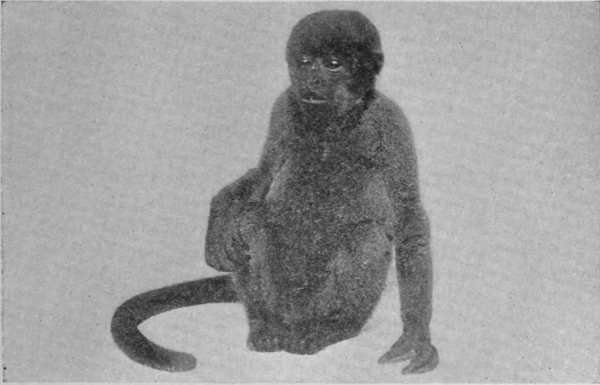
HUMBOLDT WOOLLY MONKEY.
The Baboons have been specially designed by Nature for life upon the ground, surrounded by dangerous enemies. But for their big canine teeth, their fierce tempers and bull-dog courage, backed by a fine combination of strength and agility, the lions, leopards, hyenas and jackals of Africa would have exterminated them all, ages ago. They were not formed to become hand-organ beasts of burden, nor even companions to man, but rather to fight off their enemies, and bluff even the king of beasts when occasion requires. In captivity, their strength and ferocity always inspires respect, and sometimes genuine terror. At all times they require to be treated as dangerous animals.
Of the various species of baboons on exhibition in the Primate House, the full-grown Mandrill is the most interesting, and wonderful. It seems like an animal not of this earth, and reminds the visitor of one of the great beasts of the visions of St. John the Divine. The home of this species is in West Africa, and it is found from Senegambia to the Congo. The long shaggy hair, lion-like appearance, the peculiar color markings of the face, and the indescribable grimaces, instantly fix the attention of every visitor.
The Hamadryas Baboon, with long side whiskers and cape of long hair, is one of the handsomest animals of this group. Its explosive, ear-racking cry is almost as startling to visitors as a cannon-shot.
The Golden Baboon has the liveliest disposition and the best temper possessed by any baboon. Young specimens are full of good-natured mischief, and are much given to hectoring their cage-mates. The Long-Armed Yellow Baboon is quite at home in the Primate House, and has bred here. It is a good species to keep in captivity.
The Group of Old World Monkeys, in addition to the baboons, contains several species worthy of special remark. There are some which have tails so very short and insignificant that they seem to be tailless, and several of them are called “apes.” They are not true anthropoids (manlike apes), however, and it is a confusing error to designate any of them as “apes.” The species referred to are the following:
The Black “Ape,” of Celebes, exceedingly like a true baboon.
The Magot, or Barbary “Ape,” of North Africa and Gibraltar, which is a true macaque.
The Japanese Red-Faced Monkey, another macaque, with a brilliant red face, and long, thick coat of hair, which enables it to live out of doors all winter, even in this Zoological Park.
The Pig-Tailed Monkey, several species of which are found in Burma and other portions of southeastern Asia.
All the above are on exhibition in the Primate House, and the outdoor cages.
The Rhesus Monkey, of India, is one of the sacred species, and ages of immunity from molestation, or even wholesome discipline, have made this animal aggressive and domineering in temper.
The Bonneted Macaque is the best-tempered monkey of all the monkey species found in the East Indies, and it is by far the best to keep as a pet.
The Entellus Monkey, of India, is also a sacred species, and its natural seriousness of manner, and dignified bearing, quite befit the direct descendants of the original Hunuman, or monkey deity of the Hindoos, who helped to build Adam’s Bridge.
Of the many African monkeys, some of the most showy (such as the Guerzas and Colobos) are so difficult to procure they can not be set forth as permanent residents in the Primate House. The following species, however, may be classed with the reliables:
The White-Collared Mangabey and Sooty Mangabey are both so lively, so good-natured, and so free from the fighting habit, they are prime favorites with everybody.
The Mona Monkey is handsome and easily kept, and an excellent representative of the great African genus Cercopithecus.
The Green Monkey and the Vervet are lively but quarrelsome, and at times become dangerous. The Patas, or Red Monkey, is very sedate, and makes a good cage-mate for the mona.
The New World Monkeys, even at their best, never make a strong showing in a vivarium. The trouble is that many of the most interesting species are so delicate it is impossible to keep them alive in captivity. Fame awaits the man who can discover a bill of fare on which Howling Monkeys, Sakis and Yarkees can live in captivity to old age, and repay their cost and care. Their digestive organs are delicate, and are subject to derangement from causes so slight they can not be reckoned with.
The Sapajous are the hardiest, the most intelligent and in some respects the most interesting of the New World monkeys. They all possess the prehensile (or grasping) tail, which is not found on any Old World monkey, and the use made of it is a constant source of wonder. Monkeys of this species are quite common in captivity, and their wrinkled brows and serious countenances give them an appearance of being burdened with cares,—which most captive monkeys certainly are! These are the unfortunate creatures which so often come to grief on hand-organs.
The Black Spider Monkey and the Gray Spider Monkey represent a genus of animals quite as attenuated in form as the gibbons. Their slender bodies, exceedingly long and slender legs and tail,—the latter strongly prehensile, and better than a fifth arm and hand,—give them when in the tree-tops an appearance truly spider-like. They are agile climbers, but not rapid runners, and having no means of defense are very timid. Their stomachs are so simple they seem to lack some element or function that is necessary to 88 the life of the animal in captivity. Notwithstanding the fact that “Jess,” of Bath, New York, in defiance of all laws and precedents, lived thirteen years in a cold climate, the great majority of spider monkeys die before they reach full maturity, and nearly always of stomach troubles. Fortunately, however, there are exceptions to this rule.
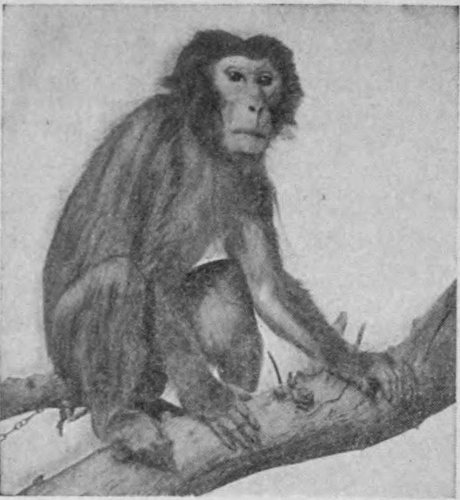
JAPANESE RED-FACED MONKEY.
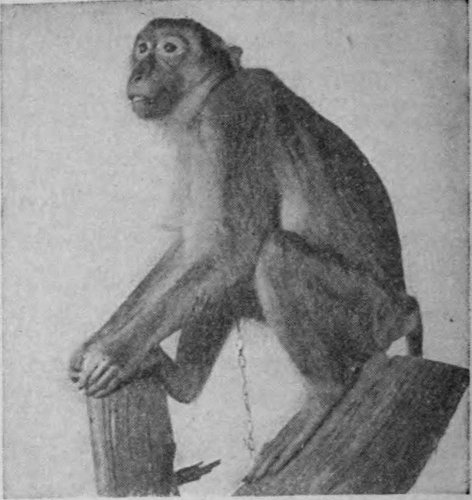
PIG-TAILED MACAQUE.
The Squirrel Monkey, often called a “Marmoset,” is a pretty little olive-yellow monkey, almost as delicate as the true Marmoset, and the Pinche. These diminutive creatures are so delicate they require the greatest care and tenderness, and thrive better in moderately small cages than in large ones. True marmosets are the smallest of American primates, being next in size to the Tarsier, of Borneo, smallest of all quadrumanes.
The Lemurs and Lemuroids.—A lemur is a monkey-like animal belonging to the lowest group of primates, but in some respects is so little like a typical monkey that the relationship is not always apparent. There are about thirty species, and all save a very few are found on the Island of Madagascar. They are gentle-spirited, harmless and inoffensive animals, and not being persecuted by their human neighbors, as all American wild animals are, they are quite numerous.
Nearly all the Lemurs have long tails, long and fine hair, large eyes and pointed muzzles. Many of them are strikingly colored in various shades of black, white and gray. All Lemurs are supposed to be of nocturnal habit, and in fact they really are; but the specimens in the large jungle cage of the Primate House are quite as lively and interesting 89 in the daytime as most of the monkeys. So far from manifesting a disposition to retire to dark corners, they love to lie in the sunshine.
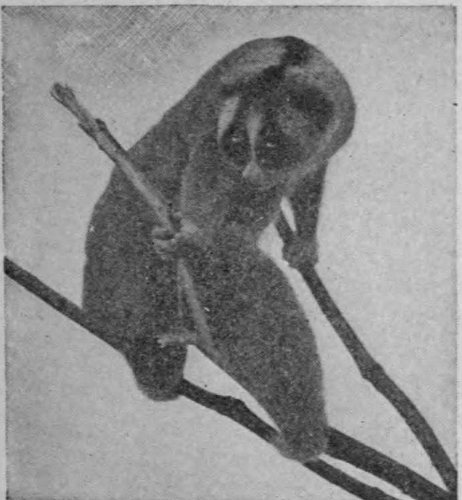
SLOW LEMUR.
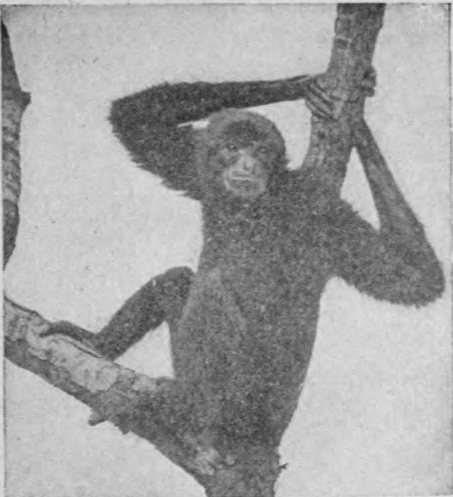
SIAMANG.
The Ruffed Lemur, or Black-and-White Lemur, (Lemur varia), is the handsomest member of this entire group. Its fur is very long, silky, and alternately pure white and jet black. The Ring-Tailed Lemur has a very long, pointed tail, ornamented with about 25 alternating rings of brown and gray, which it carries very gracefully. This species is of a more lively disposition than most others. The curious Indri has not up to this time come into the collection, but it is expected in the near future. When it arrives it can at once be recognized by the entire absence of a tail, except a mere stump, and by its large hands and feet.
Of its buildings for animals, the Elephant House is the culminating feature of the Zoological Park, and it comes quite near to being the last of the series. In token of these facts, it is fittingly crowned with a dome. Through its position in the general plan it closes a wide gap, and effectively links together the northern and southern halves of the establishment.
The erection of this great structure began in 1907, and the building was completed and its inmates housed in the fall of 1908. The yards surrounding the structure were finished in 1909.

ELEPHANT HOUSE.
Any building which can comfortably accommodate a representative collection of the largest of all living land animals, must unquestionably be large and substantial. There is no pleasure in seeing a ponderous elephant chained to the floor of a small room, unable even to walk to and fro, and never permitted to roam at will in the open air and sunlight. It is no wonder that dungeon-kept elephants go mad, and do mischief. If an elephant—or for that matter any animal—cannot be kept in comfortable captivity, then let it not be kept at all.
The Elephant House of the City of New York is a large and roomy structure, built to render good service for two centuries. Its extreme length over all is 170 feet, and its width is 84 feet. Its two sides are divided into 8 huge compartments, of which 4 are for elephants, 2 for rhinoceroses, and 2 for hippopotami. Each of these is 24×21½ feet.
The Hippopotami have within the building a tank 24×21 feet, and 8 feet in total depth; and another will be constructed in their corral.
Each end of the building furnishes two cages of smaller dimensions, for tapirs, and young elephants. The whole area surrounding the building, excepting the axial walk, is devoted to open-air yards, so arranged that each cage in the interior connects directly with a corral which affords both sunshine and shade. Nature seems to have made this beautiful open grove—strangely free from trees in its center—especially for the purposes to which it now is devoted.
It is by no means the intention of the Zoological Society, that, because an axial walk leads through the Elephant House, the building shall be used as a thoroughfare for foot traffic between the northern and southern portions of the Park. Such use would surely defeat the main purpose of the structure. It is intended to be entered only by persons who desire to see the animals, and all others must pass around it, by one or the other of the two very direct promenades which will be provided. The employees of the Park are strictly forbidden to consider the walk through the building as a convenient highway, and visitors are requested to observe the obvious necessities of this case.
The Indian Elephant, (Elephas indicus), is the universal elephant of captivity, the African species being shown only as a great rarity. For every elephant that comes from Africa, about thirty come from India, and of those about twenty-nine are prosy and unromantic females. In order to secure a male Indian Elephant, it must be specially ordered.
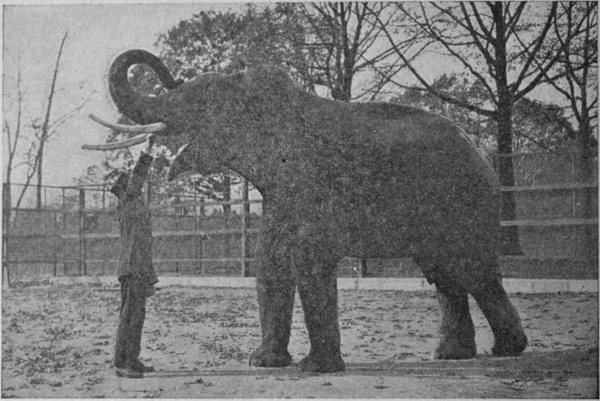
INDIAN ELEPHANT.
Our first Indian Elephant, a fine male named “Gunda,” was caught wild in the interior of Assam, northeastern India, and he arrived at the Zoological Park in May, 1904, as the gift of Col. Oliver H. Payne. He was then about seven years old. He stood 6 feet 7 inches in shoulder height, weighed 3,740 pounds, and had all the points of a “high-caste” elephant. His tusks were then 16 inches long. He is very mischievous about breaking anything in his quarters that is breakable, and he manifests special dislike toward certain individuals who come near him. Like most Indian elephants, “Gunda” is very intelligent. In two days he was taught to receive pennies, lift the lid of his “bank,” drop the coin within, and ring his bell.
Since his arrival here, in May, 1904, he has grown in height at the rate of about 5 inches each year. On November 1, 1910, he stood 8 feet 9 inches in shoulder height, his weight was 8100 pounds, and his tusks were 36 inches long.
The Sudan African Elephant, (Elephas oxyotis, Matschie), is the largest of the four species of African elephants now recognized. The other species are the South African Elephant, (E. capensis), the German-East-African Elephant, (E. knochenhaueri), and the West African Elephant, (E. cyclotis).
After some years of waiting, and many futile efforts, we have at last come into possession of a pair of young Sudan Elephants, representing, so we believe, the great species to 93 which belonged Jumbo, and also the bearer of the enormous tusks presented to the Zoological Society by Mr. Charles T. Barney. Like all elephants newly arrived from Africa, they are young, and small; but if they have good health they will grow very rapidly, and about A. D. 1927 they should attain full stature,—11 feet at the shoulders for the male, or thereabouts.
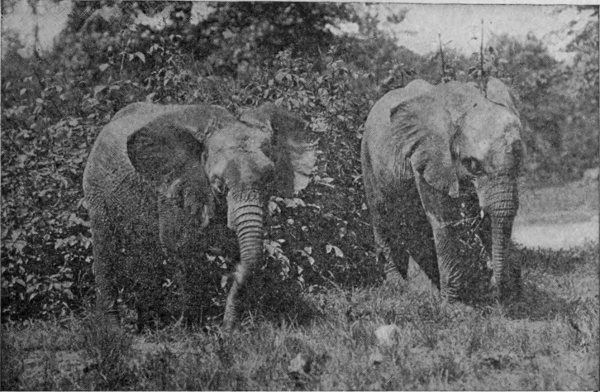
AFRICAN ELEPHANTS.
The different species of elephants are most easily recognized by their ears. Compare the enormous “sail-area” of the ears of this species with the small, triangular ear of the Indian elephant, and the small, round ear of the next species.
The West African Elephant, (Elephas cyclotis), of equatorial West Africa, especially the Congo country, is apparently a small species, not exceeding seven feet in height, even if that height is ever attained. Mr. Carl Hagenbeck reports that out of nearly 300 pairs of tusks of this species examined by him in the German ivory market, not one pair exceeded two feet in length, and many measured only 10 inches.
On July 25, 1905, we received a male specimen representing this species, as a gift from Mr. Barney. It is strikingly marked by its small round ears, and the presence of 5 toes on each fore-foot and 4 on the hind foot, the number in the East African species being 4 and 3, respectively. At the time of its arrival, little “Congo” stood 43 inches in shoulder height, his weight was precisely 600 pounds, and his tusks 94 were 4 inches long. On June 1, 1911, his shoulder height was 60 inches, and his weight was 1650 pounds, and his tusks were 23 inches long.
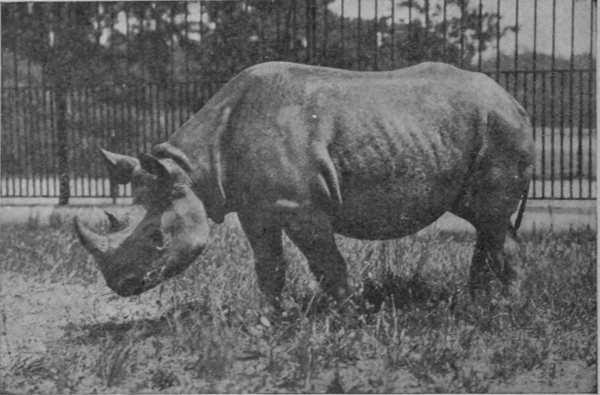
AFRICAN TWO-HORNED RHINOCEROS.
Regarding the life history and distribution of this odd species, much remains to be ascertained; and precise information is greatly desired.
The African Two-Horned Rhinoceros, (Rhinoceros bicornis), is already represented by a female specimen which was acquired in 1906. “Victoria” was captured in July, 1905, in the northern point of German East Africa, within about sixty miles of the head of Speke Gulf, which is the southeastern arm of Lake Victoria Nyanza. The elevation is between 4,000 and 5,000 feet. She was slung under a pole, and carried, six days’ journey on men’s shoulders, to the shore of the lake.
From thence she was transported by steamer to Port Florence, at the head of the Uganda Railway, thence by rail 500 miles to Mombasa. Ever since her arrival in New York, “Victoria” has developed rapidly. Captivity does not seem to fret her in the least. She is very docile, is very friendly toward her keeper, and it is quite apparent that she enjoys herself.
The African Two-Horned Rhinoceros once was very abundant throughout the whole of the fertile plains region of east and south Africa, but the onslaughts of hunters have exterminated it from probably nine-tenths of the territory 95 that it once occupied. To-day, the Englishmen of Africa are earnestly endeavoring to regulate and abate the slaughter of African big game, and beyond doubt safe, good results in that line are being accomplished. It is to be hoped that the protection lines will now be drawn so tightly around the game that remains that it will be perpetuated for centuries to come.
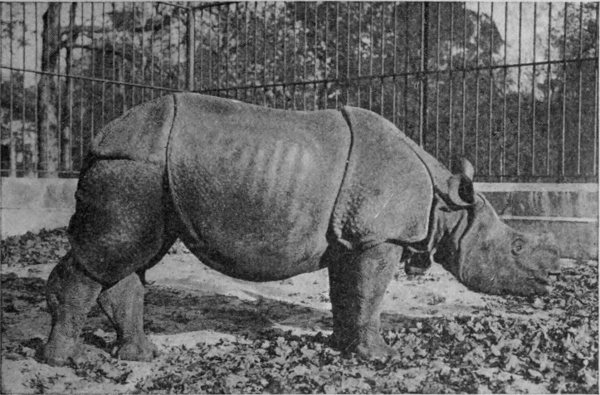
INDIAN RHINOCEROS.
The Indian Rhinoceros, (Rhinoceros unicornis).—A full-grown Indian Rhinoceros is one of the most wonderful of all living animals. It seems like a prehistoric monster, belonging to the days of the dinosaurs, rather than a creature of to-day; and the killing of so grand a creature solely for the sake of “sport,” and a stuffed head to hang upon a wall, is murder, no less. It is quite time that the most wonderful works of animated Nature should universally be recognized as safe from attack with the rifle and knife.
So pronounced is the rarity of the great Indian Rhinoceros, it is a fact that for nearly fifteen years no living specimens came into the wild-animal market. At last, however, the persistence and industry of the renowned Carl Hagenbeck was rewarded by the capture, in 1906, of four young specimens, all of which reached Hamburg in May, 1907. One of the best specimens of the quartette was purchased for the New York Zoological Park, and is now living in the Park in the quarters prepared for him at the Elephant House.
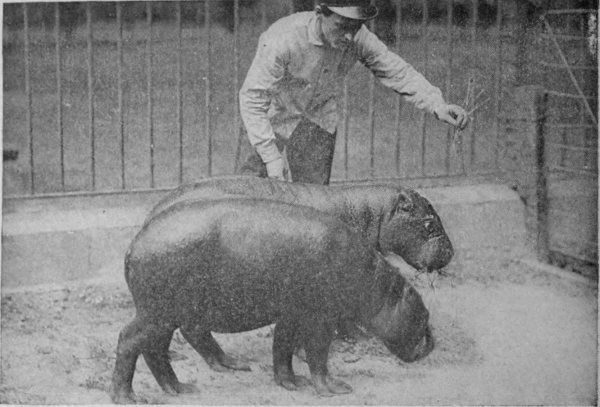
PYGMY HIPPOPOTAMI.
The Indian One-Horned Rhinoceros is the largest of all living rhinoceroses. A full-grown male is about 5 feet, 6 inches in shoulder height, and 10 feet 6 inches long from end of nose to root of tail. The length of the horn is not great, rarely exceeding 12 inches. The skin is very thick, and lies upon the animal in great rigid slabs which are divided by articulating areas of thinner skin.
The Hippopotamus, (Hippopotamus amphibius), is more frequently seen in captivity than any of the large rhinoceroses, or the African elephant. In the lakes and large rivers of central East Africa it still exists in fair numbers, and still is killed for “sport.”
Strange as it may seem, this very inert and usually lethargic monster can, under what it deems just provocation, become very angry, and even dangerous. Four years ago, in one of the rivers of Uganda, a hippopotamus not only overturned a boat, but killed one of its native occupants by biting him.
The Hippopotamus breeds readily in captivity, even under poor conditions, and the supply for the zoological gardens of the world is chiefly maintained in that way. The fine male specimen exhibited in the Zoological Park was purchased from the Central Park Menagerie, for $3,000, and is a gift from Mr. Samuel Thorne. He was born on July 13, 1904. His weight on November 1, 1909, at five years of age, was 3,114 pounds; and he is growing rapidly.
The Pygmy Hippopotamus (Hippopotamus liberiensis), is a great zoological novelty, and second in rarity only to the okapi. Thus far only five specimens ever have been exhibited. An adult Pygmy Hippo is only one-fourteenth the size of an adult Nile Hippo. Our three specimens, a female and two males, are exhibited in the Elephant House. They arrived in 1912, and were captured in Liberia, West Africa. The cost price of the trio was $15,000. They have excellent appetites, never have been ill, and they seem to enjoy their new home. Their habits, capture, and their home surroundings have been fully described in the Bulletin (No. 52) and the Annual Report for 1912 of the Zoological Society.
The Pygmy Hippopotamus is far more widely distributed throughout Liberia than might be inferred from the surprising scarcity of specimens in museums, and the long absence of the species from zoological gardens. It is an inhabitant of swampy forests, and while it frequents rivers it is not confined to them, like the large hippo. It seeks shelter from molestation in large cavities in river banks, usually under the roots of overhanging trees. These specimens were caught by digging pits in their runways, with sides so steep that the captives could not climb out. After capture, each animal was placed in a huge basket crate, slung under a pole, and carried by natives over the rough forest trails to the nearest river transportation.
The Tapirs.—Near the end of the Order of Hoofed Animals, (Ungulata), is found the Tapir Family, represented in both the old world and the new, by about five species. These very odd creatures inhabit the densest forests of the tropics, where vegetation grows rankly, and few other large hoofed animals can live. They are very fond of water, and swim well.
The South American Tapir, (Tapirus terrestris), takes kindly to captivity, breeds in confinement, and always manages to look well-fed and as sleek as a seal. Its color is a rich mahogany brown, and its long, prehensile nose is strongly suggestive of the end of an elephant’s trunk. The shoulder height of a full-grown animal is about 37 inches. This species inhabits Venezuela, the Guianas, Brazil, Paraguay, Uruguay and some other regions of South America. Some of the Central American Tapirs inhabit mountain regions, but all are exceedingly wary, and difficult to find without dogs.
The Malay Tapir, (Tapirus indicus), of the Malay Peninsula and Sumatra, may be recognized as far as it can be seen, by its colors. The front half of the animal, and its legs, are black or dark brown, and the rear half of the body is white. It is much larger than the preceding species.
At the northeastern corner of the Elk Range there is a huge, bare granite rock, two hundred feet long, shaped precisely like the hump of a bull buffalo. The high end of the hump is toward the north, and its crest is about fifteen feet above the ground on its eastern side. A fringe of small trees and bushes grows along its western side. On the east side, well sheltered by the rock itself from the cold west winds of winter, and also shaded by several fine trees which most opportunely grow close beside the ledge, the Wolf Dens and Fox Dens are situated.
In regard to the iron work, these dens are merely an understudy of the Bear Dens. The dimensions of each den of the series are 16 by 48 feet, and the height of the bars to the top of the overhang is 9 feet 6 inches. The sleeping dens are of simple construction, all save one being of wood, trimmed with bark-covered slabs. At present the Wolf Dens are divided into four compartments.
The Gray Wolf, (Canis nubilis), is known by as many names as it has color phases. In the North, where it is white, it is called the “White Wolf,” while in Florida it becomes the “Black Wolf.” In British Columbia and around Great Slave Lake, both white and black wolves abound, as well as the standard gray, but on the Barren Grounds the white phase predominates. In Texas a “Red Wolf” is found, but apparently the red phase is of somewhat rare occurrence, and is never found in the North.
In the West this animal has recently come into prominence in a way that is striking terror to the hearts of ranchmen and others who have stock to lose. While all kinds of desirable game animals are decreasing at an alarming rate, the Gray Wolf not only holds its own, but is multiplying rapidly. The destruction by it of calves, colts and sheep, has become so great that nearly every western State has placed on the head of this bold marauder a bounty varying from $2 to $10. In some States this law 99 has been in force for several years, but with no sensible diminution in the number of wolves.

TIMBER WOLF.
The Gray Wolves which live in touch with civilization are by no means such bold and dangerous animals as they formerly were. In the early days, when wolves were numerous and fire-arms few and primitive, the Gray Wolf undoubtedly was a dangerous animal. But the breech-loading rifle has changed all this. Excepting for his stock-killing propensities, the Gray Wolf is now a skulking creature. In the United States this animal possesses the courage of a coyote, but in the Barren Grounds it is still fierce and dangerous. However much the wolf may skulk and flee when the way is open, when brought to bay he knows how to fight. One snap of his powerful jaws and shear-like teeth is enough to disable almost any dog, and send it howling to the rear. It is no wonder that western dogs of experience are shy of approaching a Gray Wolf within snapping distance.
Excepting the localities from which it has been driven out by civilization, the Gray Wolf ranges over the whole North American continent from central Mexico to 83° 24′ N.
The Coyote, or Prairie Wolf, (Canis latrans), is a personal acquaintance of nearly every trans-continental traveler. To those who have camped on the “plains,” he is quite like 100 an old friend; and the high-pitched, staccato cry—half howl and half bark—with which he announces the dawn, is associated with memories of vast stretches of open country, magnificent distances, sage-brush and freedom. Because of his fondness of barking, Thomas Say, the naturalist who first described this species, christened it, Canis latrans, which means “barking wolf.”
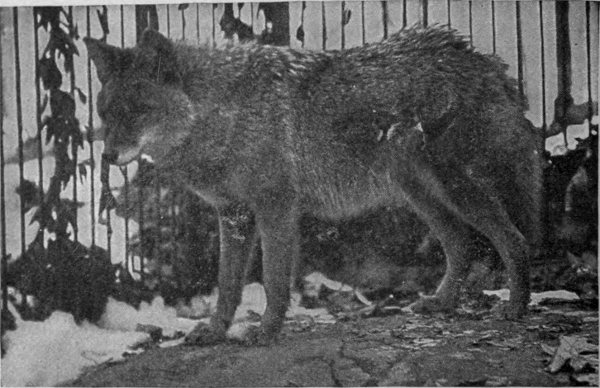
COYOTE: PRAIRIE WOLF.
This animal averages about one-third smaller than the gray wolf, and while the finest male specimens are, in the autumn, really handsome animals, at other times the majority are of very ordinary appearance. At no time, however, even in the dark, is a Coyote a courageous animal. So far as man is concerned, a band of a thousand coyotes would be as easily put to flight as one; but in hanging upon the ragged edges of civilization, and living by its wits, the Coyote is audacity itself. By inheritance, and also by personal experience, this animal knows to a rod how far it is safe to trust a man with a gun. If the hunter has left his gun behind him, the Coyote knows it at once, and boldly flaunts himself within stone’s throw of his enemy.
The Coyote varies in color quite markedly, exhibiting the gray, brown and black phases. Formerly it was supposed that one species comprehended all, but Dr. Merriam’s series of specimens from all parts of the West and Southwest have led him to separate these animals into eleven species.
Of the many species of foxes found in North America, three species stand forth as the types of prominent groups, and it is very desirable that all three should be well known.
The Red Fox, (Vulpes fulvus), is the representative of the group which contains also the cross fox and black fox of the Northwest. In spite of dogs, traps, guns, spades and poison, this cunning creature persists in living in close touch with the poultry yards of civilized man. His perfect familiarity with old-fashioned dangers enables him to avoid them all, and no sooner does a new danger menace him than he promptly invents a way to escape it. The manner in which the Red Fox lives with civilization without being exterminated really is surprising, and speaks volumes for the astuteness of this animal.
The geographical range of the Red Fox is very wide, From North Carolina and Tennessee it extends northward through the whole northeastern United States, gradually bearing westward to Montana, and northward almost to the Arctic Ocean. It is the commonest species in Alaska, where it is found practically everywhere.
The typical Red Fox and its two subspecies, the Cross Fox, (Vulpes fulvus decussatus), and the Black Fox, (V. f. argentatus)—the latter many times miscalled the “Silver Fox”—vary in all possible gradations of color from bright red to pure black. Often it is difficult to decide where one type leaves off and another begins. The Cross Fox stands midway between the Red and Black, with some of the yellow color of the former on the sides of the neck and behind the foreleg, while the remainder of the general color is grizzled gray-brown laid across his shoulders in a more or less distinct cross. The Black Fox varies in color from very dark iron-gray to dark brown or black, with a slight wash of white-tipped hairs over the head, body and tail. The tip of the tail is always white, which is the only constant color mark about him.
The Swift, or Kit Fox, (Vulpes velox), is the daintiest, smallest and liveliest of all American foxes. From his delicate little nose to the tip of his well-trimmed tail, he is every inch a thoroughbred. His countenance is bright and pert, and when several specimens are kept together they are very playful. One striking feature of this little animal is what may well be termed its trimness. When in 102 fair condition, its coat of thick, silvery gray fur is as smooth and even as if recently trimmed by a barber.
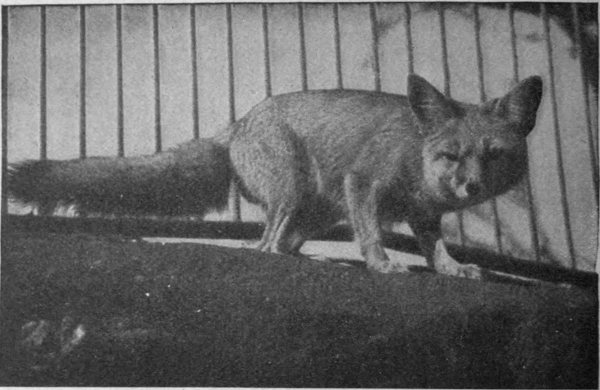
SWIFT OR KIT FOX.
On the western plains, where it once had for companions the buffalo and prong-horn, the Swift is becoming rare. Its worst enemy is the deadly strychnine bottle of the ranchman. This species does not thrive in the Fox Dens, and it will be found in the Burrowing Animal’s Quarters, where it seems pleased to consider itself at home.
In the Small-Mammal House is shown a new species, closely allied to the above, from Phoenix, Arizona, recently described by Dr. C. H. Merriam as Vulpes macrotis, or the Large-Eared Swift.
The Gray Fox, (Urocyon virginianus), is the fox of the South, even though it does range northward well into the territory of the red fox. This species is distinctly smaller and more lightly built than the red, its hair is not so luxuriant, it is more shy and retiring, and its colors change very little. When hotly pursued by dogs it often climbs trees that are quite perpendicular, to a height of twenty feet or more. In captivity Gray Foxes are forever trying to escape by climbing, instead of by burrowing, as would naturally be expected. In temper, they are treacherous to their keepers, and also to each other, and as “pets” are anything but desirable.
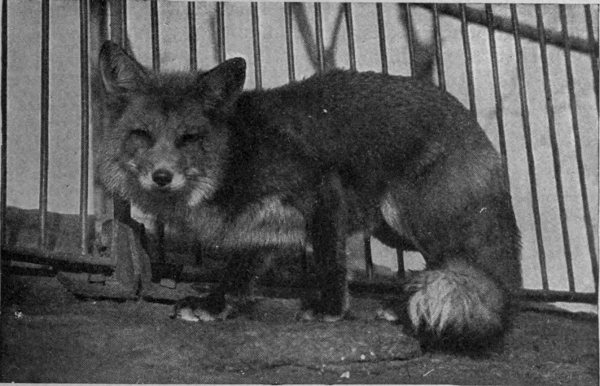
RED FOX.
The Tasmanian Wolf, or Thylacine, (Thylacinus cynocephalus), is a very strange-looking and interesting creature, about the size of a pointer dog. Its color is dark yellowish brown, and it has a series of broad black stripes, or bands, running across its hind quarters and loins. The wide gape of its mouth reminds one of an iguana or a monitor.
This animal, fully named above, is the largest of the carnivorous marsupials of Australia, and the female possesses an abdominal pouch in which she carries her young, like a kangaroo. It is now found only in Tasmania, and it dwells amongst rocks, in rugged and mountainous regions. Because of its depredations upon the sheep herds, the Thylacine has been diligently hunted and destroyed, and now living specimens rarely are taken.
In the zoological gardens of Europe and America, this species usually is kept in heated buildings, but it has been ascertained by experiment that this specimen thrives best in the open air. Living examples in captivity are now so very rare it is a difficult matter to keep one constantly on exhibition.
The American Otter, (Lutra canadensis), is unfortunate in being the bearer of valuable fur; and in the northern regions, where the cold causes the development of fur that 104 is available for the use of the furrier, this creature is so nearly extinct that trappers no longer pursue it. In the southern States, where its fur is short, rather coarse and “off color,” the Otter still is found. In some portions of eastern Florida, and along the coast of South Carolina, it is frequently taken. In captivity, it often becomes quite tame, even affectionate, and always is interesting. Unless closely confined, however, it is prone to wander, and meet premature death.
In captivity the Otter usually is active and restless, and very much in evidence. Owing to the strength of its jaws, its ability to climb under certain conditions and its restless activity, it is difficult to confine a full-grown Otter in anything else than a complete box of iron cage-work.
Few persons save woodsmen and naturalists are aware of the fact that in a wild state the Otter is a very playful animal, and is as fond of sliding down hill, over a wet and muddy slide, with a water plunge at the bottom, as any young person is of “shooting the chutes.” Like the small boy with the sled and a snowy hillside, the Otter sometimes indulges in its sliding pastime for an hour at a time, with a keen relish for the sport that is quite evident to all who have ever watched it.
The Otter is a carnivorous animal, and in a wild state lives upon fish, frogs, crabs, young birds, small mammals, and, in fact, about any living thing which it can catch.
The Coypu Rat, (Myopotamus coypu), of Central and South America, is interesting because of the fact that it is the largest of all rats or rat-like animals. In its habits it is as fond of water as the musk-rat. It is sufficiently clothed with fur to endure outdoor life in the Park, even in winter, and it has been acclimatized here in one of the other pools. It breeds persistently, and thrives in captivity, provided it is treated as it should be.
The new Small-Mammal House, erected and occupied in 1905, is a very different structure from the temporary building which formerly occupied the site. The present building is a twin of the Ostrich House, and in it much effort has been expended in devising ways and means to keep its living inhabitants clean, odorless and in good health. Owing, however, to the musky odors secreted by many of the civet 105 cats and members of the Marten Family, it is beyond human power to keep a large collection such as this building contains without a certain amount of wild-animal odor.
Most difficult of all collections to settle satisfactorily in a modern zoological park or garden is the great omnium gatherum of small species—and some large ones, also—which fall within the meaning of the term “small mammals.” The number of mammalian miscellanea which can not have buildings all their own is really very great. In addition to that there are always with us a considerable number of young and tender animals which require small quarters, and close attention. The visitor will therefore always find in the Small-Mammal House a great array of viverrine animals, of tropical squirrels and other small rodents, of mustelines, the nasuas, the small marsupials, young leopards, the lynxes and their relatives, baby bears, and many other species.
Attention is invited to the great variety of cages in and around this building, of which there are five different types. The total number is 176. All those on the western side are adjustable as to their bottoms and sides, so that it is easy to throw several cages into one, and make cages either very long or very high. The idea of the collapsible cage, and also the general plan of it, has been copied from the model developed and in use in the Zoological Garden of Frankfort, Germany, by Director A. Seitz, to whom this acknowledgment is justly due. It will be noticed that every animal in this building enjoys the use of an outdoor cage, which connects directly with its interior quarters.
Of such an odd mixture of animals as we are now to consider, anything like a perfect systematic zoological arrangement is a practical impossibility; but as far as it is possible, we will take up the animals by groups.
On the whole, the most striking animals in the Small-Mammal House are the small cats and lynxes. Of the spotted cats, the Serval, (Felis serval), of Africa, is one of the rarest. Its long, slender legs, small head, slender body and round spots proclaim it a near relative of the cheetah.
The Clouded Leopard, (Felis nebulosa).—The dense and humid jungles of Borneo contain a beautiful tree-climbing leopard whose markings are laid on its sides in large, elliptical patches of pleasing pattern. This is the Clouded Leopard, so delicate in captivity that only one out of every four or five becomes acclimatized outside its native jungles. 106 Our fine adult specimen, with very long canine teeth suggestive of those of the saber-toothed tiger, really belongs in the Lion House, but we dare not move it, for fear the change would in some manner prove fatal to it. It is an animal of vicious temper, and makes friends with no one. The half light of its cage is a welcome approach to the dense shadows in which it lives when at home.
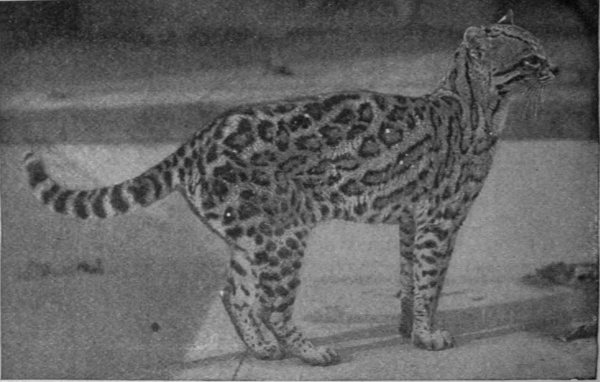
OCELOT.
The Jungle Cat, (F. bengalensis), is a small and inconspicuous type, as befits an animal which lives by stealth in densely populated regions. The Ocelot, (Felis pardalis), of South and Central America, is a small spotted cat which very often is called a “young jaguar.” In size it is the third largest Felis of the American continent; but for all that, it is so small that an adult specimen would not make more than one square meal for a hungry jaguar. It is found from southern Texas to southern Brazil.
The little Margay Cat, (F. tigrina), is our smallest and also rarest spotted cat. It is no larger than a good-sized domestic cat, and its tawny ground-color is marked all over with round spots. The rarest American feline in our possession is the queer, otter-like Yaguarundi Cat, (F. yaguarundi), of a uniform gray-brown color, without spots. It is found in southern Texas and Mexico, and is so seldom seen in captivity that comparatively few persons north of the Rio Grande are aware of its existence. Our specimen came from Brownsville, Texas.
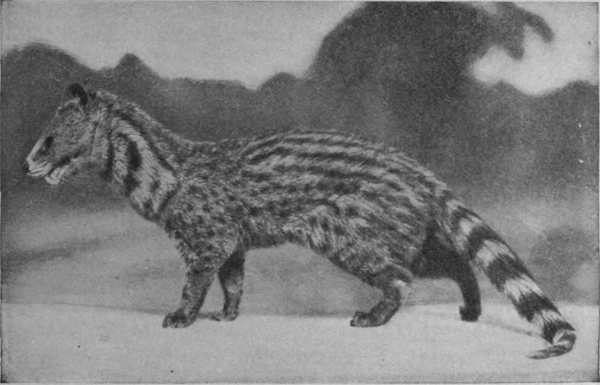
COMMON GENET.
The Bay Lynx, Red Lynx, or Wild Cat, (Lynx rufus), is the smallest of American Lynxes, and it is the one that inhabits the United States eastward of the great plains. Until further notice, this species will be found in the Small-Mammal House. It may have a few dark spots, or none at all. Its color varies so greatly that it is at times impossible to determine where this species leaves off, and the more heavily spotted subspecies of the southwest takes its place. The latter is known as the Spotted Lynx, (L. r. maculatus).
The large and important group of Viverrines, or long-faced cat-like carnivores of the East Indies, (Family Viverridae), is well represented. It is the true Civets which furnish—some of them—the evil-smelling civet of commerce—an odor which we would gladly do without. The Common Civet-Cat, (Viverra zibetha), is the best known member of this Family, and it is easily recognized by its large size, heavily-spotted body and ring-streaked tail. It is common throughout the Malay Peninsula, and in many other portions of the Malay Archipelago. The larger Malayan Civet-Cat, (V. malaccensis), strongly resembles its understudy, but its black spots and blotches are larger and more intense, and in form it is much more robust.
The large and handsome White-Whiskered Paradoxure, (Paradoxurus leucomystax), has been in the Park about six years, and to-day it coughs and snarls at the visitor just as it did in the beginning. It is a smooth-coated creature, 108 colored like a puma, and comes from northern China. Other members of the Family Viverridae contained in the collection are the Malayan Paradoxure, (P. hermaphroditus); the Black Paradoxure, (P. niger); the African Ichneumon, (Herpestes ichneumon), the strange black creature from the Malay Peninsula called the Binturong, or “Bear-Cat,” (Arctictis binturong), and the Suricate, or Slender-Tailed Meerkat, (Suricata tetradactyla), of South Africa.
Into the Small-Mammal House have drifted and comfortably settled down several canine species which are not so well satisfied, elsewhere. The Black-Backed Jackal, (Canis mesomelas), of Africa, is one of the most interesting, and it is also the one that thrives best in captivity. It is very much like a dark phase of the Azara Dog, of South America, and it is the handsomest of all the Jackals. The Cape Hunting Dog, of eastern Africa, has for years been present in this building, and it will be kept as continuously as circumstances will permit.
The New Mexico Desert Fox, (Vulpes macrotis neomexicanus), is a small understudy of the better known Swift or Kit Fox of the northern plains, but it has larger ears. Neither of these delicate little species seems to thrive in our large Fox Dens, which seem to be too large for them; but in this building they thrive and are quite content with life. The Swift Fox is the four-footed elf of the plains, and it is unfortunate that the poison laid for the fierce and cruel stock-killing wolves should prove its extermination—as it surely will, ere long.
The Arctic Fox, (Vulpes lagopus).—This creature of the polar world is a striking example of climatic influence on a species, and also of the danger that lies in describing a species from a single specimen. In the far north, the Arctic Fox is snow-white all the year round. Farther south it is white in winter, but in summer is bluish-brown. In the southern part of its range, the Aleutian Archipelago for example, except for an occasional white individual, it is dark all the year round, and is known only as the Blue Fox. At first it may seem difficult to believe that these two widely-different extremes are only color-phases of the same species; but it is quite true. The dark-colored animal is not even accorded subspecific rank.
On various islands along the Alaska coast, especially in the Aleutian Archipelago, about forty commercial companies are engaged in breeding Blue Foxes for their fur, some of 109 them with satisfactory success. The foxes are fed daily, on cooked corn meal and dried fish. They come up to be fed, and when the time comes to handle and sort them previous to killing the annual allotment, they greatly facilitate matters by the readiness with which they enter box traps.
The great decrease in the annual supply of good fur has caused many persons to hope that fox-breeding may be developed into a remunerative industry. Except in Alaska, no extensive experiments in that line have been made. It is quite desirable that fox-breeding in the United States should be taken up under state or national auspices, and worked out to a successful issue. There is good reason to hope and believe that it might be developed into an important industry.
From Argentina, South America, have come two fine specimens of the Azara Dog, (Canis azarae), which, but for their half dog-like tails might pass anywhere as rather odd-looking gray foxes. But they are a visible reminder of the fact that the pampas of South America contain an extensive series of foxes and wild dogs, which thus far is practically unknown everywhere north of the Amazon.
The Dingo, or Australian Wild Dog, (Canis dingo), is represented by two specimens which look like ordinary yellow dogs. By many persons it is believed that this animal was not indigenous to Australia, and was planted there by man, but the evidence in support of that supposition is by no means conclusive.
The Coati-Mundi, (pronounced coy-ty mon-day), is for its size one of the best exhibition animals that can be found outside of the Primate House. It is closely related to our raccoon, but is far more showy and interesting. It has a very lively and industrious disposition, is a good climber, and from dawn until dark is almost constantly on the move. Although it is a carnivorous animal, and provided with powerful canine teeth, it is not naturally quarrelsome, but on the contrary is quite gregarious in its habits. The genus Nasua inhabits Mexico, Central and South America. We have two species, the Red Coati-Mondi, (Nasua rufa), and the White-Nosed, (N. narica).
The Raccoon Dog, of Japan, (Nyctereutes procyonoides), is to all outward appearances a raccoon, but its feet are digitigrade, not plantigrade, and it is a true dog.
The American Badger, (Taxidea americana), is represented by a fine, large and very light-colored specimen that was presented by President Roosevelt. The European Badger, (Meles taxus), is shown near by.
Our collection of Rodents contains the following important and representative species of squirrels:
| North American. | |||
|---|---|---|---|
| Gray Squirrel | Sciurus | carolinensis | New York. |
| Black Squirrel | “ | “ | Ohio. |
| Fox Squirrel | “ | ludovicianus | Kansas. |
| Southern Fox Squirrel | “ | niger | Louisiana. |
| Red Squirrel | “ | hudsonius | New York. |
| Eastern Chipmunk | Tamias | striatus | “ |
| Western Chipmunk | “ | speciosus | California. |
| Parry’s Spermophile | Citellus | parryi | Alaska. |
| Thirteen-Lined Spermophile | Spermophilus | tridecem-lineatus | Iowa. |
| Foreign Species. | |||
| Malabar Hill Squirrel | Sciurus | malabaricus | S. India. |
| Indian Hill Squirrel | “ | bicolor | N. India. |
| Prevost Squirrel | “ | prevosti | Malayana. |
| Golden-Bellied Squirrel | “ | aureogaster | Mexico. |
| Columbia Fire-Backed Squirrel | “ | variabilis | S. America. |
No collection of Rodents is worthy of acceptance by the public without a fair representation of Porcupines. The most wonderful species is the African Porcupine, (Hystrix cristata), which when disturbed erects a threatening array of enormously-long, shining black-and-white quills that are a wonder to behold. The lofty white crest of this animal is one of its most conspicuous features.
The Indian Crestless Hill Porcupine, (H. longicauda), usually present in our collection, is merely a quiet understudy of the former. Strange to say—and also provoking—our old friend of the North Woods, the Canada Porcupine, (Erethizon dorsatus), is much more capricious and difficult to keep for a long period than either of the fine foreign species already mentioned. It is only the men who know all about animals who can tell us why nothing seems to exactly satisfy them, and why they will not breed here, live ten years and be happy. Even the best cage life does not seem to be good enough for them; but we are still experimenting.
In order that visitors to the Park may at all times be able to see a Beaver, (Castor canadensis), and not be thwarted in that desire by the very shy habits of the animals 111 in the Beaver Pond, we have a specimen on exhibition in the Small-Mammal House. This individual came from the Rio Grande, as a small kit, and has been reared in its present quarters. It is kept constantly supplied with food--wood, chiefly of poplar and maple, and clean water in which to bathe.
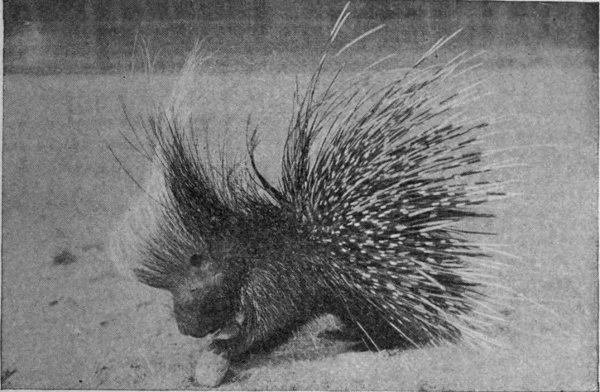
AFRICAN PORCUPINE.
The Capybara, (Hydrochaerus capybara), is the largest of all gnawing animals, and the most remarkable rodent in our collection. In form and size it suggests a large, gray, coarse-haired pig. It is a water-loving animal, of the American tropics, and lives on the grassy banks of the delta of the Orinoco, and similar places farther south. It is one of the best divers of all land animals, and when attacked on land always plunges into the water and dives for about 100 feet before coming to the surface. It is strictly a vegetable feeder, and its flesh is very palatable food. It takes kindly to captivity, and in disposition it is very affectionate.
The Agouti, (Dasyprocta), is to the jungles of South America as the cotton-tail rabbit is to the forests of the eastern United States; but structurally it is not closely related to the members of the Rabbit Family. It lives wholly on the ground, in dense cover, and is very difficult to shoot. As a rule, it is impossible for dogs to catch it because it runs so swiftly through the dense cover that they cannot keep it in sight. There are a number of species, varying in color from dark brown to golden yellow.
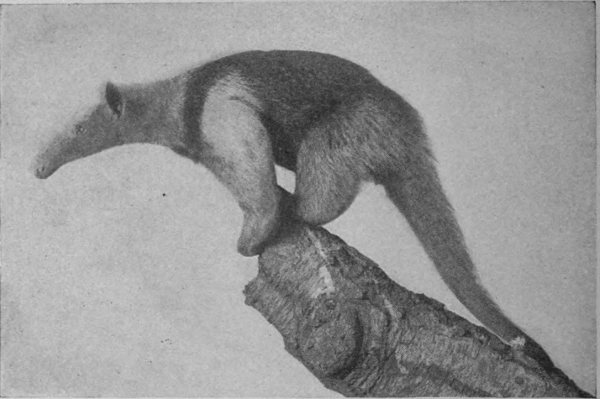
TAMANDUA.
The Toothless Mammals.—The Order Edentata contains some of the most odd and remarkable mammals that ever find their way into a zoological park. They are the armadilloes, ant-eaters and sloths. Without exception, they are delicate feeders, and difficult to keep for long periods, and for this reason the number on exhibition constantly varies between half a score and none at all! As far as it is possible, the species named below will be kept on exhibition; but these rarities are difficult to obtain, and the supply must be regarded as intermittent.
The Nine-Banded Armadillo, (Tatu novemcinctum), of southern Texas and Arizona, and southward, is the only edentate found in the United States. Its total length, from nose to tail-tip, is about 26 inches, and it is about as large as an opossum. Its strangest feature is the horny shell, with 9 jointed bands in the middle, which Nature has designed for the animal’s protection. It lives in burrows in the earth, and in a wild state it feeds on a mixed diet of worms, ants, snails, beetles, grasshoppers and other insects.
The Six-Banded Armadillo, (Dasypus sexcinctus), of South America, has a much stronger and more bony shell than the preceding species, but very similar habits. The Three-Banded Armadillo, (Tolypeutes tricinctus), is the most remarkable of all—and also the most difficult to obtain. It is able to convert itself into a round ball covered at all 113 points by bony armor, and remarkably well protected from the teeth of predatory animals.
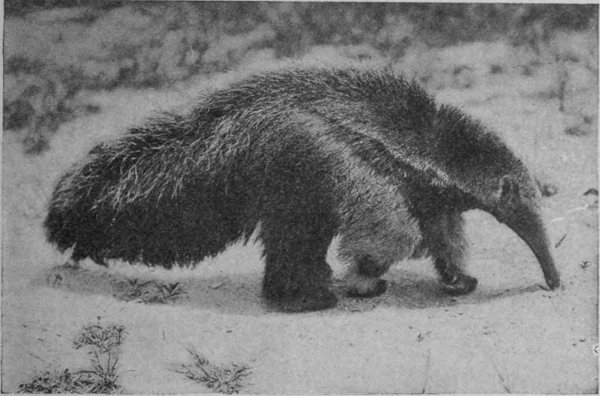
GREAT ANT-EATER.
The Great Ant-Eater, (Myrmecophaga jubata).—This is a very remarkable animal, and usually is to be found alive in the Small-Mammal House. Its anatomical peculiarities are apparent at a glance. Its toothless jaws are enormously elongated, and taper to a rounded point, where the mouth opens as a narrow slit, scarcely large enough to admit the large end of a lead pencil. Its front claws are large and strong, for use in tearing open ant-hills and decayed logs; and the creature walks upon them as if club-footed. Its tail is long and thick, and bears a luxuriant brush, of coarse, wavy hair more than a foot long. The negroes of British Guiana gravely inform travellers that the Ant-Eater uses his bushy tail as a broom, with which he sweeps up ants in order to devour them wholesale.
As may be inferred from the total absence of teeth, this strange creature lives chiefly upon crawling insects. In devouring the dreadful ants, which in a South American forest often make life a burden, it helps to preserve the balance of Nature. In captivity the food of this animal consists of milk, raw eggs and ground meat. In taking its food it thrusts out from four to eight inches of round, wormlike tongue, which contrary to many published statements, is not covered with sticky saliva.
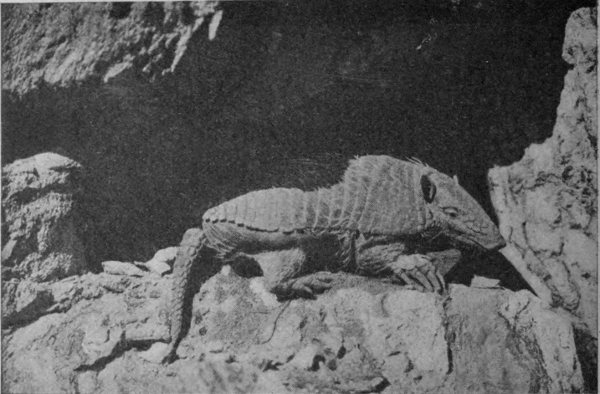
SIX-BANDED ARMADILLO.
The Tamandua, (Tamandua tetradactyla), is a smaller ant-eater than the preceding species, of tree-climbing habits, with a proportionately shorter head, no long hair on its tail, and extremely large front claws. It is found in Venezuela, the Guianas, Brazil, and in fact that greater portion of the region of tropical forests on this continent south of Mexico. Its tail is prehensile, or grasping, and in climbing is used almost constantly.
The Sloths are the slowest, the most helpless and defenseless of the edentates. They subsist chiefly upon leaves, they climb no more swiftly than a man, and they escape their enemies through the resemblance of their pelage to the rough bark of the tree-trunks among which they live. They have a few teeth, but none for defense, and their claws are of use only in climbing, except that they can pinch with them.
Two species of Sloth are occasionally seen in the Zoological Park, but usually in the Primate House, where the high temperature is better suited to their needs.
The Three-Toed Sloth, (Bradypus tridactylus), is the one with a brown “saddle-mark” of short hair in the middle of its back. The remainder of its pelage is coarse and long, and its greenish tint renders it a close imitation of algae-covered tree-bark. The Two-Toed Sloth, (Choloepus hoffmani), is much larger than the preceding, and lives longer in captivity. Four fine adult specimens occupy a large cage 115 at the Primate House, where they seem to be fully acclimatized. In form and habit they are remarkable animals, and well worthy of close attention.
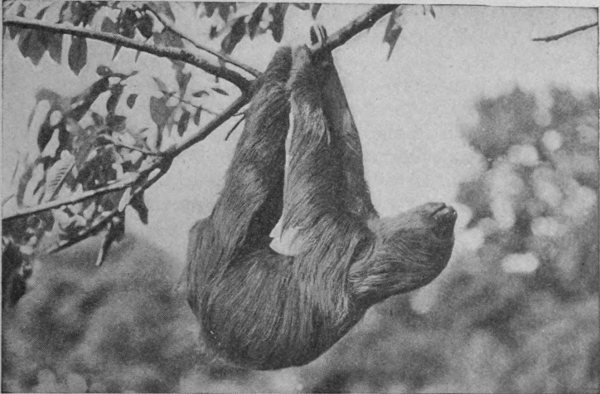
TWO-TOED SLOTH.
The Egg-Laying Mammals.—For several months there were exhibited here two Echidnas—of all small mammals ever seen alive in New York the most wonderful. The Echidna comes from Australia, the home of remarkable types of animals, and belongs to the lowest Order of Mammals, (Monotremata). Like its distant relative, the duck-billed platypus, it reproduces by laying eggs! Its back is covered with short but very thick spines, and its nose is a long, slender beak, absolutely unique. Other examples of this species will be exhibited whenever possible.
Near the Small-Mammal House (No. 35) will be found a log cabin with its entire front opening into two wire-covered yards. The interior of the building is provided with sleeping-dens in which the occupants of the two enclosures can keep dry and warm. This installation is for lynxes, but half of it is occupied by pumas. Already it has fully proven the desirability of keeping lynxes and pumas constantly in the open air, and without artificial heat. To lynxes especially there is nothing more deadly than a well-heated room, indoors.
The Puma, (Felis concolor), is described in the section relating to the Lion House, where other Pumas are exhibited (page 78).
Of the Lynxes, we have two well-defined species, and one subspecies. The Canada Lynx, (Lynx canadensis), is well represented in the southern compartment of the Puma House, where a fine adult pair has become acclimatized. This is the Loup Cervier of the French Canadians, and it is truly the Lynx of Canada and the subarctic North. It has no spots on its body, and its pelage is a cold pepper-and-salt gray color. Its feet are large and heavily furred, and it has a long, black hair-pencil on the tip of each ear. A large specimen stands 18 inches high, and weighs 22 pounds. The food of the American Lynxes generally consists of hares and rabbits, ground birds of all kinds, and anything else that can be caught and killed, except porcupine. To man they are not “dangerous animals.”
North America is wonderfully rich in species of gnawing animals, and the end is not yet. The investigations of our mammalogists are adding new species with a degree of rapidity and parallelism that is fairly bewildering.
It is the duty of the Zoological Society to do its utmost to increase as much as possible the sum total of knowledge of our largest Order of Mammals. Manifestly, however, it is impracticable to do more than place before visitors a reasonable number of well-chosen types, which shall represent as many as possible of the twelve Families, and also the genera most worth knowing.
The most serious obstacle in the way of anyone who attempts to exhibit collections of living rodents lies in the natural propensity of so many species to keep out of sight during the daytime. This is particularly true of the members of the Mouse, Pocket Gopher, and Pouched Rat Families, comprising about three hundred species in all. With very few exceptions, the whole matter of the exhibition of collections of living rodents is something new, and every step is an experiment. In the belief that even the most shy burrowing animals will appreciate abundant room, perfectly natural surroundings, plenty of food, and immunity from annoyance, and eventually fall into the habit of spending many of the daylight hours above ground, as do prairie-dogs, 117 the Society has constructed a series of fifteen small yards, each 10×20 feet, bounded by walls going down to bedrock, and enclosed above by a box-like arrangement of very light wire-netting 5 feet high. The ground is chiefly undisturbed soil of a firm and gravelly nature, thoroughly drained, and all earth filling has been tightly rammed into place to prevent caving in the burrows. Above ground, each yard contains weathered rocks, stumps, and hollow logs in abundance.
In these fifteen yards, each of which will hold specimens of at least two or three species, will be placed strongly marked types of those families whose representatives are most numerous in North America, and also the least known, only a few of which may be mentioned here.
The Sewellel Family, (Aplodontidae), contains five or six species and is of unusual scientific interest. The Sewellel, Mountain Beaver, Farmer or “Showt’l” (Aplodontia rufus and major), is an animal of the size and general appearance of a large, short-tailed muskrat. It inhabits a few localities in remote regions in the mountain-valleys of northern California, Oregon, Washington, and southern British Columbia. It feeds like a beaver, climbs bushes four feet high, burrows in wet ground, and fights like a little fiend when brought to bay. Notwithstanding the size of this animal, it is very seldom seen, and is but little known.
The Squirrel Family, (Sciuridae), is large (one hundred and forty-one species), very interesting, and entitled to much consideration. In the present enclosure will be shown in summer many species of interesting ground squirrels, chipmunks, and marmots. In winter all the squirrels, save one or two hardy native species, will be found in the Small-Mammal House, near by.
The Rabbit Family, (Leporidae), is one of the most difficult to install and exhibit. Its members are large and showy, but for several reasons it is very difficult to keep them on exhibition in captivity. In time, however, all four of the great groups—Rabbit, Varying Hare, Jack Hare, and also the Pikas, forming the allied Family Ochotonidae—will be represented by specimens.
Just what can be accomplished satisfactorily with the most interesting members of the Jumping Mouse, Pouched Rat, and Pocket Gopher Families, remains to be determined by trial. If they can be induced to show themselves to 118 visitors, during daylight hours, they will be kept for exhibition; otherwise not. At present, some examples of these species can be seen in the Reptile House.
In Winter.—In the temperate zone, when “winter comes to rule the varied year,” all the burrowing animals must retire to their burrows, live upon their buried stores of winter food, and hibernate until spring. The tropical species do not know how to hibernate, and therefore they must be taken indoors, or they perish.
In order that our native species of rodents may be seen all winter, and that the tropical species may be kept alive, nearly all the animals that in summer live in the Burrowing Mammal Quarters are removed in autumn to the well-warmed Small-Mammal House. It also happens that in summer a few of the small carnivores, and all armadilloes, are kept in these Quarters.
In addition to the rodents which it is practicable to exhibit in these enclosures, the summer season will find some of them occupied by certain especially interesting species which need the soil of Mother Earth as well as sunlight and air. Here will be found the Armadilloes, the Nasuas, the Raccoon Dogs, the Swift Foxes and a few others, which in winter belong in the Small-Mammal House.
The Western Prairie-“Dog,” or Prairie Marmot, (Cynomys ludovicianus).—Occupying a conspicuous hill-top near the Small-Deer House, and overlooking the Wild-Fowl Pond, is a circular enclosure, 80 feet in diameter, surrounded by an iron fence with an overhang, with walls going down to bedrock. This contains about fifty fat and jolly little Prairie Marmots, one-half of which are the gift of a Montana ranchman, Mr. Howard Eaton. The soil of the enclosure has never been disturbed, and there is no danger that the little creatures ever will be smothered in their burrows, as frequently happens in earth that has once been dug up and filled in again.
Owing to its optimistic and even joyous disposition, the Prairie-“Dog” has many friends, and “happy as a Prairie-'Dog’” would be a far better comparison than “happy as a king.” His cousin, the woodchuck, has the air of being perpetually “in the dumps,” but the Prairie-“Dog”—never. His so-called bark is really a laugh, and his absurd little tail 119 was given to him solely as a means of visible expression of good nature. But he has his enemies and detractors. The coyote loves his plump and toothsome body; the “granger” hates him for the multitude of his holes, and puts spoonfuls of poisoned wheat into his burrow.
The bears of the world form a very interesting group; and when its representatives are properly installed—in large, open yards, with abundant sunlight, fresh air and room for exercise—they develop finely, live happily, and furnish endless entertainment. Under proper conditions, bears are cheerful animals, full of the playful spirit that robs captivity of its chief terror. To confine large bears singly, in small cages, or in wet-floored, high-walled dungeons, or in the unspeakable “pits” of mediaeval type, is a sin against Nature. It is to be noted, however, that small and timid bears, like Ursus japonicus, are better off in small cages than in the very large ones; and it is for this reason that eight small dens have been provided, opposite the original series.
The Zoological Society has put forth considerable effort in constructing a series of nine large Bear Dens which provide ideal conditions for their inmates. Bears do not need buildings! Their habits call for large, open yards, properly situated, with snug and dry sleeping-dens attached, to which they can retire whenever they wish. To them, masonry walls are worse than useless, for they cut off sunlight and promote dampness; but rocks and trees upon which to climb are very beneficial. In warm weather, all bears are fond of bathing, and a bathing pool in each cage is very necessary.
It is cruelty to animals for visitors to throw peanuts, or food of any kind, into our bear dens; and it is strictly forbidden. All persons who do not wish to be reprimanded in public, or arrested, are advised to refrain from it. Teasing with food always irritates bears, sets them to fighting, spoils their dispositions and renders them dangerous to the keepers who have to go in with them! All visitors who are law-abiding, and friendly to the Zoological Society, are requested to assist the keepers and policemen in preventing lawless persons from throwing food into the bear dens. A stern reprimand often prevents serious trouble.
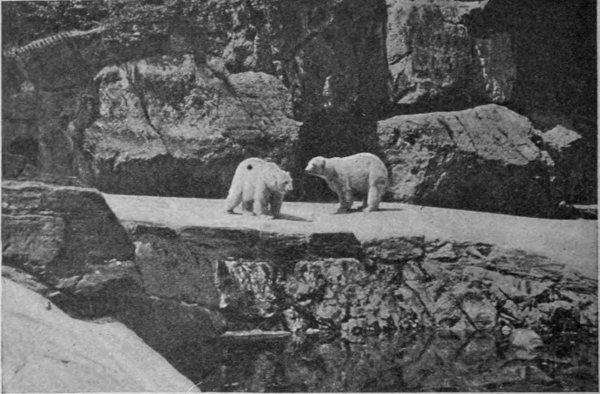
POLAR BEARS.
Showing a portion of their den and pool cut from the solid rock.
The bears of North America form four well-defined groups, as follows:
Up to this date (April 1, 1913), 24 species and subspecies have been described, and it is reasonably certain that much more work remains to be done on the members of this group of animals before the status of each valid and invalid species will be rendered thoroughly clear.
The most noteworthy species are as follows:
| THE MOST IMPORTANT SPECIES OF NORTH AMERICAN BEARS. | ||
|---|---|---|
| Ursus maritimus, (Desm.), Polar Bear. Arctic regions generally. | ||
| The Brown Bears. | Ursus middendorffi, (Merriam), Kadiak Bear. Kadiak Is., Alaska. | |
| Ursus dalli, (Merr.), Yakutat Bear. Yakutat Bay, Alaska. | ||
| Ursus eulophus, (Merr.), Admiralty Bear. Admiralty Is., Alaska. | ||
| Ursus gyas, (Merr.), Peninsula Bear. Portage Bay, Alaska Peninsula. | ||
| The Grizzly Bears. | Ursus Horribilis, (Ord.), Grizzly Bear: Silver-Tip. Wyoming and Utah to Alaska. | |
| Ursas horribilis horriaeus, (Baird), Mexican Grizzly. Southwestern New Mexico. | ||
| Ursus richardsoni, (Swainson), Barren-Ground Grizzly. Great Slave Lake region, and Barren-Grounds. | ||
| The Black Bears. | Ursus americanus, (Pallas), Black Bear. Eastern North America. | |
| Ursus luteolus, (Griffith), Louisiana Bear. Louisiana and Texas. | ||
| Ursus floridanus, (Merr.), Everglade Bear. Florida. | ||
| Ursus emmonsi, (Dall), Glacier Bear. St. Elias Alps, Yakutat Bay. | ||
| Ursus kermodei, (Hornaday), Inland White Bear. Northwestern British Columbia. | ||
The Polar Bear, (Ursus maritimus).—In nearly every collection of living bears the individuals of this species are the most showy and attractive. Their white coats quickly catch the eye of the visitor, and whether young or old, they are generally the most active and playful of all captive bears. In cold weather, when other bears lie in the sun, or, if permitted, curl up in the straw of their sleeping dens, the Polar Bear will disport himself in the freezing cold water of his swimming pool, and joyously play with a cake of ice until the sight of it makes one shiver.
The Polar Bear Den is situated at the north end of Rocking-Stone Hill, about two hundred feet from the north end of the main series of Bear Dens. It is reached by descending the steps leading toward the Beaver Pond, and turning to the right. From the Rocking-Stone Restaurant, the Polar Bears are quickly reached by descending the hill toward the north.
Although the Polar Bear inhabits practically the whole of the Arctic Ocean and its numerous islands, it is by no means the most northerly warm-blooded mammal. Nansen found fox tracks at 85° N., but the most northerly bear observed was on the 84th parallel. The favorite home of this animal is the edge of the great polar ice cap, where Neptune and the “Frost King” wage continuous warfare. He seldom ventures more than a day’s journey inland, on any shore. 122 In winter, as the edge of the ice-pack moves southward, and in summer when it retreats northward, he follows it in order to keep in touch with the ringed seals and walrus that also go with it.
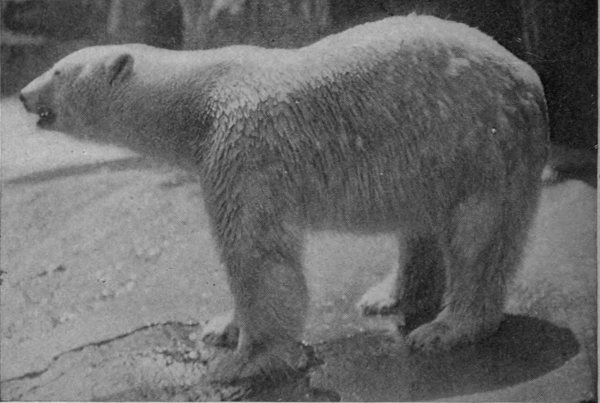
POLAR BEAR “SILVER KING.”
The power of the Polar Bear to resist ice-cold water—nay, even to enjoy it—may fairly be regarded as one of the wonders of Nature. On the coast of Alaska this strange creature will plunge into the Arctic Ocean and swim miles from shore, through tossing fields of broken ice, and wherever the mother leads, her cubs follow.
In the Autumn of 1910, the sealing steamer “Boethic” arrived at New York bringing two adult Polar Bears that were captured in the summer of that year by Mr. Paul J. Rainey. Both animals were presented to the Zoological Society, and the largest one called “Silver King” occupies the cage that was specially built for the polar bears, and the female is exhibited in very comfortable quarters, built for her near that installation. Owing to their savage temper neither of these bears ever can be kept with other bears, nor can any keeper ever enter the cage of either. “Silver King” weighs 880 pounds and is probably the largest Polar Bear ever captured alive and unhurt. While the female is not as large as “Silver King,” she is in every way as perfect a specimen.
The Yakutat Bear, (Ursus dalli).—In 1899, we received from Hudson Lake, Copper River District, Alaska, two 123 young Alaskan Brown Bears which for some time we believed would prove to represent the species found on Kadiak Island. In this belief they were for a time labeled as Kadiak Bears, (U. middendorffi), and so entered provisionally in previous editions of the Guide Book. The maturity of the animals has proven that this supposition was erroneous. The extremely short and thick muzzle of the adult male proves conclusively that they are not identical with the long-skulled species of Kadiak. This interesting pair, absolutely identical in color with middendorffi, are now identified, pending further revisions of our Urisdae, as Ursus dalli.
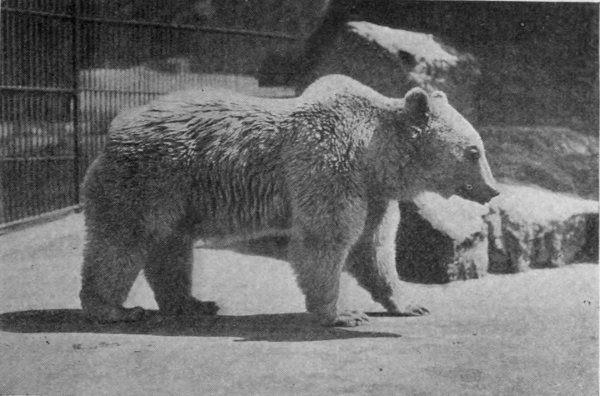
SYRIAN BEAR.
This species, and the two following, well represent the group of big Alaskan Brown Bears, which are quite distinct from the grizzlies and blacks. They are characterized by their great size, high shoulders, massive heads, shaggy brown pelage, and large claws. They live chiefly upon salmon, which they catch from the small streams, but they also devour great quantities of grass.
The Peninsula Bear, (Ursus gyas), of Moeller Bay, well down the Alaskan Peninsula, may at once be recognized by its light brownish-yellow color, and its great size for a bear born in 1904. Its claws are of enormous thickness.
This animal is now beyond doubt one of the two largest bears in captivity, his only rival being in the Zoological Park at Washington.
The Admiralty Bear, (Ursus eulophus), represents a large species originally discovered on Admiralty Island, southern Alaska. Its dark brown color is very much like that of the Yakutat and Kadiak bears.
The Grizzly Bear, or “Silver-Tip Grizzly,” (Ursus horribilis).—The rapid disappearance of this species from the United States renders all living examples of it specially interesting.
Of all bears, the Silver-Tip Grizzly is the most savage and dangerous. He is easily angered, and when wounded or harried not only becomes furiously vindictive, but he also possesses a degree of courage which renders him a dangerous antagonist. As a general thing, a Grizzly Bear, like a lion or tiger, will run as soon as he discovers the presence of his only enemy—man; but if he is wounded or cornered—or thinks he is cornered—he assumes the aggressive, without an instant’s delay. Unfortunately, the largest Silver-Tip Grizzlies ever killed have been too far from scales to make it possible to weigh them.
The most interesting specimen of the Rocky Mountain Silver-Tip now on exhibition is a dark-colored and very handsome specimen, named “Engineer,” obtained in Meeker, Colorado, by Professor Henry F. Osborn, and presented to the Society by the Engineers’ Club of New York City. The color of this individual is darker than the most common type of the Silver-Tip, which is sometimes almost as gray as a badger.
A very beautiful male Silver-Tip, from Wyoming, is much lighter in color than the Colorado specimen. Its face and head are so light-colored it would be called by Rocky Mountain hunters a “Bald-Faced” Grizzly. A third specimen was obtained for the Society at White Horse, Yukon Territory, in 1905, and its development will be watched with much interest. Throughout the Rocky Mountain region the “Silver-Tip” and the “Grizzly” are identical; but the color of the species varies considerably.
In a wild state Grizzly Bears live on berries and fruits of all kinds available, succulent roots, grubs, carrion if it comes handy, and live game if it can be killed. In the cattle-growing states bordering the Rocky Mountains, owing to their cattle-killing propensities, a bounty of from twelve to fifteen dollars per head is paid for their destruction.
The Black Bear, (Ursus americanus).—Until quite recently all black bears in North America were referred to a 125 single species, with the type of which most persons are familiar. Even during the last twenty years living representatives of the Black Bear group have been found in nearly every state and territory of the United States, and also in northern Mexico, Labrador, Province of Quebec, Alberta, Assiniboia, British Columbia, Alaska, and the Mackenzie River basin. Our collection contains Black Bears representing several widely separated localities.
The Spectacled Bear, (Ursus ornatus).—After ten years of constant effort the Zoological Park finally acquired late in 1910, a fine male specimen of the very rare and little known Spectacled Bear of the Andes of Ecuador and Peru. This zoological prize was procured for us in Quito, by Mr. Edgar Beecher Bronson (Author of “In Closed Territory,”) and by him presented to the Society. “Frederico” is distinguished by a glossy jet-black coat, very small ears, long feet and a large imperfect circle of white around each eye, with white bands down the cheeks and throat. In size it matches a small American black bear. As soon as the new bear dens are finished, this animal will be removed from the Small-Mammal House to one of them. If this species was ever before exhibited in North America, we have never heard of it.
The Andean Black Bear, (Ursus ornatus thomasi), from Southern Columbia, South America, is a subspecies of the spectacled bear, with no “spectacles” around its eyes, and no white markings save under its chin and throat. This specimen is smaller than the one from Quito. Practically nothing is known of the habits of these two species.
The Brown Bear of Europe, (Ursus arctos), is represented by two specimens from Central Russia which bear a general resemblance to Rocky Mountain grizzlies. This is so striking that were they not labeled very few persons would suspect their European birth. They have the high shoulders and grizzly brown coat of the silver-tip, and in the Rocky Mountains would be considered good examples of Ursus horribilis.
This pair has bred four times and reared some very fine cubs.
The Syrian Bear, (Ursus syriacus), is well represented by a fine specimen from Trebizond, Asia Minor. This bear is of a pale yellow color, with very high shoulders, narrow head and smooth pelage. The Syrian bear represents “the bears of the Bible,” which appeared in punishment of the 126 children who were disrespectful to the prophet Elisha. Bears of this species are often trained to dance, and perform various tricks at command, and usually lead very miserable lives at the hands of gypsies and other bear specialists of nomadic habits.
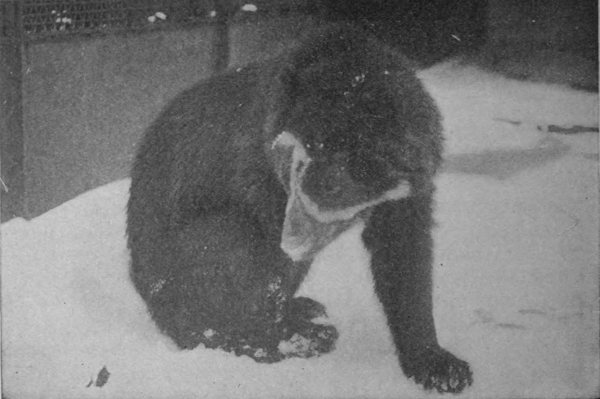
SPECTACLED BEAR.
The Hairy-Eared Bear, (Ursus piscator), a species very rarely seen in captivity, is represented by two fine specimens from the Altai Mountains, Central Asia. This animal is sometimes called, on account of its peculiar light brown color, the Isabella Bear. Its more correct name has been bestowed on account of its large and very hairy ears. It inhabits northeastern Asia, as far southwestward as the Altai Mountains. The fine pair exhibited were presented to the Society by Mr. Carl Hagenbeck.
The Himalayan Black Bear, (Ursus torquatus), is the handsomest of the four living species of black bears, and can easily be identified anywhere by three distinct characters, neither of which is possessed by any other black bear. They are, a pure white chin, long side-whiskers on the jaws and sides of the neck and very large ears. Up to this date the geographic range of this very interesting animal has been recorded as extending from eastern Persia through Beluchistan, Afghanistan, Assam, and South China to Formosa; but the three specimens exhibited were taken in northern Japan, where the existence of this species seems to be established beyond question.
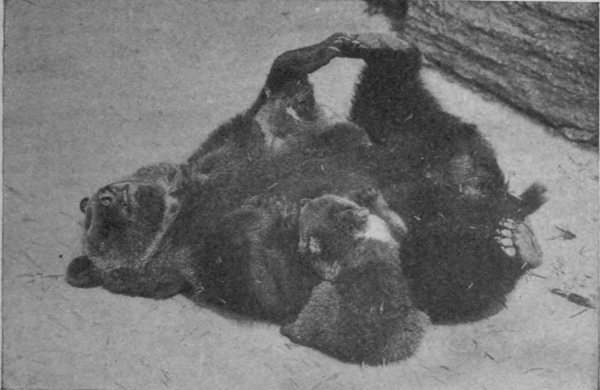
EUROPEAN BROWN BEAR.
Two cubs are nursing.
The Japanese Black Bear, (Ursus japonicus), from northern Japan, is one of the smallest of living bears, being only slightly larger than the Malay sun bear. In general appearance it suggests a small edition of the American black bear. The first specimen exhibited at the Zoological Park was very good-natured, but all these received since are nervous and irritable, and also very timid.
The Sloth Bear, (Ursus labiatus), often called the Long-Lipped Bear, can be recognized as far as it can be seen by its shaggy mop of enormously long, black hair, its white muzzle, and its very long, white claws. It is a creature of many peculiarities. It inhabits India generally in forest regions. This is Kipling’s “Baloo.”
| LIST OF BEARS IN THE ZOOLOGICAL PARK. | ||||
|---|---|---|---|---|
| April 1, 1913. | ||||
| 2 | Polar Bears | Ursus maritimus | from | Ellesmere Land. |
| 2 | Yakutat Bears | Ursus dalli | “ | Alaska. |
| 1 | Peninsula Bear | Ursus gyas | “ | Alaska Peninsula. |
| 1 | Admiralty Bear | Ursus eulophus | “ | Adm. Is., Alaska. |
| 3 | Kadiak Bears | Ursus middendorffi | “ | Kadiak Island. |
| 1 | Kobuk Brown Bear | Undetermined | “ | Kobuk River, AL |
| 1 | Grizzly Bear | Ursus horribilis | “ | Colorado. |
| 1 | ““ | ““ | “ | Yukon Terr. |
| 1 | ““ | ““ | “ | Wyoming. |
| 1 | Spectacled Bear | Ursus ornatus | “ | Equador. |
| 1 | Andean Black Bear | Ursus ornatus thomasi | “ | Columbia, S. A. |
| 1 | Black Bear | Ursus americanus | “ | Pennsylvania. |
| 1 | ““ | ““ | “ | Virginia. |
| 3 | ““ | ““ | “ | Alaska. |
| 1 | ““ | ““ | “ | West Ontario. |
| 1 | ““ | ““ | “ | Mexico. |
| 1 | Cinnamon Bear | ““ | “ | Colorado. |
| 1 | ““ | ““ | “ | Wyoming. |
| 1 | Syrian Bear | Ursus syriacus | “ | Asiatic Turkey. |
| 3 | Brown Bears | Ursus arctos | “ | Central Russia. |
| 2 | Hairy-Eared Bears | Ursus piscator | “ | N. W. Mongolia. |
| 1 | Himalayan Black Bear | Ursus torquatus | “ | Japan. |
| 1 | Japanese Bear | Ursus japonicus | “ | Japan. |
| 1 | Sloth Bear | Ursus labiatus | “ | India. |
| 2 | Yezo Bears | Ursus ferox | “ | Yezo, Japan. |
| 1 | Malay Sun Bear | Ursus malayanus | “ | Borneo. |
| 36 | specimens, representing 18 species. | |||
The Malay Sun Bear, (Ursus malayanus), is the smallest bear in the world, also the ugliest and the most ill-tempered. When fully enraged, it sometimes barks like a dog. Its hair is very short and close, and its head and feet seem to be too large for its body. This species inhabits Borneo, Sumatra, the Malay Peninsula and Farther India. Two specimens will be found in the Small-Mammal House.
The Raccoon Tree.—A permanent installation for Raccoons has been established near the southern end of the Bear Dens, where its inmates will be near their plantigrade relatives. At the foot of the steps leading down from the Rocking Stone, a cedar-tree, forty feet in height, has been enclosed by an elliptical iron fence provided with a sheet-metal overhang which is not negotiable by any Procyon. Inside the fence is a dry yard, a pool of water for all purposes, and the trunk of the tree is surrounded by a rustic shelter house, divided into ten warm and dry compartments. Underneath the house is a clean and smooth wooden floor, on which the food is served.
The smooth, horizontal limbs of a cedar-tree are grateful and comforting to a dozing Raccoon, and the tree is not so high that the animals can climb beyond the visual power of the visitor.
Hidden away in the deep valley between high hills of virgin forest lies the Beaver Pond. The spot is so secluded, 129 so silent and primeval, that it seems like the heart of the Adirondack wilderness. Lying fairly in the lap of the granite hills is a three-acre oval of level swamp, which recently was full of woodland rubbish and choked by rank weeds. The seclusion of the spot, the splendid forest, the food-wood and the possibilities of the dam, all naturally suggested the beaver.
In order that the building of a dam by the beavers would not raise the water level so high as to flood the roots of a number of fine forest trees and destroy them, two feet of soil was taken out of the swamp, and at the same time a broad outlet was excavated. A fence of small iron bars, with an overhang, was designed to encircle an area of about three acres. Within the enclosure thus made, stand several large forest trees—chiefly oak, sweet gum, and maple—which have been protected by guards of wire and corrugated iron. The small maples, however, have been given over to the beavers, to cut down and use as food-wood and also in their dam-building operations.
The Beaver Colony in our pond is in good working order, and its display of work makes a highly satisfactory exhibit. The dam, about 40 feet long and 4 feet high, was built of poles and sticks which were cut, peeled, floated down and placed by the beavers, and pointed up with mud. There is a house 10 feet in diameter and 4 feet high, similarly constructed. Within the enclosure about twenty saplings and trees have been cut down by the beavers and used up for food and building materials.
For this colony the Society is indebted to Mr. Hugh J. Chisholm, who procured for it two specimens from Canada and three from Maine.
The American Beaver, (Castor canadensis), is a remarkable animal. In original thought it is equalled by few animals, and in industry by none. With the possible exception of the porcupine, it is the largest gnawing animal in North America, once was widely distributed, and its beautiful fur has been in demand ever since the days of the colonists. Unfortunately, the Beaver’s intelligence was directed chiefly to the building of dams, canals, and houses, and procuring an abundant supply of food-wood, rather than in providing itself with means of escape from its arch enemy—the man with a steel trap. Because of the constant demand for its fur, this animal has been so nearly exterminated throughout the United States that practically none remains save where 130 they are rigidly protected. At present the largest colonies known are those in the Yellowstone Park, although in Canada and the Northwest many still remain.
The most wonderful thing about the Beaver is the manner in which he builds dams, to make ponds deep enough for his timber-floating operations, and to afford him a submarine passage to his house. Give him a valley and a stream of water, and he will gladly make a pond out of whatever raw materials are at hand. He uses the four-foot sticks from which he has eaten the bark for food, and with these, and an abundance of mud, he will raise a good strong dam to a height of four feet, and a width on the ground of ten feet or more. The mud used is dug out of the bottom and sides of his pond, and carried, while swimming, between his paws, with his front feet holding it against his breast. The sticks used in the dam are thrust endwise into the mud on top of the dam, and the mud used is patted down with his fore feet. The tail is not used as a trowel, but in swimming it is the Beaver’s propeller.
In captivity the Beaver is not wholly a satisfactory animal. Like some human craftsmen, he positively declines to work under observation, and performs nearly all his tasks at night. He thinks nothing of gnawing down a tree a foot in diameter, and cutting its limbs into pieces which he can handle while swimming. If he can secure enough food-wood of kinds of his liking, he eats little else. Besides building dams to create ponds in which he can take refuge when hard pressed, he constructs canals, and houses for winter use. He also digs burrows into high banks; but his entrances to his various homes always are under water.
As an answer to a frequent question—“Of what use are reptiles?”—a new collection has been installed in the Reptile House. It is supplied with descriptive labels, and serves several purposes. In the first place there is presented an elaborate series of the small gnawing animals, or rodents, a number of the species of which are highly injurious to the interests of agriculturists; secondly, the exhibition contains a large series of those species of snakes that prey upon the destructive rodents,—thus presenting for observation the serpents of marked economic value. Finally, the entire series stands as a clear demonstration of the perfect logic of 131 Nature in which the production of all animal life is carefully balanced; for a part of the exhibition is composed of representative species of mammals that, in turn, prey upon the serpents, thus keeping even the destroyers of the smaller injurious creatures within bounds!
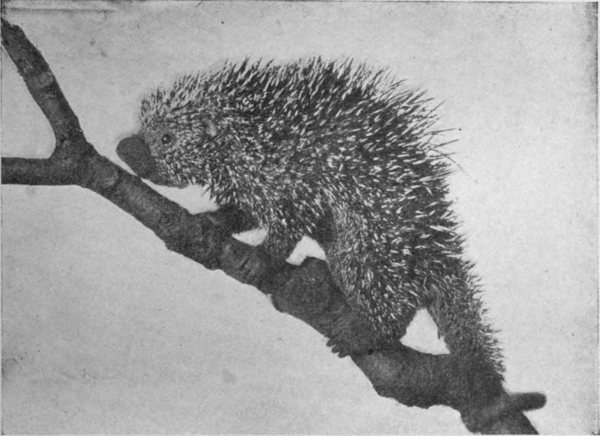
BRAZILIAN TREE PORCUPINE.
During the past two years the collection of rodents has been steadily growing in importance. The following is a list of the species on exhibition at the close of the year 1912:
| RODENTS IN THE ZOOLOGICAL PARK. | |
|---|---|
| HARES AND RABBITS (Leporidae) | |
| Mexican Swamp Rabbit | Lepus palustris. |
| Cotton-Tail Rabbit | Lepus palustris mallurus. |
| Domestic Rabbits, various breeds | (Nursery stock.) |
| SQUIRRELS AND MARMOTS (Sciuridae) | |
| Thirteen-Lined Spermophile | Spermophilus 13-lineatus. |
| Desert Spermophile | Spermophilus leucurus. |
| Richardson Spermophile | Spermophilus richardsoni. |
| Woodchuck | Arctomys monax. |
| Prairie Dog | Cynomys ludovicianus. |
| European Squirrel | Sciurus vulgaris. |
| Mexican Squirrel | Sciurus aureogaster. |
| Central American Squirrel | Sciurus variabilis. |
| Cuban Squirrel | Sciurus chrysurus. |
| Variable Squirrel | Sciurus griseo-flavus. |
| Gray Squirrel | Sciurus carolinensis. |
| Black Squirrel | Sciurus carolinensis niger. |
| Fox Squirrel | Sciurus ludovicianus. |
| White-Headed Squirrel | Sciurus macrouroides. |
| Malabar Squirrel | Sciurus malabaricus. |
| Chipmunk | Tamicis striatus. |
| African Ground Squirrel | Xerus capensis. |
| Flying Squirrel | Sciuropterus volans. |
| BEAVERS (Castoridae) | |
| American Beaver | Castor canadensis. |
| KANGAROO RATS (Heteromyidae) | |
| Kangaroo Rat | Dipodomys merriami. |
| POCKET GOPHERS (Geomyidae) | |
| Harsh-Coated Pocket Gopher | Geomys hispidus. |
| DORMICE (Gliridae) | |
| Squirrel-Tailed Dormouse | Myoxus glis. |
| Lesser Dormouse | Myoxus dryas. |
| English Dormouse | Muscardinus avellanarius. |
| MICE AND RATS (Muridae) | |
| Domestic Mouse—Unusual Color Phases | Mus musculus. |
| Japanese Waltzing Mouse | Mus musculus. |
| Black Rat | Mus rattus. |
| Black-and-White Rat | Mus norwegicus. |
| Gray-and-White Rat | Mus norwegicus. |
| Porcupine Mouse | Acomys cahirinus. |
| Egyptian Gerbille | Gerbillus pyramidum. |
| Muskrat | Fiber zibethicus. |
| Cotton Rat | Sigmodon hispidus. |
| JERBOAS (Dipodidae) | |
| Greater Jerboa | Dipus aegyptius. |
| COYPU AND SPINY RATS (Octodontidae) | |
| Coypu Rat | Myocastor coypu. |
| Hutia: Cuban Tree Rat | Capromys pilorides. |
| Short-Tailed Hutia | Capromys browni. |
| PORCUPINES (Hystricidae) | |
| Canada Porcupine | Erethizon dorsatus. |
| Brazilian Porcupine | Sphingurus prehensilis. |
| African Porcupine | Hystrix cristata. |
| VISCACHAS AND CHINCHILLAS (Chinchillidae) | |
| Viscacha | Lagostoma trichodactylus. |
| AGOUTIS (Dasyproctidae) | |
| Golden Agouti | Dasyprocta agouti. |
| Gray Agouti | Dasyprocta prymnolopha. |
| CAVIES (Caviidae) | |
| Domestic Cavy | Cavia porcellus. |
| Capybara | Hydrochaerus capybara. |
| Patagonian Cavy | Dolichotis patagonica. |
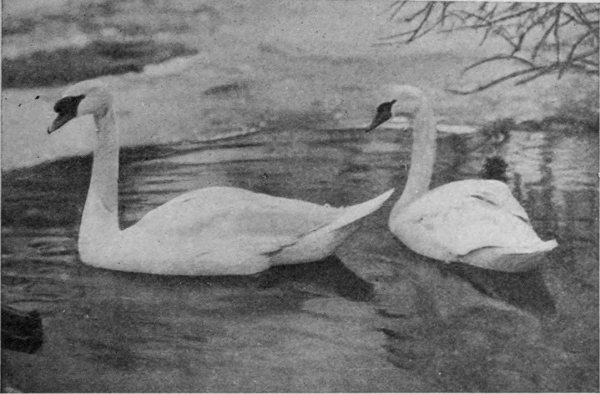
MUTE AND TRUMPETER SWANS.
There are no birds which take more kindly to captivity, or which better repay their keep and their keepers, than the ducks, geese, swans and pelicans. The only drawback to the maintenance of large collections of these birds in this latitude is the annual struggle with our arctic winter. On account of the fierce winter storms to which we must pay tribute, many species of swimming birds require to be taken out of their aviary, and housed in sheltered buildings, with moderate warmth. For this reason the pelicans, tree-ducks of all species, and all species from the tropics, must necessarily be absent in winter from their summer quarters.
For the accommodation of a large, systematic collection of wild geese, an aviary two hundred and fifty feet long by one hundred and forty-three feet in width has been constructed in the north end of Bird Valley. To secure as much space as possible, the entire width of the open valley has been taken into the enclosure.
The Goose Aviary consists of a pond containing three islands, two of which are subdivided by low fences of wire netting into twelve separate enclosures. The collection of geese has become so large and important the original Duck 134 Aviary has been taken for it, and the Ducks will hereafter be found on the Wild-Fowl Pond and in the Flying Cage.
The Geese.—The collection of wild geese, in the Goose Aviary, is unusually large, there being generally about twenty out of the thirty-five known species. Among these one of the best known is the Common Wild, or Canada Goose, (Branta canadensis). Once common throughout many parts of the United States, continual persecution by sportsmen and market hunters has so generally reduced its numbers that now it is of comparatively rare occurrence.
This exceeding rarity made the arrival of nine superb wild specimens on November 8, 1900, on the Wild-Fowl Pond, a most interesting event. Seven of the birds, including a fine gander, through the artifice of a trap, were induced to remain with us, and have taken up a peaceful abode on the little lake, with others of their kind presented by Mr. A. B. Frost.
The African Spur-Winged Goose, (Plectropterus gambensis), although of large size, is more properly a duck than a goose. A long sharp spur arises from the bend of each wing, which the birds use in fighting with each other for their mates.
The Gray-Lag Goose, (Anser anser), is, perhaps, the most interesting of all geese, as being the wild species from which our domestic birds are descended. The white color and large size are the chief differences between the domestic and wild birds.
The White-Fronted Goose, (Anser albifrons), is worthy of special notice because it is the handsomest of the ten species of North American geese. The breeding grounds are far to the north, and in Alaska the nests are mere hollows in the sand, lined with moss and down.
The Bar-Headed Goose, (Eulabia indica), inhabits the mountains of Central Asia, nesting always over a mile above the sea. It is perhaps the handsomest of all geese.
The Swans.—Usually at least six out of the seven known species of swans may be seen on exhibition here.
The Mute Swan, (Cygnus olor), is the commonest swan in captivity, and is the one made famous in European history and legend. It may always be known from the other species by the black knob at the base of the bill. It breeds freely in captivity and the young birds are known as cygnets.
The Trumpeter Swan, (Cygnus buccinator), being the largest bird in the aviary, and also snowy white, is therefore the most conspicuous. Several fine specimens are shown on the North Island, living contentedly with other species. Some of these specimens were captured in Idaho, when young enough to take kindly to captivity.
The Black Swan, (Chenopsis atrata), of South Australia and Tasmania, is as glossy black, excepting its primaries, as other swans are white. It is a large and handsome bird, and much sought by all persons who form collections of water fowl.
The Coscoroba Goose, (Coscoroba coscoroba), is a fair connecting link between the swans and the ducks, partaking about equally of the characters of each. In size and color it is very much like our snow goose, (Chen hyperborea), but it is peculiar in possessing very long legs of a bright pink color, by which it is quickly recognized. Its bill, also is pink, and the tips of its primaries are black. The Coscoroba Goose is a native of southern South America, and a few years ago specimens were so rare in captivity that a pair sold for $300.
This mammoth bird-cage is one of the wonders of the Zoological Park. It represents an attempt to do for certain large and showy water birds, precisely what has been done for the hoofed animals, the beaver, otter, and other species—give them a section of Nature’s own domain. In this they can fly to and fro, build nests and rear their young in real freedom.
Near the lower end of Bird Valley, as a sort of climax for the Goose Aviary when seen from the north, rises a lofty, web-like structure, in the form of a huge, gothic arch. It is 55 feet in height, 75 feet wide, and 152 feet long. The whole structure consists of a series of steel-pipe arches and purlins, the former eight feet apart, over which wire-netting has been tightly stretched.
The wire-netting seems peculiarly open. It is of the kind known as chain-netting, which offers the least possible obstruction to the eye. This cage is so large that a very respectable block of houses, three stories high and of ample dimensions, could stand within it without touching the wire. It completely encloses three forest trees of very considerable 136 size, two hickories and an oak; and it contains a pool of water a hundred feet long, and shrubbery in abundance.
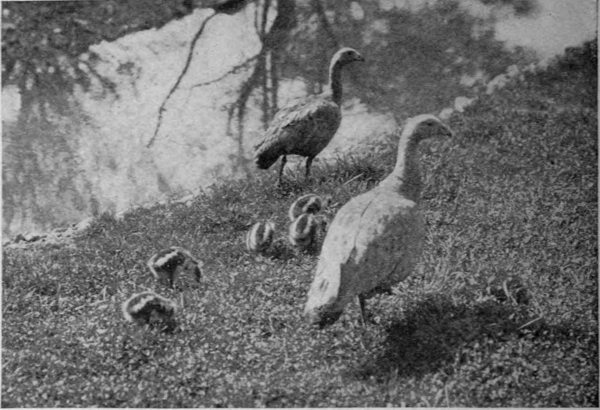
CEREOPSIS GEESE.
The idea of a very large cage for herons and egrets, is not new, for there are in existence several other flying cages, somewhat smaller than this. The first was erected in the Rotterdam Zoological Garden by its Director, the late Dr. A. Von Bemmelin, whose experiment proved very successful. Others are at London and in Paris Jardin d’Acclimatation.
The Flying Cage is the summer home of a mixed flock of such large and showy water birds as are most inclined to fly about within it, and afford students and the public an opportunity to study their movements and attitudes. Save for such allowances as must be made for accidents and epidemics, this enclosure will contain the following noteworthy species, along with others of less importance:
The American Flamingo, (Phoenicopterns ruber), is, in appearance, a connecting link between the herons and ducks, resembling the former in the great length of its legs, and the latter in the duck-like bill and webbed feet. When the plumage of this species is perfect, it is of a beautiful scarlet color throughout, excepting the primaries, which are black. In captivity, the color fades somewhat. This bird is found in the Bahama Islands and Cuba, but in Florida, where once it was fairly numerous, it no longer exists. 137 Fortunately, this remarkable bird takes kindly to captivity, and the Zoological Park is never without a good-sized flock. Their strange form, showy colors and droll attitudes render them unusually interesting to visitors.
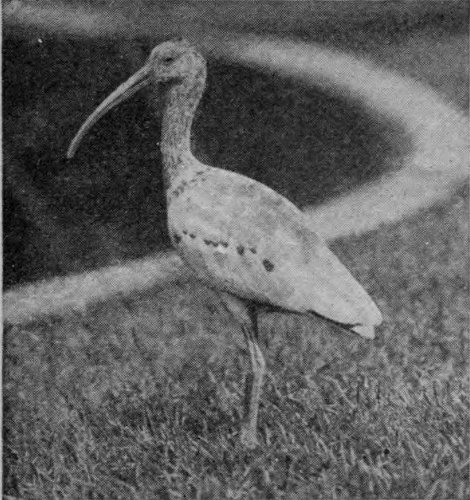
WHITE-FACED GLOSSY IBIS.
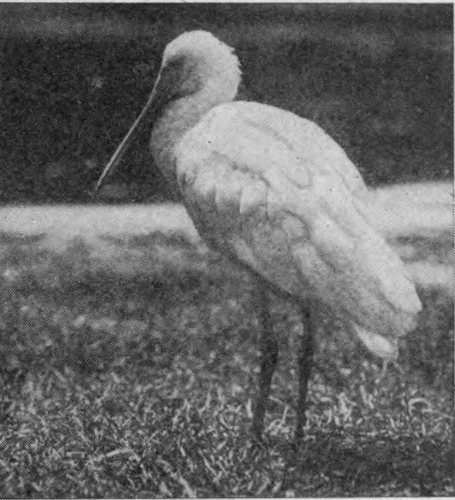
ROSEATE SPOONBILL.
With the birds of the above species are shown a few specimens of the European Flamingo, (P. roseus), which is almost white. The only parts which show the characteristic scarlet of this genus, are the wing coverts, which are pale red, or pink.
The Scarlet Ibis, (Guara rubra), is for its size the most showy bird in existence, not even excepting the birds of paradise. Excepting the black primaries, every feather on the adult bird in perfect plumage is of a brilliant Chinese vermilion color, visible in nature for a long distance. The immature birds are mottled and patched with white. This species once came as far north as southern Florida, but now it is found only from Cuba southward. They frequent the mud banks at the various mouths of the Orinoco, and not long since were quite abundant on the coast of British Guiana.
The White-Faced Glossy Ibis, (Plegadis guarauna), is not a rare bird in captivity, and it will doubtless be possible to maintain this species perpetually in the Flying Cage and Aquatic-Bird House.
The Wood Ibis, (Tantalus loculator).—The Park obtains its supply of birds of this species from Florida, where they breed, in very greatly reduced numbers, on the headwaters of the St. Johns. This bird is a very satisfactory member of avian society. Although amply large to lord it over the 138 other birds of the cage, he quarrels with none, but peacefully goes his way, feeling with the point of his beak along the sandy bottom of the pool for something edible, or standing in quiet meditation on the bank. Notwithstanding its common name, this bird is not an ibis, but a true stork. In its black and white plumage it is quite a handsome bird. Although not so fond of using its wings in captivity as are herons and egrets, the Wood Ibis is for many reasons a very welcome tenant.
The White Stork, (Ciconia ciconia), is as large as our wood ibis, which it strongly resembles in form and habits. This bird is literally the household bird of Germany, and its place in the family has now become of more importance than its place in nature. Throughout Holland, Germany, and very nearly the whole of eastern and central Europe, the White Stork is so prized and protected by the people that it has attained a state of semi-domestication. Nesting places are prepared for it, usually near or even upon human habitations, and it enjoys an immunity from molestation quite like that of the adjutant in India.
The Great Blue Heron, (Ardea herodias), is frequently called the “blue crane”; but the latter name is a misnomer. It properly belongs to our sandhill crane (Grus canadensis). Just why so large a number of people should be so persistent in this error is a psychological problem; but the fact remains that people will not say “heron.”
This Great Blue Heron is the largest and most noteworthy bird of our northern marshes. Thanks to the fact that it bears no desirable “plumes,” and its flesh is not edible, it has been permitted to live. When not molested, it becomes quite trustful, and when wading along a shore, fishing for minnows, it affords for the field-glass or the camera a very interesting subject. In summer these birds are quite numerous in the marshes along the Shrewsbury River, between Sandy Hook and Long Branch, and they are an unfailing source of interest to excursionists. It is sincerely to be hoped that the evil eye of “Dame Fashion” will not fall upon this bird, and cause its extermination.
The Great White Heron, (Ardea americana), is taller than the great blue heron, and it is the largest of all the white herons and egrets. Like the whooping crane, it is now a bird of such exceeding rarity that the procuring of a specimen may be counted a stroke of good fortune. In eight 139 years the Zoological Park has secured only three specimens, all of which came from southern Florida.
The Little Blue Heron, (Florida caerulea).—The immature birds of this species are snowy white, and so closely resemble snowy herons of the same age, that only one well acquainted with both can distinguish between them. They are, however, separately recognized by the fact that the snowy heron has black legs, and a black bill, whereas the legs and bill of the Little Blue Heron are pale yellow. This species is still common in some parts of its Florida home, and occasionally a specimen strays as far north as Staten Island.
The Louisiana Heron, (Hydranassa tricolor ruficollis), once very numerous in Florida, is still found there, but in greatly reduced numbers. It ranges from Central America and the West Indies northward to the Gulf States, and occasionally to Long Island. The general coloring is dark blue, but a prominent distinguishing character is the chestnut brown on the sides of the neck.
The Black-Crowned Night Heron, (Nycticorax nycticorax naevius), is one of the commonest herons about New York City and occasionally nests in the Park itself. It breeds in large colonies, and feeds chiefly at night. Its note is a hoarse quok, very much like the bark of a dog.
The Snowy Heron, or Snowy Egret, (Egretta candidissima), when fully adult, is the most beautiful white bird in all the avian world. Its form is the embodiment of symmetry and grace, its plumage is immaculate, and the filmy “plumes” on its head and back are like spun glass. Its black legs and bill merely serve to intensify the whiteness of its feathers. The vanity of woman has been the curse of the Snowy Egret. Its plumes are finest during the breeding season, and it was then that the hunters sought them, slaughtering the old birds in the rookeries by thousands (when they were abundant), and leaving the nestlings to die of starvation. If all women could know the price in blood and suffering which is paid for the accursed “aigrettes” of fashion, surely but few could find any pleasure in wearing them. It is strange that civilized woman—the tender-hearted, the philanthropic, and the ever-compassionate—should prove to be the evil genius of the world’s most beautiful birds.
In the United States the Snowy Egret now exists only by accident, and the “plume hunters” are pursuing this and 140 the following species in Central and South America, to their most remote haunts, sometimes even at the risk of their lives. Fashion has decreed that the egrets must go.
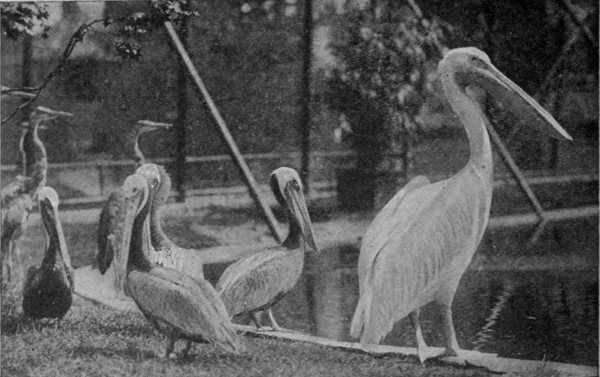
BROWN AND WHITE PELICANS.
The American Egret, (Herodias egretta).—Much to the misfortune of this species, it possesses about fifty “aigrette” plumes which droop in graceful curves from the middle of its back far beyond the tail and wing tips. For these beautiful feathers this bird has been pursued by plume hunters almost to the point of total extermination in the United States.
The White Pelican, (Pelecanus erythrorhynchus), is one of the largest birds of North America and by reason of its size, its pure white plumage, its enormously long amber-colored bill and gular pouch, it is one of the most showy birds in the aviary. As consumers of fish they stand pre-eminent among birds, and their only rivals in the Park are the sea-lions. The specimens exhibited were collected for the Society in southern Texas.
The Brown Pelican, (Pelecanus occidentalis), when adult, is a handsome and showy bird, and one which not only is easily reconciled to life in a comfortable aviary, but positively enjoys it. The specimens in our collection were collected for the Society on Pelican Island, Florida, and their interesting home life at that place may be studied from the series of photographs on exhibition in the Aquatic Bird House. When their daily allowance of fish appears they 141 crowd around their keeper, and with wide-open pouches earnestly solicit contributions.
This building is the result of an attempt to solve an old problem in a new way—the care of large migratory water birds in the most uneven winter climate on earth. In comparison with the care in winter of flamingoes, large herons, egrets, ibises, and the like, the housing of perching birds, birds of prey and the parrots, presents few difficulties. But the wealth of fine water birds in North America alone, and the interest attaching to them, seem to justify the labor and expense that have been involved in this building and its appointments. Practically all of the birds to be seen in this building in winter are mentioned elsewhere in this volume.
THE OWL CAGES.—After the completion of the Eagle and Vulture Aviary, the ten large cages on the exterior of the Aquatic-Bird House, which have been occupied temporarily by the birds of prey, will be used for the owl collection.
The Giant Eagle Owl, (Bubo bubo), is a true giant among the owls. It is found throughout continental Europe, keeping mostly to the deep forests, and feeding on grouse, rabbits, etc. It is unusually long-lived in captivity, and breeds freely.
The Milky Eagle Owl, (Bubo lacteus), has the same general characters as its congener, but its feathers are of a beautiful, soft gray. It is very rare in collections.
The Great Horned Owl, (Bubo virginianus).—These nocturnal birds of prey inhabit heavily wooded regions, feeding on mice, and poultry when it is obtainable. The bright yellow iris, the conspicuous feather horns, and the apparently pivoted neck are curious features of these birds. Their reputation for wisdom is founded only on their external appearance, for in reality they are rather dull birds.
The Snowy Owl, (Nyctea nyctea), of the Arctic regions, migrating in winter to the northern United States, sometimes remains for several seasons in succession so far north that no specimens are obtainable. During 1899, 1900, and the first half of 1901, not one specimen could be procured, but in the late autumn of 1901 a southward migration began. 142 On June 1, 1911, the Park exhibited six fine specimens, one of which was almost pure white. During the three hottest months of summer, these birds would suffer considerably, so during this period they are confined in a cool, dark cellar, thus keeping in perfect health and comfort throughout the year.
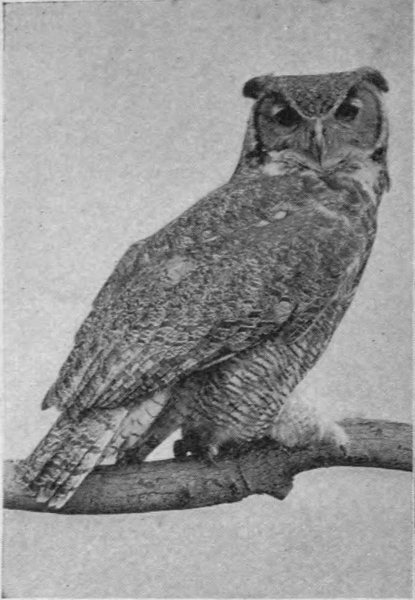
GREAT HORNED OWL.
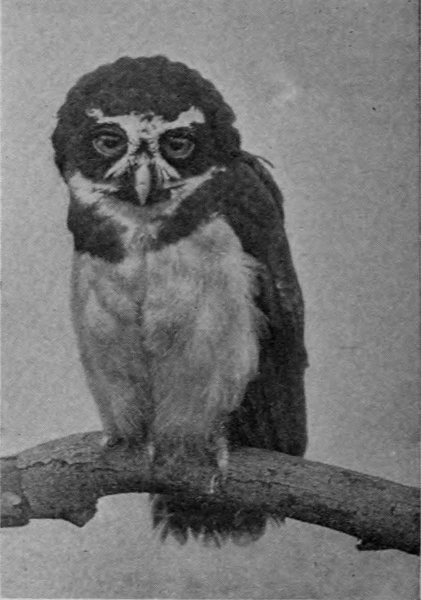
SPECTACLED OWL.
The Screech Owl, (Otus asio).—This little horned owl is our commonest species, and frequents the neighborhood of dwellings and orchards. Being nocturnal it is more common than is generally supposed, and its curious cry, which is not a screech, but a musical, quavering series of notes, is the cause most frequently leading to its discovery. Its two phases of plumage, red and gray, occur independently of sex, age or season. Its food consists of mice and insects.
The Barred Owl, (Syrnium varium).—This owl is more diurnal than its nearest relatives, and often hunts its prey in bright moonshine. Its deep, penetrating call, “woo-o-o, whoo-o-o,” is one of the most weird and striking cries of the bird world. Another peculiarity, common to all owls, but more noticeable in this less nocturnal species, is the absolutely noiseless flight. The soft, downy feathers of the owl permit it to wing its way through the air with as little noise as a falling leaf.

EARED VULTURE.
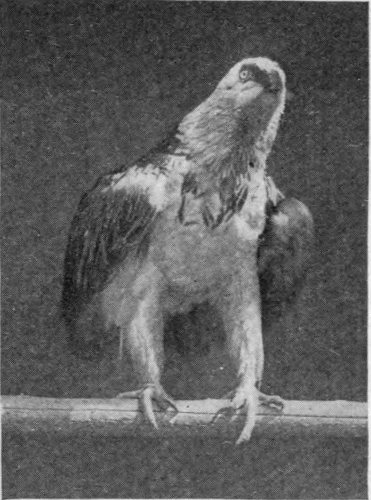
LAMMERGEYER.
The Eagle and Vulture Aviary stands in an open glade, but well surrounded by forest trees, in Bird Valley, between the Aquatic Bird House and the new Zebra House. It is a commodious and pleasant installation, well adapted to exhibit the Society’s collection of rapacious birds. Its length over all is 210 feet. It has seven very large flight cages and six smaller ones. The largest cages are 24 feet wide, 33 feet deep and 31 feet high. In the rear of the great wire structure will stand a very comfortable brick building to serve as a winter shelter for the tropical birds of the collection; but it will not be open to the public.
Now that our eagles and vultures are to be brought together, visitors will find that the collection is a large one, and contains many fine species.
The Condor, (Sarcorhamphus gryphus), of the Andes, is the largest of the birds of prey, having a wing-spread of over nine feet. It feeds entirely on carrion, rarely attacking living animals. In the male, the head is adorned with a large fleshy comb, much like that of a barn-yard cock. The Society at present possesses several specimens of this great bird.
The King Vulture, (Gypagus papa), is as its proud name implies, the one member of the Vulture Family which really 144 is clad in royal robes, and color-decked to match. Its range extends from Mexico and Central America to Trinidad and Brazil. The visitor should not fail to see this gorgeously caparisoned body of white, cream-yellow and black, and head of orange, purple and crimson.
Black Vulture, (Catharista urubu).—These ill-favored but very useful birds are quite abundant, and even semi-domesticated, in some of our southern cities. This is due to the protection accorded them, because of their valuable services as scavengers. They are said to devour every particle of exposed organic refuse, and in a warm climate these services are of more value than we in the north can realize.
The Yellow-Headed Vulture, (Cathartes urobitinga), of northern South America, is a much handsomer bird than its two preceding relatives. It has much the same feeding habits, but is very rare and delicate in captivity.
The California Condor, (Gymnogyps californianus).—This is one of the rarest, and to all Americans the most interesting, bird of prey in the Park. The species is confined to a very small area in the rugged mountains of southern and lower California, and beyond all doubt, the skin-collecting ornithologists will exterminate it within the next twenty years, or less.
The Griffon Vulture, (Gyps pulvus), and the Kolbe Vulture, (G. kolbi), are Old World birds and although more closely related to the eagles than to the vultures of the New World, resemble the latter in general habits.
Differing strongly from its congeners in general appearance, is the Eared Vulture, (Otogyps auricularis). This rare bird is a native of North Africa, where it feeds on such carrion as it is able to find. Its bare, wrinkled head and neck and great bill give it a decidedly gruesome appearance.
The Red-Tailed Hawk, (Buteo borealis).—The “Hen Hawk,” or “Chicken Hawk,” is one of our commonest birds of prey. It hardly merits its common name, as its favorite food is mice and other small mammals. This is the hawk seen, in the fall of the year, going south in flocks, sometimes of one hundred or more.
One of the most splendid members of the collection is the Harpy Eagle, (Thrasaetus harpyia), of South America. The remarkably large legs and claws indicate the great strength which enables the bird to prey upon sloths, monkeys, and other fairly large animals.
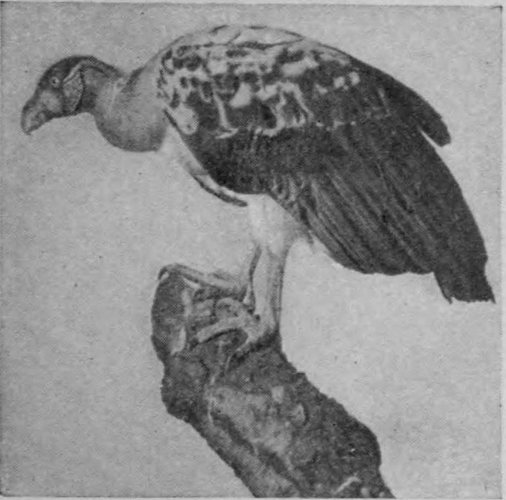
KING VULTURE.
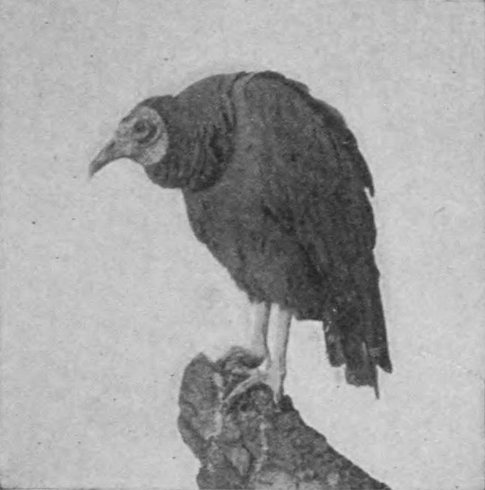
BLACK VULTURE.
The Lammergeyer or Bearded Vulture, (Gypaetus barbatus), is now probably extinct in Europe, but is still found in parts of Asia. It feeds largely on lambs.
A nearly cosmopolitan bird is the Golden Eagle, (Aquila chrysaetos). It is equally at home in the highlands of Scotland and the mountains of North America, nesting on the highest cliffs.
The Bateleur Eagle, of Africa, (Helotarsus ecaudatus), has narrowly missed the distinction of being the most beautiful of all birds of prey. Its plumage is charmingly colored but it is out of proportion. Its tail is so absurdly short that its wings quite conceal it, and make it appear as if altogether tailless.
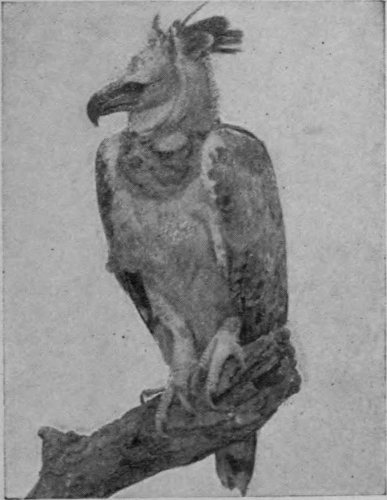
HARPY EAGLE.
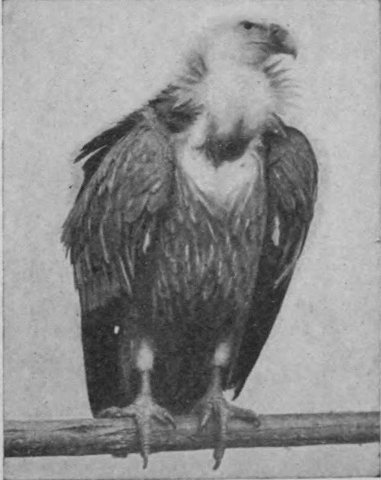
GRIFFON VULTURE.
Bald Eagle, (Haliaëtus leucocephalus).—The appearance of the adult Bald Eagle, our National emblem, with its conspicuous white head and tail, is familiar to all; but the immature birds, as shown by several of the specimens, lack the white in their plumage. These birds are found usually near water, and their food is chiefly fish. These they sometimes catch for themselves, but if ospreys are found in the vicinity, they are watched by the eagles, and often robbed of their hard-earned prey.
Perhaps the fiercest among all the hawks is the White Gyrfalcon, (Falco islandus). A native of the far north, it descends to a more equable clime only when forced to do so by scarcity of food. It is so swift of wing that it is able to capture a duck in full flight.
Sea snakes form the rather unusual food of the White-Breasted Sea Eagle, (Haliaëtus leucogaster), of the East Indies, while the strikingly-colored Vulturine Sea Eagle, (Gypohierax angolensis), a native of Africa, feeds on fish, crabs, and the fruit of the oil palm.
At the northern end of Squirrel Ridge, where the Alligator Walk intersects the Rodent Walk, an ideal quarter of an acre, of oak and hickory trees, underbrush, and bare rock, has been dedicated to the king of game birds.
The Wild Turkey, (Meleagris gallopavo silvestris), is a bird of magnificent size and presence, and the splendid metallic luster of his plumage—a mixture of burnished bronze copper, lapis lazuli, and fire opal iridescence—backed up by a great bulk of savory flesh, all combine to make this the finest game bird on earth. It was once fairly abundant throughout the eastern United States, and still is found in Pennsylvania, southern Ohio, Virginia and other southern states as far west as Texas. Three other species of Meleagris are now recognized—one in Florida, one in southern Texas and northeastern Mexico, and the fourth in Mexico, extending to western Texas and Arizona.
On the northwest quarter of Baird Court stands the largest and the most generously equipped home for perching birds now in existence. This is not an unnecessary boast, 147 but merely a brief statement of a fact which the visitor has a right to know. It was designed on our long-established principle that every captive wild creature is entitled to life, exercise and happiness. Our principle of very large cages, with many birds in each cage, is just the reverse of the views that have prevailed in the older zoological gardens, even down to the present day. To an important extent, the cage equipment of this building represents a new departure. There are many zoologists with experience longer than ours who believe that small birds thrive better and live longer when installed in small cages, with only one or two birds in each.
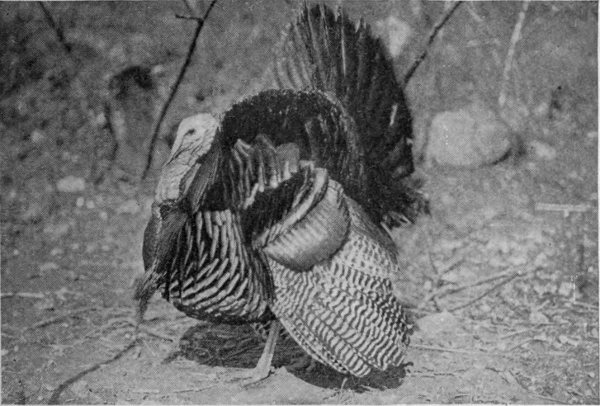
WILD TURKEY.
The Large Bird-House, specially designed for Passerine birds, was developed on the strength of experiments previously made in the Aquatic-Bird House, and in community cages outside. After three years’ experience with the new building, and a careful tabulation of diseases and death rates within it, we are able to state that this installation is a complete and gratifying success.
The Large Bird-House is an L-shaped building, with an all-glass house in its angle. The main hall extends east and west, and it is 60 feet long by 50 feet wide. This great room contains the foreign song-birds, many tropical doves and pigeons, and such tropical varieties and oddities as the 148 great crowned pigeons, tinamous, toucans, giant king-fishers and hornbills. In the great central flying cage there is perhaps the most remarkable omnium-gatherum of small tropical birds—swimmers, waders, upland game birds and perchers—ever brought together in one cage. The bottom of the L is the Parrots’ Hall, 65×30 feet. It contains the parrots, macaws, cockatoos, and a few other species.
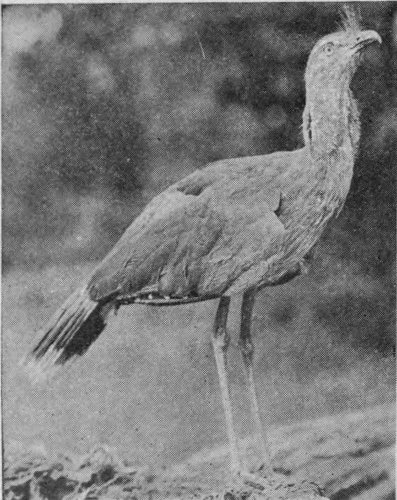
SERIEMA.
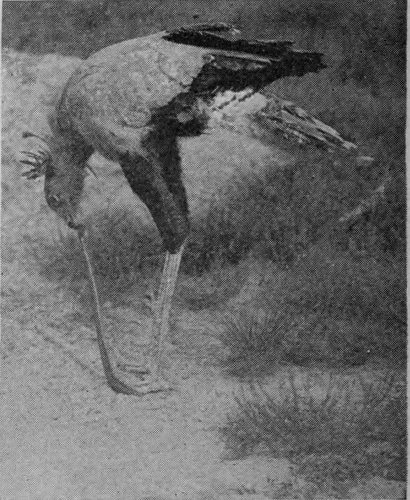
SECRETARY BIRD.
In the angle of the main building stands a structure almost wholly composed of metal and glass, which is known as the Glass Court. It was designed especially for North American song-birds. The visitor should not overlook the fact that there are cages filled with birds all along both the eastern and western sides of the Large Bird House.
Nearly all the cages of both the exterior and interior of the Main and Parrots’ Halls, are accessible from the back by passage-ways; a convenience that greatly facilitates the work of the keepers in caring for their various charges.
The capacity of this installation as a whole may be judged from the following memorandum of cages:
| APPROXIMATE SIZES OF CAGES OF THE LARGE BIRD-HOUSE | |||
|---|---|---|---|
| INDOORS. | |||
| Main Hall | Central Flying Cage | 15×36×20 feet high | 1 |
| Side Cages | 5×5×9 | 35 | |
| End Cages | 5×12×9 | 2 | |
| Parrot Hall | Side Cages | 6×8×9 | 21 |
| Glass Court | West Cages | 8×9×9 | 6 |
| East & North Cages | 5×6×8 | 16 | |
| OUTDOORS. | |||
| Northeast Cages | 7×12×10 | 2 | |
| East Cages | 6×8×10 | 10 | |
| Southeast Circular Flight Cage | 20×20×2 | 1 | |
| South Cages | 6×8×10 | 3 | |
| Large Western Cages | 15×15×15 | 3 | |
| Smaller Western Cages | 6×9×10 | 14 | |
| Total number of cages | 114 | ||
Regarding the state of health and spirits of the birds in this building, the visitor must be left to judge for himself. It is only fair to state, however, that the death rate here and indeed amongst the birds of the Park generally, is very low.
In view of the great number of avian species inhabiting the Large Bird-House, it is a practical impossibility to give more than a general outline of the groups and leading features of the collection.
As the visitor enters at the south door, nearest the Lion House, he is greeted by a discordant chorus of ear-piercing shrieks and squawks, joyous but very raucous, and at times too persistent. Loudest are the voices of the gorgeously-plumaged Blue-and-Yellow Macaw, (Ara ararauna); the Red-and-Blue Macaw, (Ara macao), and the Great Green Macaw. Around their cages there is no such thing as stagnation or somnolence. The soft-hued Rosella Parakeets, the flock of mostly-green Cuban Parrots, the Leadbeater Cockatoos and the White Cockatoos all join in their voices, to the limit of their respective abilities, but against macaws which can be heard a mile, their best efforts seem tame. The members of the Order Psittaciformes (as above) have been beautifully colored by Nature, and their harsh voices seem strangely out of harmony with their plumage.
The indoor cages along the western side of the Large Bird-House (both halls included), contain an extensive series of tropical Pigeons and Doves, which are well worth some attention.
The most startling exhibit in this group is the Bleeding Heart Pigeon (Phlogoenas luzonica), from the Philippines, whose creamy-white breast seems to have been recently stabbed with a stiletto. It is no wonder that now and then a sympathetic visitor seeks the curator, or a keeper, 150 and reports that a bird has been injured, and is bleeding from a wound in its breast.
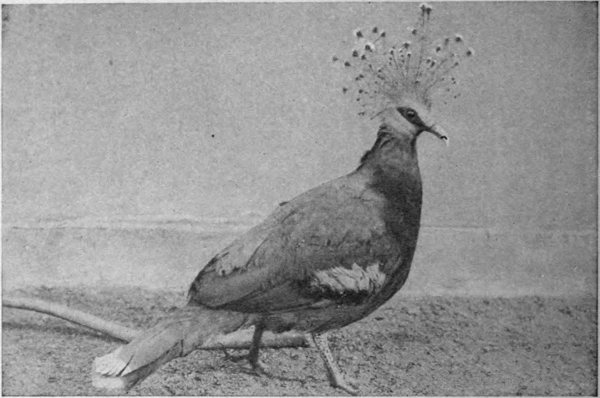
GREAT CROWNED PIGEON.
The Flying Cage in the center of the Main Hall contains a pool of running water, some small trees, an imitation rock, and the floor is covered with a comfortable layer of sand. Hopping or flying about, and perching on the trees, is a really remarkable medley of birds. There are the Wood Duck and Mandarin Duck, Black Skimmers, Common and Sooty Terns, several species of Teal, Curlews, Gallinules, Coots, Lapwings, Snipe, Ruffs, Quail, Francolins, Senegal, Turtle, Wonga-wonga and other Pigeons and Doves, Skylarks, Robins, Orioles, Cardinals, Woodpeckers, Java, Fox, Tree, and other Sparrows and Weavers.
The south side of the Main Hall is devoted to miscellaneous rare birds from the tropics, regardless of the Orders to which they belong. The largest are the Great Crowned Pigeons,—Victoria and Common,—the oddest are the Concave-Casqued Hornbills and the Toucans (eight species). The Rufous Tinamou, of South America, is a species which, through lack of use for its wings, is rapidly losing the power of flight. The Giant Kingfisher is the “Laughing Jackass” of Australia, and its cry is strangely like the mirthless horse-laugh of a man who has few smiles and seldom uses one. The Himalayan Jay-Thrush is so confirmed a murderer of birds smaller than himself, it is necessary 151 to quarter that species with other birds abundantly able to defend themselves against its attacks.
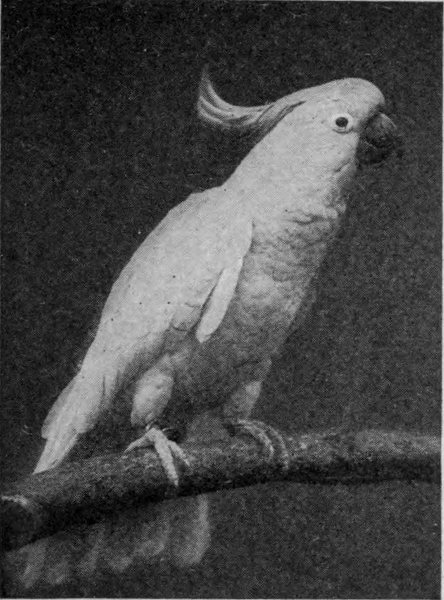
SULPHUR CRESTED COCKATOO.
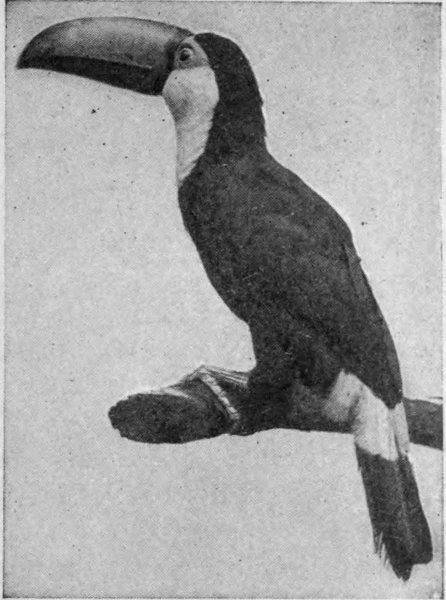
TOCO TOUCAN.
On the northern side of the Main Hall there will be found a very interesting group of Cuban birds, another of birds of the Bahamas, a fair-sized collection of Finches, Weavers, Canaries, Trogons, and other small species of foreign lands. Here also is the rare and beautifully-plumed Greater Bird of Paradise, (Paradisea apoda).
The visitor is reminded that for all cages that contain more than one species, the picture labels quickly furnish a key for identification of each.
In the Glass Court and around it, the Curator of Birds, Mr. C. William Beebe, has scored a gratifying success in the installation of the Order Passeres. The birds are arranged by Families, and all of the twenty-one families of eastern North American perching birds are represented. These Families are as follows: Flycatchers, Swallows, Wrens, Mockingbirds and Catbirds, Thrushes, Kinglets, Vireos, Waxwings, Shrikes, Chickadees, Nuthatches, Brown Creepers, Warblers, Pipits, Horned Larks, Sparrows, Honey Creepers, Tanagers, Blackbirds and Orioles, English Starling, Crows and Jays. It is only those who have attempted to form and install such a collection who can appreciate the effort which that collection has cost, or the difficulties involved in the maintenance of so large a number of insect-eating 152 birds. The birds in this section of the Bird-House are especially interesting to the teachers of pupils of the public schools of this city.
The large circular flying cage, at the outer corner of the Glass Court, is filled with Robins, Bluebirds, Thrushes and Woodpeckers which winter there very comfortably, because they are fed and watered, and sheltered from the worst storms.
Along the western wall of the Large Bird-House, outside, fourteen large cages are filled with members of the Crow and Blackbird Families (Corvidae and Icteridae), such as the Ravens, Crows, Jays, Magpies, Blackbirds, Meadowlarks, Cowbirds and Grackles, beside which appear our old friends the Yellow-Shafted Flicker and Red-Headed Woodpecker.
The following is a systematic enumeration of the Orders of birds represented in the Zoological Park on April 1, 1913:
| LIST OF BIRDS, APRIL 1, 1913. | |||
|---|---|---|---|
| ORDERS. | Species. | Specimens. | |
| Rheiformes | Rheas | 2 | 2 |
| Struthioniformes | Ostriches | 2 | 2 |
| Casuariiformes | Emeus and Cassowaries | 2 | 3 |
| Tinamiformes | Tinamou | 5 | 5 |
| Galliformes | Quail and Pheasants | 88 | 204 |
| Turniciformes | Hemipodes | 1 | 2 |
| Ptericlidiformes | Sand Grouse | 1 | 1 |
| Columbiformes | Pigeons and Doves | 57 | 183 |
| Ralliformes | Coots and Gallinules | 15 | 35 |
| Lariformes | Gulls and Terns | 17 | 54 |
| Charadriiformes | Plovers and Sandpipers | 18 | 48 |
| Gruiformes | Cranes, Seriema | 13 | 30 |
| Ardeiformes | Ibises, Storks and Herons | 35 | 85 |
| Palamedeiformes | Screamers | 3 | 4 |
| Phoenicopteriformes | Flamingoes | 2 | 5 |
| Anseriformes | Swans, Geese and Ducks | 72 | 712 |
| Pelecaniformes | New World Vultures | 9 | 30 |
| Cathartidiformes | Cormorants and Pelicans | 8 | 27 |
| Serpentariiformes | Secretary Birds | 1 | 2 |
| Accipitriformes | Hawks and Eagles; Old World Vultures | 28 | 48 |
| Strigiformes | Owls | 20 | 47 |
| Psittaciformes | Parrots, Macaws and Cockatoos | 86 | 194 |
| Coraciiformes | Kingfishers and Hornbills | 12 | 15 |
| Trogoniformes | Trogons | 1 | 1 |
| Cuculiformes | Touracos and Cuckoos | 10 | 18 |
| Scansoriforme | Toucans and Barbets | 8 | 13 |
| Piciformes | Woodpecker | 9 | 26 |
| Passeriformes | Thrushes, Sparrows and all perching birds | 378 | 1242 |
| Totals | 903 | 3038 | |
As the birds on this pond have been transferred from the Duck Aviary, the interest of this exhibit is of special character, and greatly enjoyed by hosts of visitors. This is the nursery of the ducks and geese, where, in the tangle of long grass, briars and underbrush along the east side of the pond, the nests are built in early spring, the eggs are laid and patiently incubated. Finally the broods of ducklings are led to the water, to feed to repletion, throughout the summer, on the worms, bugs and insects so dear to the appetite of these amusing little fellows.
Cope Lake is the especial province of the nesting pairs of Canada geese, and sometimes as many as eight golden-colored goslings are hatched in one nest on the small island.
The Mallard Duck, (Anas boschas), is one of our finest swimming birds, the joy of the sportsman who finds it in its haunts, the delight of the epicure who finds it on the bill of fare. Sluggish indeed must be the blood which does not beat faster at the sight of a flock of wild Mallards, free in Nature, and ready to leap into the air and away at the slightest alarm. After the pintail and the wood duck, this is one of the handsomest ducks of North America, and also one of the finest for the table. Its range covers practically the whole of the western continent down to Panama, and even extends to the Azores, north Africa, and northern India. The drakes are readily recognized by the splendid irridescent green of the head.
The Green-Winged Teal, (Nettion carolinensis), and Blue-Winged Teal, (Querquedula discors), are very delicate birds, and therefore rather difficult to maintain in captivity. A flock of each will be found in the Flying Cage.
The Pintail Duck, (Dafila acuta), is specially commended to the notice of visitors because of its great beauty, both in color and form. Its colors form an exquisite harmony of 154 soft brown and gray tones which fairly rival the more gaudy color-pattern of the wood duck. The species is yet found occasionally along the Atlantic Coast, but like all other edible birds, its numbers are rapidly diminishing. A large flock of these birds will be found on the Wild-Fowl Pond.
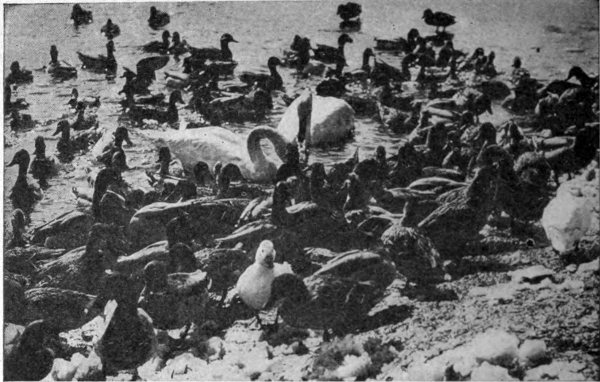
DUCKS FEEDING: WILD FOWL POND.
The Gadwall, (Chaulelasmas strepera), is a handsome gray bird, well known to gunners along the Mississippi Valley, but rarely seen along the Atlantic coast. Its chief breeding grounds are in the great marshes of central Canada.
The Baldpate, (Mareca americana), one of the finest of water-fowl, is now so scarce that it is difficult to obtain specimens for exhibition. These birds are poor divers, but gain a good livelihood by feeding on floating sea lettuce, disturbed from the bottom by the better equipped canvas-backs and redheads.
The bill of the Shoveller, (Spatula clypeata), has become so specialized for mud-sifting that it has actually assumed the shape of a shovel, and is out of all proportion to the size of the bird’s body. The sides of the bill are equipped with bony plates, through which the mud is strained, the particles of food being caught and swallowed.
The Canvas-Back (Aythya vallisneria), and the Red-Head, (A. americana), two prime favorites with the sportsman and epicure, are exhibited on the Wild Fowl Pond. Of the latter, 155 a good-sized flock is shown. Canvas-Backs, however, are difficult to capture unhurt, and still more difficult to keep alive in captivity, and for these reasons the number exhibited always is very small.
The Lesser Scaup, (Marila affinis), is one of the sea ducks, and, like its congeners, a very expert diver. It feeds chiefly on mollusks, which it finds in the mud, often at considerable depths under water.
The Paradise Sheldrake, (Casarca variegata), of Australia, is a striking bird, occupying a position mid-way between the ducks and geese. It is interesting to note that the female is much more attractive than the male, the head and neck being pure white, in contrast with the more sombre body. This species is very quarrelsome in captivity.
The Ruddy Sheldrake, (Casarca casarca), is a bird of wide distribution, being found from the Mediterranean countries to Japan, and also in northeast Africa. Both sexes are of a uniform light chestnut, the male being distinguished by a black ring around the neck. The nest is always well sheltered, often being placed in a hollow log.
The Common or Tadorna Sheldrake, (Tadorna tadorna), is a remarkably colored bird, but unfortunately difficult to keep alive in this climate. It nests in holes in the ground, preferably in disused rabbit burrows.
The Mandarin Duck, (Aix galericulata), is the Chinese counterpart of our beautiful Wood or Summer Duck, (Aix sponsa). Of all living ducks, the males of these two species are the most gorgeously colored and plumed, and they are also of elegant form. Although both species are much sought after, the number of available specimens continues to be limited to a comparatively small number.
The Pheasant Aviary is a building like a corridor 240 feet long with a cross pavilion at each end. The main structure is divided into 22 shelters connecting with a like number of wire enclosed outside runways, each of which is 8 feet wide, 24 feet long and 8 feet high. The two end pavilions furnish 32 smaller shelters and runways, making a total of 48 compartments. The shelters are divided into two stories, the upper series being designed for pigeons, doves and perching birds of various kinds. Each bird in this aviary can at every moment of his life choose according to his needs from the following series of accommodations that are available to him: An open, sunlit yard, a storm shelter with an open front, or a closed room with one small door and a large window.
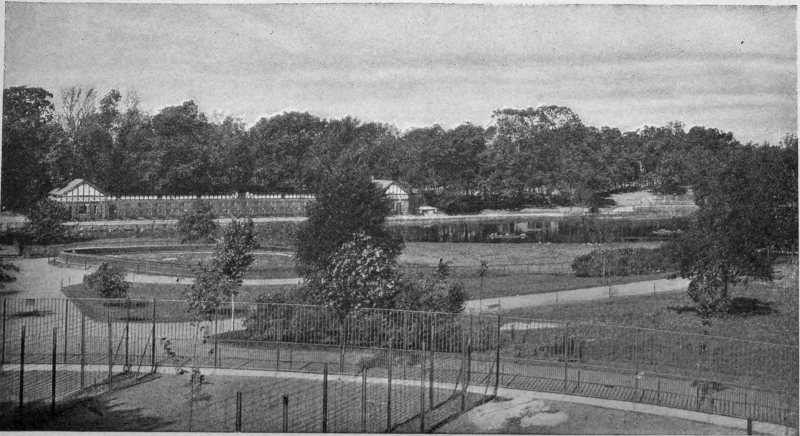
PHEASANT AVIARY AND WILD FOWL POND.
This beautiful and generous installation, 240 feet long, with 48 runways, accommodates the true Pheasants of the world, the largest group of birds of the Pheasant Family (Phasianidae), which in turn is one of the grand divisions of the sportsman’s own Order Gallinae, or upland gamebirds. Of the whole Order Gallinae,—which includes the Grouse, Ptarmigan, Partridges, Pheasants, Turkeys, Guinea-Fowls, Jungle Fowl, Quails, Brush-Turkeys, Curassows and Guans—the group of the Pheasants can justly claim the distinction of possessing the most beautiful birds. Indeed, I think there is not to be found in the whole avian world a group of game birds all the members of which, taken species by species, are so gorgeously apparelled as these.
In this brief notice of what is really one of the finest pheasant collections in the world, it is not possible to do more than direct the visitors’ attention to its chief items of interest. It must be stated well in advance, however, that these are birds of very shy and retiring habit, which owe their existence as species to the success with which they retreat from danger, and conceal themselves from man and beast. These birds must not be forced to spend all the daylight hours in their runways; for some of them could not long survive such exposure and excitement. To preserve their lives, and keep them in health, they must have the privilege of retiring into their shelters whenever they desire. But they roam in and out, and by the exercise of a little effort in returning to them, the interested visitor will find no great difficulty in seeing all the species.
There are few species of pheasants whose members are sufficiently peace-loving that many individuals can be kept together without deadly combats. Of most species save the golden, silver and ring-neck, the cocks are so quarrelsome that even two can not be kept together; and this fact constitutes a handicap upon those whose duty it is to maintain the full strength of the exhibition. If a rare and quarrelsome male pheasant dies unexpectedly, it is not always possible to fill the vacancy on short notice.
Out of the half-dozen species which claim first place in an enumeration based on beauty and luxuriance of plumage—the 158 Amherst, Reeve, golden, silver, impeyan, Argus or Soemmerring—it is difficult to choose. Each has its share of strong points, and it seems as if there is no “finest of all.” Let us take them as they come to mind, for by reason of the changes so often necessary in the runways, it is inexpedient to attempt an end-to-end enumeration.
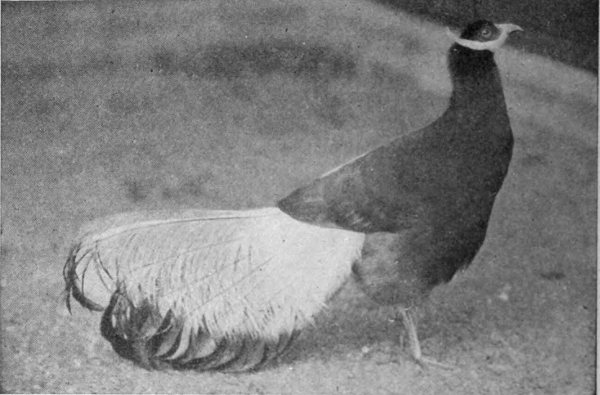
MANCHURIAN EARED PHEASANT.
The Golden Pheasant, (Chrysolophus pictus), is a universal favorite; and it well deserves its wide popularity. Although small, it is as beautiful as the most entrancing sunset ever seen. It is very alert and chic, it is so good tempered that we can have the rare pleasure of seeing a whole flock in one runway, and it is a good breeder. To crown all these fine qualities, it is so hardy, and so competent a “rustler” in seeking food that under fair conditions it is easily transplanted from its native home in western and southern China. It has been introduced and acclimatized with gratifying success in Oregon, Washington, southern British Columbia near the Pacific coast, and elsewhere. In the shooting season, the shops of the taxidermists of Vancouver and Portland are filled with these gorgeous creatures, which appreciative sportsmen have found “too beautiful to eat.” One might as well try to describe a sunset as to pen a mental picture of the wonderful combination of golden yellow, orange, lapis-lazuli blue and deep crimson that appear in the plumage of this gorgeous bird.
The Amherst Pheasant, (Chrysolophus amherstiae), is the 159 nearest relative to the golden species, and also a strong candidate for first honors on the score of beauty. As far as you can see the cock bird, you can recognize it by its marvellous cape of pure white feathers marked with semicircles of black and steel-blue, which reaches from its eyes far back upon the shoulders. It is also easily recognized by its enormously long tail, the middle feathers of which are conspicuously marked by a regular series of diagonal bars of black laid on a light ground color. This bird is of small size, and fortunately for the public, it breeds in confinement with sufficient readiness that a good supply for exhibition purposes is thereby maintained.
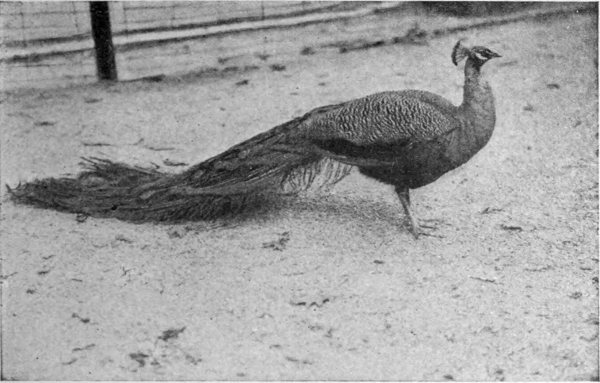
INDIAN PEACOCK.
The Silver Pheasant, (Gennaeas nycthemerus), of China, is Nature’s “running mate” for the golden pheasant, not only in the rocky hill forests of southern China, but in acclimatization, in captivity, and everywhere else. Wherever you see a golden pheasant, look for the Silver also, with its showy, snow-white tail, and white mantle of feathers which covers the whole upper two-thirds of the bird from its ears to its tail. Its dark-colored under surface serves well to accentuate the whiteness of its other parts. It is a larger bird than the golden and Amherst pheasants, but it is so good tempered that every summer two or three cock birds are kept in the great Flying Cage along with many small and defenseless birds which might easily be molested. In parks which are not visited by great numbers of people, 160 both this species and the golden are easily domesticated, and permitted to roam at will.
The Reeves Pheasant, (Syrmaticus reevesi), of northern China, is a most beautiful species, closely related to the Japanese, Elliott, Hume and Soemmerring pheasants,—all of them fine, showy birds. Like the Amherst, the Reeves Pheasant has a very long tail, which in fully adult or old male birds often attains a length of five feet. When you see in captivity a pheasant with an enormously long tail, it is safe to assume that it is either an Amherst or a Reeves.
The Soemmerring Pheasant, (Phasianus soemmerringii), sometimes very aptly called the Copper Pheasant, is a native of Japan, and a bird of which any country might well be proud. In size, form and length of tail it matches the common ring-necked pheasant. Its head and neck plumage is of a warm copper-bronze tint, but its most beautiful colors are found in the elaborate cross-bar markings of its tail. The pattern of the latter reveals first a strong cross-bar of chocolate brown, above that a broad band of fawn-color, and this blends into a mottling of black on cream-color, edged across with black.
The True Ring-Necked Pheasant, (P. torquatus), of China, brings to view a question that frequently is asked regarding the English Pheasant, (P. colchicus), which is the common species of southeastern Europe and Asia Minor, and of Great Britain and other continental areas by introduction. We are asked, “Has the English Pheasant a white ring around its neck, or not?”
The answer is, the true, pure-blooded English, or Common Pheasant, (P. colchicus), has no ring around its neck; but so many persons have crossed the true Ring-Necked Pheasant, of China, with that species that in many flocks of the former species the majority of the individuals are of mixed breed, with necks perceptibly ringed, yet passing as English Pheasants. As a matter of fact, in the world to-day, pure-blooded English Pheasants are rare. Both the English and Ring-Necked species have been successfully introduced into several portions of the United States.
While on this subject, we will here record the fact that the name Mongolian Pheasant, as often applied to the Ring-Neck, is a misleading error. The real Mongolian Pheasant, of Turkestan, (P. mongolicus), is a species of such extreme rarity that it is almost unknown, alive, in the United States. A fine pair of these birds is now on exhibition at the Pheasant Aviary.
The Argus Pheasant, (Argusianus argus), is a bird with a great reputation for beauty, but as seen alive in zoological collections it does not always come up to expectations. Both its secondary feathers—which when fully developed are of enormous length—and its primaries, are extremely beautiful; but unfortunately those beauties are not visible until the bird is dead, and its plumage displayed in a manner very rarely adopted by the living, captive bird. But the eyes on the huge secondary feathers are wonderful, and each primary is a dream in ecru and brown tints, laid on in a most elaborate pattern. The Argus Pheasants are most shy and wide-awake birds, inhabiting the dense, hot and moist jungles of Borneo, Sumatra and the Malay Peninsula, and are almost impossible to shoot. They are snared by the Dyaks and Malays, and after the skin has been removed and carefully preserved for museum purposes, the flesh is as fine eating as the breast of a quail and quite as palatable. A few successful attempts have been made to breed this species in captivity.
The Impeyan Pheasant, (Lophophorus impeyanus), is the neighbor of the Himalayan tahr, the burrhel, the ibex and the markhor, and the delight of every sportsman who dares the rocks of “the Roof of the World” in quest of Himalayan big game. Its beauty is due chiefly to its metallic colors, and the splendid iridescence of its plumage. Its home is in the world’s most gigantic mountains, and it is not uncommon for a bird that has flown out from a mountain-side and been shot on the wing to fall 2,000 feet, and beyond human reach. No wonder this bird is popular with Anglo-Indian sportsmen.
The Pheasant Aviary is a double installation, and as an aviary for Pigeons and Doves it is quite as perfect as it is for Pheasants.
During the year 1910 and part of 1911, the pheasants of the Old World were studied in their haunts by Mr. C. William Beebe, Curator of Birds. By reason of a cash gift to the Zoological Society made by Col. Anthony R. Kuser, he was enabled to make the expedition. The results will be embodied in an elaborate monograph, which probably will be published in the near future.
Originally it was our intention to devote this fine building solely to the great “running birds,”—Ostriches, Rheas, Emeus and Cassowaries; but the pressure for space has been so great that this intention never has been carried into effect, and we fear it never will be. There are so many cranes, seriemas, tropical vultures and other large birds which appeal for space in these very pleasant and healthful quarters, we have felt compelled to set our original plan half at naught. It seems probable that some of the feathered interlopers now in the Ostrich House will remain there, indefinitely—or at least until we erect a Crane Aviary.
Architecturally, the Ostrich House is the counterpart of the Small-Mammal House, the two being identical in size and form, and connected by a handsome pavilion. Each building is 170 feet long, and 54 feet wide. The Ostrich House contains 13 cages, each 10×12 feet, by 8 feet in height. A flood of warm light pours through a glass roof into these cages, and makes them as light as the yards without. It is no wonder that birds thrive in this building. Movable partitions were provided, so that a few of the cages might be subdivided whenever necessary. This provision has proven of much practical value.
Each interior cage connects with a spacious outside yard, in which the big birds spend the warm months. The yards are enclosed by wire fences, and to the eye of the visitor they are open from three directions.
The members of the Subclass Ratitae,—once called the Cursores, or the “running birds,”—are the present-day giants of the avian world. We have reason to be glad that all these splendid birds did not disappear from the earth before ornithology took form as a science. Undoubtedly, they mark the end of the line of birds of their kind, for the far-reaching destructiveness of civilized man has already put a period to the natural evolution of animal life. To-day, the preservers of wild life are engaged in a hand-to-hand struggle with the annihilators, over the preservation of a remnant for those who come after us.
The African Ostriches are now very prominently in the public eye, not because of their relationship to the Dinornis and Aepyornis of the past, but by reason of the value of 163 their plumes in enhancing the attractiveness of woman. And surely, no plume-bearing bird ever enlisted in a better cause, or on a more satisfactory basis; for to-day the plume crop is being grown and plucked and marketed with almost as much certainty as the annual crop of wool. In the United States, the most important plume-producing ostrich farms are situated in southern California and Arizona, where the industry is quite successful. So valuable are the adult birds that it is possible to purchase specimens imported from Africa for less money than would be necessary to procure them in the United States.
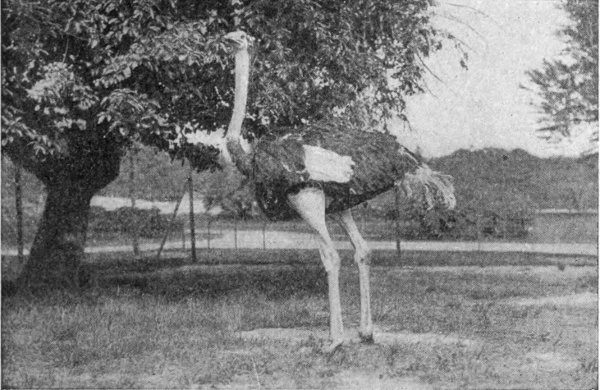
NORTH AFRICAN OSTRICH: MALE.
A full-grown male African Ostrich stands 8 feet in height, and weighs about 300 pounds. Its value on arrival in New York, before acclimatization and moulting into perfect plumage, is from $200 to $250. The female lays about 90 eggs in a year, each of which is equal to about 20 hen’s eggs. The time of incubation is about 40 days. In captivity only about 60 per cent of the eggs hatch, and of those not more than one-half live to attain full maturity. The plumage of immature birds and adult females is gray, but that of the adult male is black on the body, and white on the wings and tail.
The South African Ostrich, (Struthio australis), differs from the species found in the north. The color of the naked skin of its neck and thighs, and the front scales on 164 its metatarsus, is distinctly bluish, and dark. This is the species of the southern half of Africa, now so successfully farmed in Cape Colony for its feathers that the annual crop is said to yield about $5,000,000. And it is this species which is kept on the ostrich farms of California and Arizona.
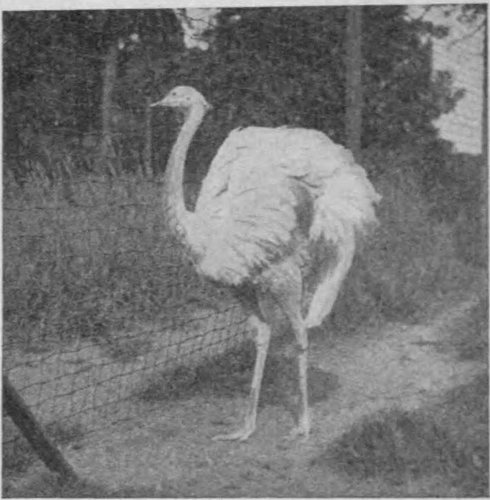
RHEA.
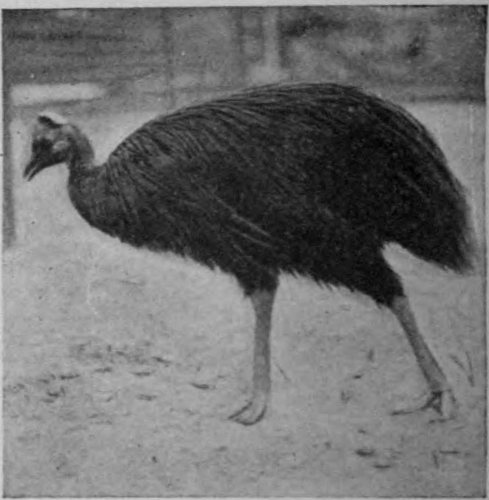
CASSOWARY.
The North African, or Sudan Ostrich, (S. camelus), is the species first and longest known. Its neck, thighs and front metatarsal scales are of a decided pink color. Originally the range of this species extended from north Africa well into southwestern Asia, embracing Arabia, Syria and Mesopotamia.
Generally speaking, the African Ostriches originally covered all the open, sandy plains of Africa; but they never inhabited the regions of dense forests. To-day their total inhabited range is small, and rapidly becoming more so. It is highly probable that within the life period of many persons now living, wild Ostriches will totally disappear from the earth.
The Common Rhea, or South American Ostrich, (Rhea americana), represents a group of ostriches much smaller than those of Africa, and found only on the open plans of Argentina and Patagonia, below the great equatorial forest belt. There are three species in the group. In general terms it may be stated that an adult Rhea is about two-thirds the size of an adult African ostrich. It is with great difficulty that these birds are reared to maturity in the United States.
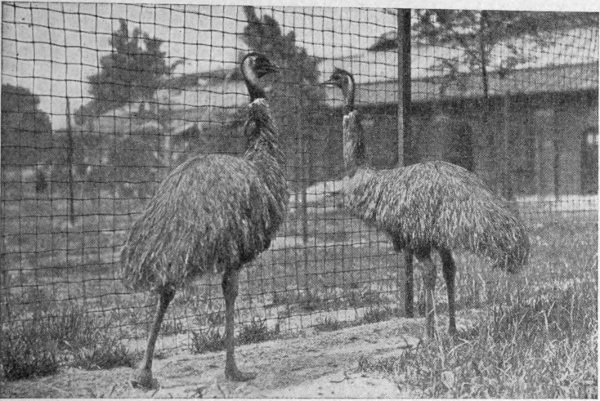
EMEUS.
The Common Emeu, (Dromacus novae-hollandiae), of Australia, is the neighbor of the kangaroo and wallaby, and in form is as odd as are the majority of the birds and mammals of that continent of strange creatures. Its body suggests a pile of gray-brown hay elevated on stilts, to one end of which a hay-covered neck and head have been attached. The bird-lover should make much of this creature, for in its home country it has been almost exterminated. Fortunately, in climates reasonably well suited to it—but not in or near New York—it is possible to breed this bird in captivity. In size the Emeu is next to the African ostrich.
The Ceram Cassowary, (Casuarius casuarius), of the Island of Ceram, Malay Archipelago, represents a group which contains a number of well-defined species which are scattered through the northern cape of Australia, New Guinea, the Aru Islands, Ceram, and other islands of Malayana east of Celebes. They are all distinguished by their glossy purple or black body plumage—which looks far more like coarse hair than like feathers—their huge legs, and their helmeted heads. The differences between species are based chiefly upon the bright orange red and purple colors of their upper necks and wattles.
In size the Cassowaries are all of them smaller than the emeus. In captivity they are the best of all the large cursorial 166 birds, and live longer than either ostriches, rheas or emeus. They are essentially birds of the thick forests rather than open plains, and can not bear the glaring light and heat of midsummer that is the delight of an ostrich. In captivity they are very apt to be quarrelsome toward each other.
Miscellaneous Birds in the Ostrich House.—At present these are so numerous and so important it is necessary to mention a few of them, even though the labels may be supposed to speak for them. They fall into several groups, chiefly birds of prey and cranes.
One of the most remarkable creatures in the entire collection is the Secretary Bird, (Serpentarius serpentarius). It is well known as a snake killer, its attacks being made with the feet alone, and never with the beak. Its long legs are remarkably powerful, and capable of dealing a crushing blow, always aimed at the head of the victim. Although it does not resemble the hawks and eagles in general appearance, it is in reality one of this group, and might well be described as a “hawk on stilts.” The snakes, frogs, small animals and birds which form its diet are generally swallowed entire. The long cockades of black feathers falling backwards at each side of the head are said to have suggested the name Secretary Bird, from a fancied resemblance to a quill stuck behind the ear of a clerk.
The Brush Turkey, or Telegalla, (Catheturus lathami), is a bird of the dark tropical forests of New Guinea and Australia. For many years it has been regarded as a zoological wonder, because of the remarkable manner in which it nests and produces its young. Instead of building a small, hollow nest, and hatching its eggs by the heat of its own body, it pursues the plan of the crocodile! Choosing an open spot in the forest it builds a huge mound, and as the structure rises, it lays its eggs in the heart of it. Turning its tail to the mound-site, this absurd little bird—no larger than a barnyard hen—scratches about right and left, gathers a big footful of small dead sticks, grass and dirt, and fiercely flings it backward upon the pile. A Brush Turkey in good working order can fling a bunch of jungle debris fully ten feet. Usually the finished mound is about three feet high by ten feet in diameter on the ground, and contains two or three cart-loads of sticks, leaves and grass. The eggs are deposited in a circle, well separated from each other, and each newly hatched bird must scratch out or die. Of course, 167 the eggs are incubated by the heat of the sun and the fermentation of the mass. When hatched, the young chicks are able to fly.
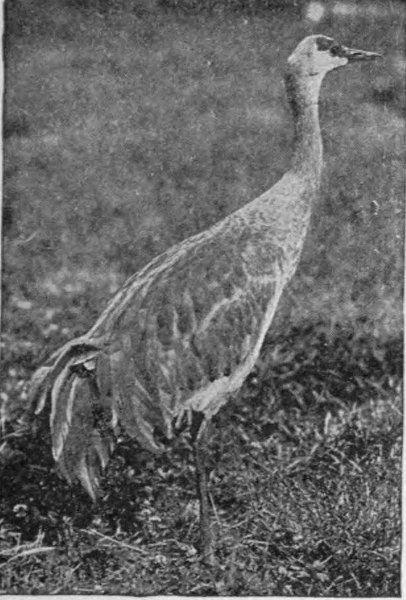
LITTLE BROWN CRANE.
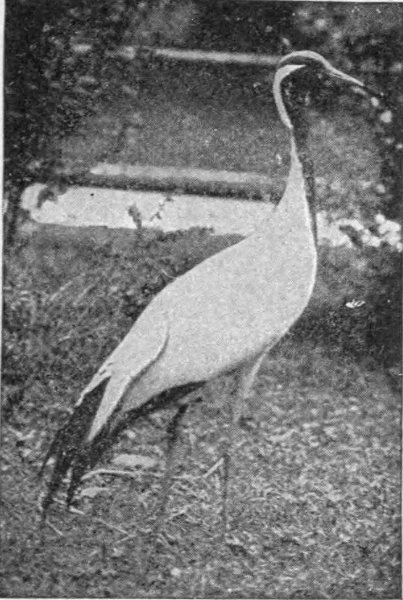
DEMOISELLE CRANE.
At present the Cranes of the Zoological Park are divided between the Ostrich House and the Aquatic Bird House, and their environs. In summer there are exhibits of these birds in the outdoor yards adjacent to each of those buildings. Recently, a number of species have been acclimatized in the Crane Paddock, and are to be seen there winter and summer.
The Whooping Crane, (Grus americana), is the largest, the handsomest and the rarest crane species in America. Its great size and its pure-white plumage—except its primaries—render it conspicuous from afar, and its voice will carry half a mile. The arched secondary wing feathers of the adult give the bird a very jaunty appearance. This species is so rare that thus far we have been able in eight years to secure only three specimens. The Whooping Crane nests in summer in the Arctic regions, but in winter it ranges as far south as Mexico. Our specimens of this bird will in summer be found in the large paddock immediately north of the Aquatic Bird House, with the next species.
The Sandhill Crane, (Grus mexicana), is smaller than the preceding species, more common, and is frequently seen in 168 captivity. Its color is slaty-blue. It is found in the southeastern United States, but once was fairly common throughout the Mississippi valley. In captivity this bird often indulges in some very droll antics—at times actually dancing. The adult males are often quite pugnacious, and inclined to attack those who go near them, and all visitors are warned not to go within striking distance of them. Children especially should not be permitted to climb over the guard wires, and approach close up to the cranes’ fences.
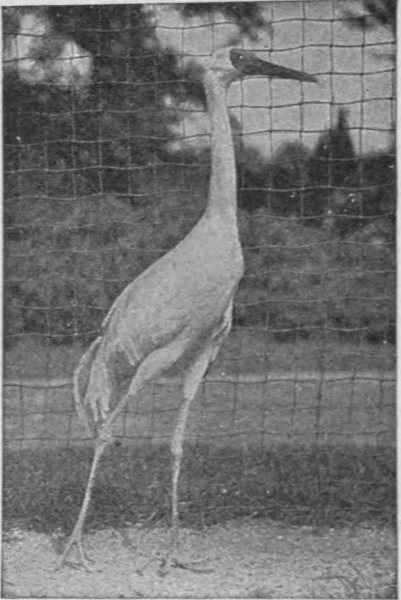
ASIATIC WHITE CRANE.
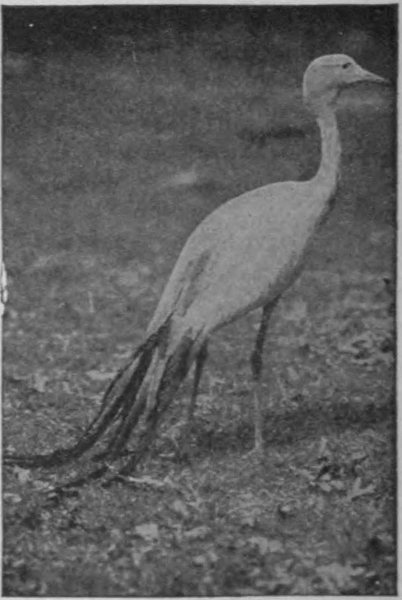
PARADISE CRANE.
The Sarus Crane, of the plains and sand-bars of northern India, (Antigone antigone), greatly resembles our sandhill crane, but is a much larger bird. This also is a quarrelsome species, and in captivity individuals are inclined to be cruel toward each other.
The Asiatic White Crane, (Sarcogeranus leucogeranus), is like a modest understudy to our whooping crane, in all respects save the elevated tail-crest. It is a bird of wide distribution.
The Paradise Crane, (Tetrapteryx paradisea), of the open plains of Africa outside the deserts, is a slaty-blue bird with a head so puffed out with side feathers that it looks almost reptilian. Its tail-feathers taper out to infinity, and gracefully droop quite to the ground. The little African Demoiselle Crane, (Anthropoides virgo), is so diminutive, so dainty in appearance and so gentle-spirited that its young-ladylikeness has been proclaimed in its name. Of all 169 foreign species of cranes, it is the one easiest to procure, and the most satisfactory to keep in collections. It never quarrels, it is very sociable in its habits, and thrives in captivity.
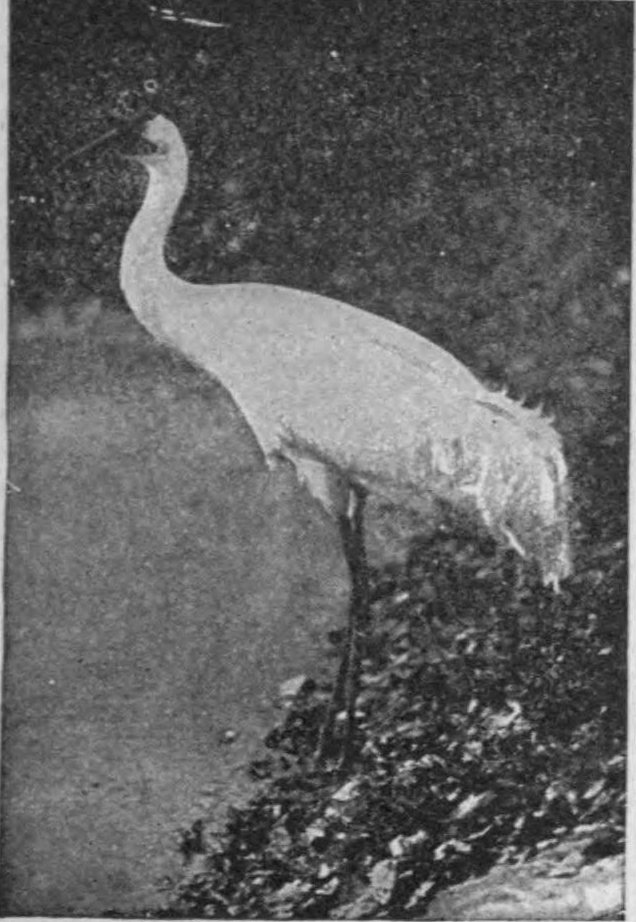
WHOOPING CRANE.
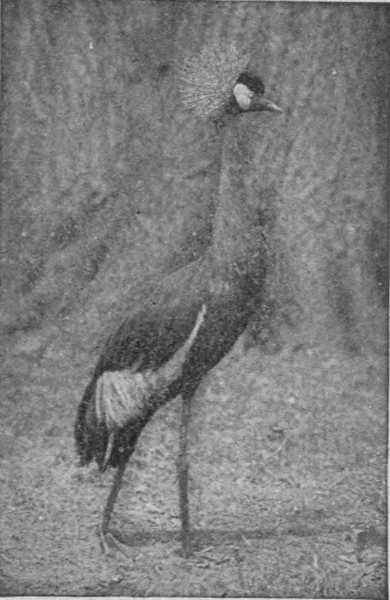
CROWNED CRANE.
The Crowned Crane, (Balearica pavonina), also of Africa, is, perhaps, the most beautiful of all living cranes. It is of medium size, royally colored, and strikingly set off with a conspicuous crown of stiff, quill-like feathers that stand as erect and regular as the aigret of an Indian prince.
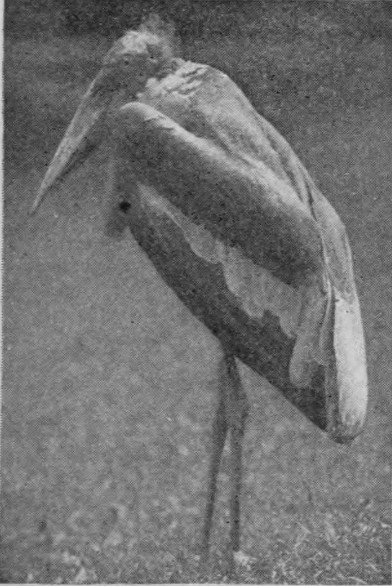
ADJUTANT.
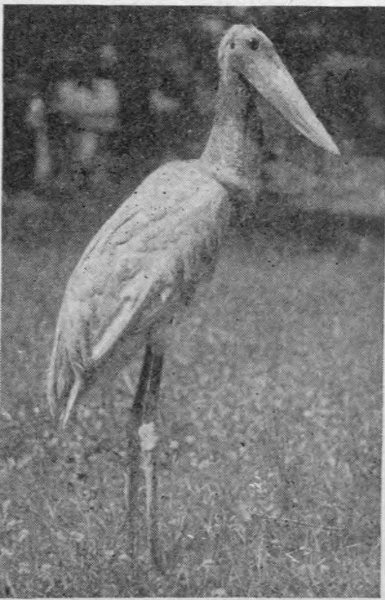
JABIRU.
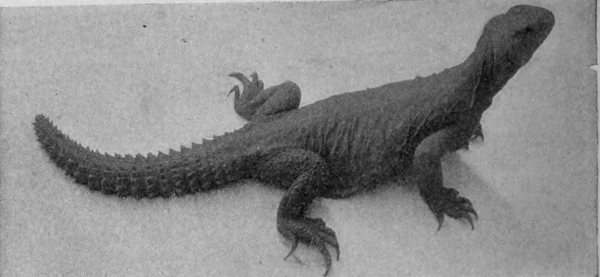
MASTIGURE.
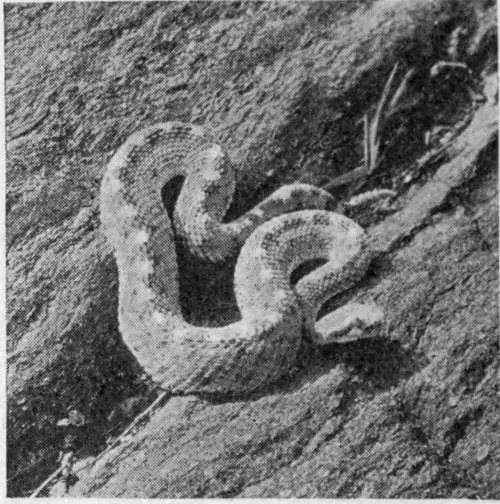
HORNED RATTLESNAKE.
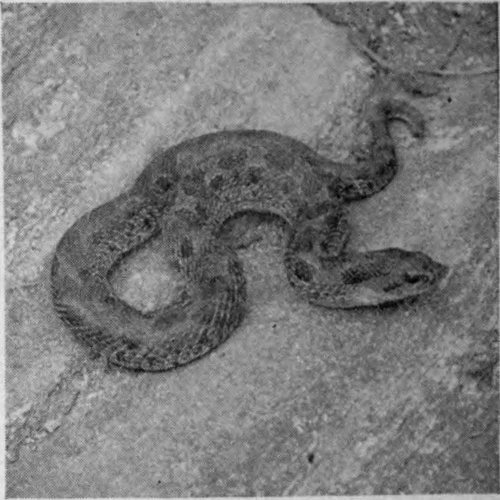
HOG-NOSED SNAKE.
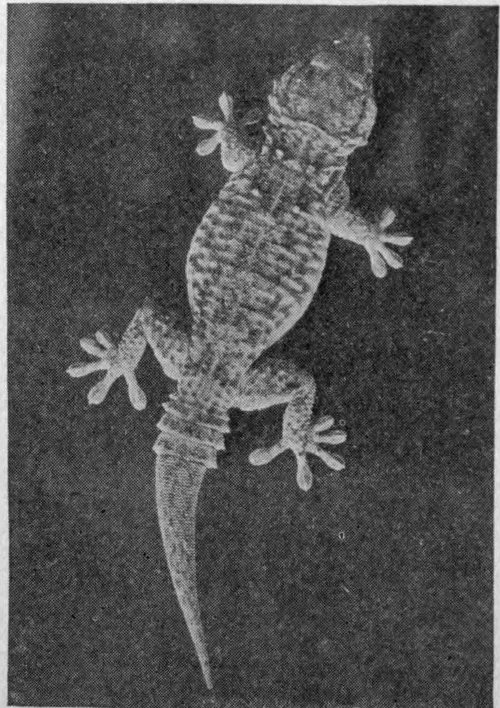
GECKO.
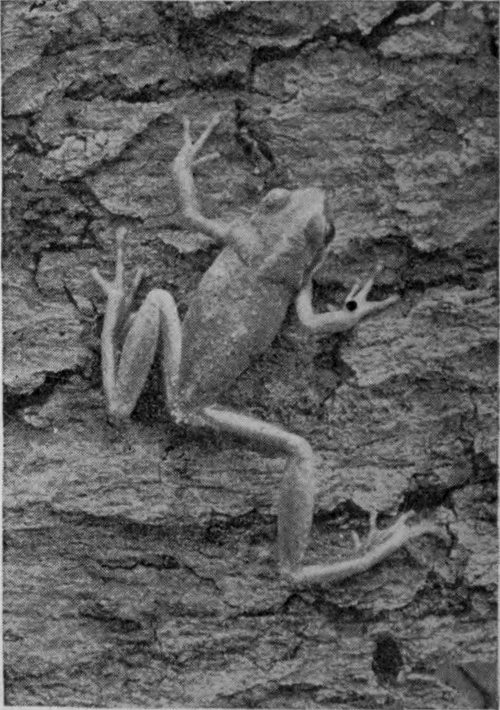
TREE FROG.
The Reptile House was the first large building erected in the Zoological Park. It represents an earnest effort to present carefully selected examples of the reptilian Orders, in a manner which may afford the visitor and the student a general view of the important groups of living reptiles.
The length of the Reptile House, over all, is 146 feet, and its greatest width is 100 feet. It is constructed of buff mottled brick, combined with granite and Indiana limestone. In the ornamental cornice of terra cotta, reptilian forms modelled by Mr. A. Phimister Proctor, the well-known animal sculptor, constitute an important feature. The building is roofed with slate, heated by hot water, and cost, with its cages, about $50,000. It is beautifully situated on the edge of a forest of primeval oaks, very near the geographical center of the Park.
The great center hall is unbroken by a single column, and at one end it opens across the Crocodile Pool and its sandbanks, through three huge arches, into the green, jungly mass of the conservatory. Of the tropical vegetation massed behind the pool—palmettoes, bayonet cacti, yuccas, and the like, and the tillandsias, Spanish moss, resurrection ferns, and butterfly orchids,—nearly the whole came from Florida, along with five alligators which were the first occupants of the pool.
In effect, the central hall appears to be 115 feet in length, by 40 feet wide, exclusive of the cages. But, large as this building is, it would be an easy matter to fill all its available space with the reptiles of North America alone, choosing only the handsome and showy forms. As we contemplate the great number of species in our own reptilian fauna, the thought occurs, what can we do with the reptiles of the Old World? Manifestly, the only proper course is to choose from the reptiles of the world the forms which will make for our visitors and students the most instructive and attractive series of important types.
On April 1, 1913, all these examples are on exhibition in the Reptile House:
| ORDERS. | CONSPICUOUS EXAMPLES. | LOCALITY. |
|---|---|---|
| LIVING REPTILES. | ||
| Turtles, or Chelonia. | ||
| Aligator Turtle | Louisiana. | |
| Snapping Turtle | Zoological Park. | |
| Box Turtle | Zoological Park. | |
| Giant Tortoise | Galapagos Island. | |
| Gopher Tortoise | Florida. | |
| Painted Turtle | New York. | |
| Green Turtle (marine) | New York. | |
| Soft-shelled Turtle | Indiana. | |
| Saurians, or Crocodilia. | ||
| Alligator | Florida. | |
| Florida Crocodile | Southern Florida. | |
| Broad-nosed Crocodile | Africa. | |
| Lizards, or Lacertilia. | ||
| Iguana (I. tuberculata) | West Indies. | |
| Horned “Toad” | Arizona. | |
| Green Lizard (L. viridis) | Europe. | |
| Monitor | Ceylon. | |
| “Glass Snake” | Florida. | |
| Gila Monster | Arizona. | |
| Chameleon | Africa. | |
| Serpents, or Ophidia. | ||
| Harmless. | ||
| Regal Python | Malay Peninsula. | |
| Anaconda | British Guiana. | |
| Black Snake (B. constrictor) | Zoological Garden. | |
| Garter Snake | Zoological Park. | |
| Hog-Nosed Snake | Zoological Park. | |
| Venomous. | ||
| Coral Snake | Florida. | |
| Cobra de Capello | India. | |
| Diamond-Backed Rattlesnake | Florida. | |
| Water Moccasin | Florida. | |
The Order of Turtles, (Chelonia), is so large that it has been found necessary to devote to its representatives the whole central space of the main hall of the Reptile House, and also a specially designed Tortoise House of glass in the eastern end of the building. In the main hall are two features—one, a large square tank for large turtles; the other, a pool of running water between banks of earth, sand, and living plants. This tank is 35 feet in length, and by means of low, plate-glass partitions it is divided into ten cross sections, each of which can very comfortably provide for the wants of at least three species of turtles of medium size. 173 With a wonderfully rich Chelonian fauna on the western continent to provide for, there is little room to spare for Old World forms, and the temptation to make this collection strictly Occidental, is almost too great to be resisted. For the sake of brevity and clearness, only six types have been chosen for special mention.
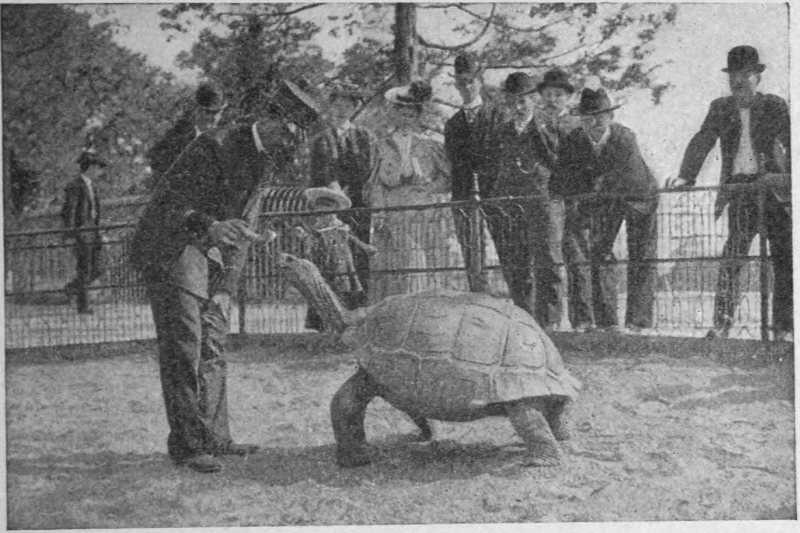
GIANT TORTOISE.
The following species taken together fairly represent the different forms of Chelonians, from the highest to the lowest:
The Alligator Turtle, (Macrochelys lacertina), is the largest fresh-water chelonian in North America. In form and temper it resembles the common snapping turtle of the North, and its home is in the Gulf States. The largest of the two Louisiana specimens on exhibition weighs 115 pounds.
The Snapping Turtle, (Chelydra serpentina), which is the most courageous and pugnacious of all turtles, is rather poorly protected by its shell, and must therefore fight for its place in nature.
The Painted Turtle, (Chrysemys picta), is a species of wide and common distribution, and fairly representative of the host of fresh water terrapins and turtles so common throughout the United States in ponds and streams of all sorts.
The Box Tortoise, (Cistudo carolina), lives on land, and as a means of perfect protection has been enabled by nature completely to withdraw its head and legs within its shell, 174 and by means of a hinge across the middle of the plastron, or lower shell, to close it tightly.
The Tortoise and Lizard Yards.—At the eastern end of the Reptile House is a commodious glass-roofed hall, opening into a series of sandy yards. This installation is occupied by the collection of tortoises and the larger tropical lizards. These reptiles do better in captivity, and show to best advantage, if given outdoor sunlight and plenty of room for exercise.
The Giant Tortoises are among the most interesting of living reptiles. There are fourteen distinct species, all belonging to the genus Testudo. These creatures appear to be survivors of the reptilian ages when reptiles attained colossal proportions. Fossil remains of the great tortoises show these creatures to have formerly inhabited the continents, but the survivors are restricted to isolated groups of small islands in the Pacific and Indian Oceans. Six species inhabit the Galapagos Islands in the Pacific Ocean. Four are found in the Aldabra Islands in the Indian Ocean, and four inhabit the Mauritius-Rodriguez group of Islands. All the species are rapidly becoming extinct. Recent expeditions to the Galapagos Islands have reported that very few Giant Tortoises now survive in those islands.
The Giant Tortoises are entirely herbivorous. The specimens exhibited consume great quantities of green food, which varies in kind according to the season’s supply. During the summer months they feed largely upon melons.
Among the species exhibited is Testudo vicina, represented by our largest specimen, captured in the Galapagos Islands. It weighs slightly over two hundred and twenty-five pounds. Another example from the same islands represents Testudo nigrita, a smaller and flatter species. Testudo elephantina, the Elephant Tortoise, is represented by a large specimen from the Aldabra Islands, which is growing rapidly. The latter tortoise has a very high shell, and proportionately small head.
The Gopher Tortoises, (Testudo carolina), are large, thick-shelled, clumsy creatures, which burrow in holes in the sandy southern regions where they live. Once they were common in southern Florida, but their edibility has resulted in a great decrease in their abundance.
The South American Tortoise, (Testudo tabulata), is a good representative of the smaller tortoises from various parts of the world. It is common throughout tropical 175 South America and attains a maximum length of shell of about 14 inches. The shell is elongated and blackish, each of the shields having a yellowish center. Like all of the tortoises, this is a herbivorous reptile.
The Marine Turtles.—At the New York Aquarium, situated in Battery Park, and managed by the New York Zoological Society, will be found a fine collection of such large sea-turtles as the Loggerhead, Green Turtle and Hawksbill, which require salt water.
The Soft-Shelled Turtle, (Aspidonectes ferox).—As to living relatives, this strange genus seems apropos of nothing. Like some of the marine turtles its shell is greatly reduced in weight, so that it can float more readily; instead of being solid bone, it terminates in a wide, thin edge of cartilage, which is so soft that when properly boiled it constitutes palatable food.
The Order of Crocodilians.—This important Order, the members of which are widely distributed throughout the tropics and sub-tropics of the world, contains nineteen species. At this point it is well to correct certain very general misapprehensions regarding crocodilians.
Crocodiles are not confined to the Old World; at least three species being found abundantly in tropical America.
The “movement” of a crocodile’s jaw differs in no manner whatever from that of an alligator.
Only a few species of crocodiles are dangerous to man.
There is no authentic record of the loss of a human life through our common alligator.
The Alligator genus embraces the American Alligator, (A. mississippiensis), of the southern United States and a small species found in China! The head of the Alligator is very flat and its sides are nearly parallel, while the head of a typical crocodile is nearly triangular.
The American Alligator is well represented in the Pool in the Reptile House, by several lusty specimens, all of which eat voraciously, are growing rapidly, and undoubtedly enjoying life. The largest specimen, a burly monster over twelve feet in length, has grown nearly five feet in length since its arrival here in 1899.
In summer, the Alligator Pool on the hill, southeast of the Reptile House, is well stocked with alligators of various 176 sizes, and it is there that visitors can secure most realistic impressions of the appearance of this species in a state of nature, and in abundant numbers.
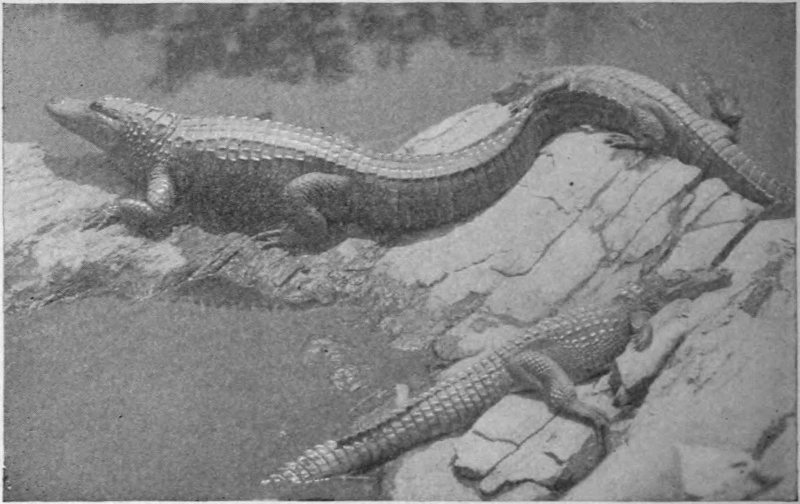
ALLIGATOR POOL.
Under favorable conditions,—warm water and air, good light, plenty of room, and abundant food,—the Alligator grows rapidly. A specimen hatched in our Reptile House in October, 1900, was in January, 1911, 8 feet 3 inches long, and weighed 75 pounds.
The Crocodile genus is widely represented throughout the world. Of the whole eleven species, the American continent contains four—the Florida Crocodile, (Crocodilus acutus floridanus), attaining a length of 14 feet, which was discovered at the head of Biscayne Bay, in 1875, by W. T. Hornaday; the American Crocodile, (C. acutus); the Sharp-nosed Orinoco Crocodile (Crocodilus intermedius), found in South America; and the small Crocodilus rhombifer, which is found only in Cuba and the West Indies.
Of the seven remaining species, Asia contains four, and Africa three. Of the Asiatic species, one frequents salt water.
The Florida Crocodile is now represented by two specimens nearly 9 feet long, from Madina Creek, southern Florida, presented by Mr. Julian A. Dimock. It is to be recognized at a glance by its dark olive color and sharp-pointed head. This is the only species of crocodile found in the United States. Its maximum length is 14 feet 2 inches.
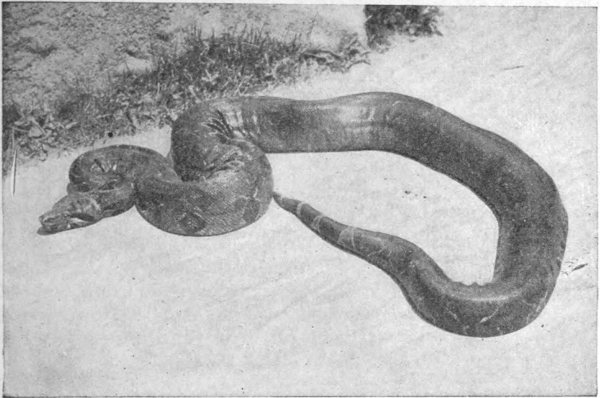
VENEZUELAN BOA.
The Broad-Nosed Crocodile, (Osteolaemus tetraspis), of Africa, is represented by two specimens. This species is characterized by the broad, bony-looking head. It is one of the smaller crocodilians attaining a maximum length of five feet.
The Tropical Lizards.—Several families of lizards are represented among the specimens occupying the Reptile House, the Tortoise room and outside runways. Among these are the Iguanas, Tegus and Monitors.
Among the Iguanas are several large and interesting lizards. The largest of these is the Rhinoceros Iguana, (Cyclura cornuta), found in Hayti. Contrary to the general belief, but like all the Iguanas, it is partly carnivorous, though it feeds largely upon vegetables and fruit. This species receives its name from the presence of three well-defined horns upon the snout.
The Mexican Iguana, (Ctenosaura acanthura), looks unique in the possession of rings of sharp spines about the tail. Most specimens are jet black when adult, but very young examples are pale green.
The South American Iguana, (Iguana tuberculata), may be readily distinguished by the very pronounced fringe of 178 erect spines which rise along the back-bone of male specimens, and also by the presence of a rounded tubercle or plate on each side of the head. This is a brightly colored Iguana, having bars of green, gray and black. It is strictly arboreal, and evinces stronger herbivorous habits than species of the allied genera. A large male specimen is seven feet long, but much of this length is taken up by the gradually tapering tail. In South America—on the Orinoco, at least—this species is considered edible, and the writer can testify that to a hungry man its flesh is excellent.
The very popular Horned “Toad”, (Phrynosoma), of the southwestern states, of which there are eight or nine species, should be mentioned if for no other reason than to place it where it belongs—with the lizards, and not with the toads.
The Tegus, (genus Tupinambis), are powerful lizards, growing to a length of four feet, and inhabiting tropical South America. They are fleet of foot, mainly carnivorous and very quarrelsome. It is impossible to keep any but the larger lizards in the yard with them. Tegus are fond of eggs, breaking the shell at one end and lapping up the contents by means of the very broad, forked tongue. They will also eat raw beef.
The Australian Monitor, (Varanus gouldii), is a good representative of a genus of large and powerful lizards confined to the Old World, where they occur in India, Malaysia, Africa and Australia. Monitors grow to a length of eight feet. They are swift runners, entirely carnivorous, and usually dwell in thick jungles. They are able to swallow entire an animal as large as a half-grown rabbit. All are fond of eggs, swallowing them without breaking the shell, which is soon dissolved by the powerful gastric juices.
Other Lizards.—Within the main halls of the Reptile House will be found various representatives of the smaller Lizards, a few of which may be mentioned.
The beautiful, emerald-colored Green Lizard, (Lacerta viridis), of Europe, is not only a handsome species, but it is also one of the most satisfactory to keep in a vivarium—a good feeder and always posing.
The famous Glass “Snake,” (Ophiosauris ventralis), is important because its resemblance to a snake is so perfect it is generally mistaken for one, although a true lizard. It 179 is not, however, a “connecting link” between the lizards and the serpents.
Our well-known Gila Monster, (pronounced He-la) (Heloderma suspectum), is a stupid, slow-moving creature from the southwestern deserts, thick-set and stumpy in body, and it has the appearance of being covered all over with dark-brown-black, and yellow beads, such as Indians use in their bead industry. Its bite is sufficiently venomous that it inflicts a painful wound, but it is not necessarily fatal.
The Chameleon of the Old World, (Chamaeleo vulgaris), because of its color phases and its remarkable form, is truly a great “curiosity”; but it should not be confused with our so-called American Chameleon, which belongs to another Family, and is also less interesting.
The Order of Serpents, (Ophidia).—The large glazed cases along the northern side of the main hall of the Reptile House are devoted to the larger serpents, while the smaller species are provided for along the south wall, and in the adjoining room. One serious difficulty in the management of a collection of living serpents lies in the fact that often the most valuable specimens are so nervous and shy in their feeding habits it is impossible to cage several together.
Out of the many species of serpents exhibited in the Reptile House, ten are chosen as fairly representing the principal groups.
The Regal Python, (Python reticulatus), here represented by a fine specimen, 22 feet in length, weighing 170 pounds, is the best representative of the rock pythons of Asia and Africa. The island of Borneo is its center of distribution. None of the constrictors is venomous, but their crushing power is almost beyond belief.
The Rock Python, (Python sebae), of Africa, is a light-colored species with a very small head, and is frequently seen in the hands and around the necks of snake-charmers.
The Anaconda, (Eunectes murinus), is one of the largest constrictors of tropical America, and is noted for its aquatic habits. It is a handsome serpent, being of a rich green color, marked with large black spots.
The Black Snake, (Bascanium constrictor), a common species in the eastern United States, is probably the highest 180 type of the harmless snakes. It is a serpent of great vigor and activity in running, climbing, and swimming; it possesses great courage, and seeks prey of many kinds in all kinds of situations.
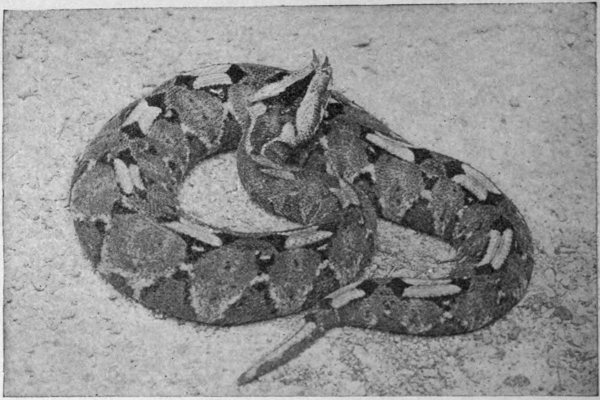
RHINOCEROS VIPER.
The Garter Snake, (Eutaenia sirtalis), is more frequently seen in the eastern United States than any other serpent. Although the warfare waged against it is perpetual, regardless of the fact that it is as harmless as a fly, its numbers do not sensibly diminish.
The Hog-Nosed Snake, “Puff Adder,” or “Sand-Viper,” (Heterodon platyrhinus), represents a large and important Family, and, despite its dangerous appearance and terrifying names, it is quite harmless. It represents one of Nature’s methods for protecting harmless and inactive creatures, by making them resemble others which are dangerous.
Venomous Reptiles.—Because of the number of species of rattlesnakes which have found lodgment in the United States, and the trouble they have caused in a few localities, we are specially interested in all serpents which are dangerous to man. The species named below represents the deadly genera which civilized man has most cause to fear.
The Harlequin Snake, or Coral Snake, (Elaps fulvius), represents a genus which contains many species, though but few of them occur in America.
The King Cobra, (Naja bungaris), from the Malay Peninsula, 181 often called Snake-Eating Cobra, is the most dangerous of all serpents, because it is the largest and the most athletic of the venomous species, and for its bite there is no effective antidote. It feeds only on living snakes. The fine specimen exhibited is about ten feet in length.
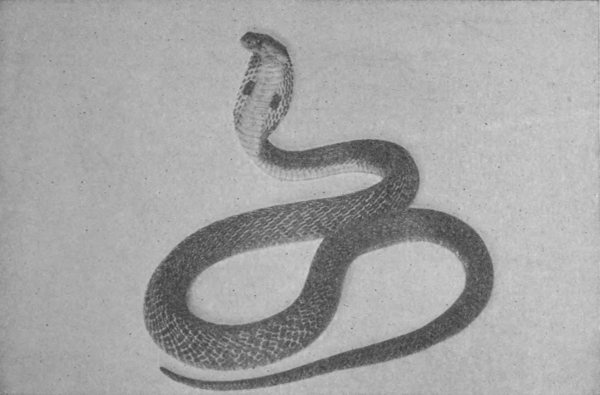
COBRA-DE-CAPELLO.
The Cobra-de-Capello, (Naja tripudians), of which some fine specimens are shown, is the terror of India, where it kills between 18,000 and 20,000 people annually! This is the most deadly of all serpents. For its bite, science has thus far been powerless to find an antidote, although Dr. Albert Calmette, of Lille, France, experimenting extensively in this direction, has secured partially successful results.
The most vicious snake in North America, and one of the ugliest in appearance, is the Water Moccasin, (Ancistrodon piscivorus),—closely related to the beautiful Copperhead, (A. contortrix). It is more dreaded in the South than the rattler, because it strikes on the slightest provocation, and without the rattler’s timely warning. Its colors are dull, its scales rough, its body ill-shaped and clumsy, its temper is vicious, and for every reason it is a serpent to be disliked.
The Diamond-Back Rattlesnake, (Crotalus adamanteus), is too handsome, too showy, and too large to be chosen as the best average type of the genus Crotalus; but he is king of his kind, and cannot be ignored. Three species shown side 182 by side in our Reptile House afford striking examples of protective coloration. The Diamond-Back Rattler of Florida and the South is yellow, brown, and black, to match the checkers of sunbeam and shadow that fall upon the sands under the palmetto leaves.
Among the many wonders of Nature, none is more interesting than those forms which serve to connect the great groups of vertebrate animals, by bridging over what otherwise would seem like impassable chasms.
Between the birds and the reptiles there is a fossil bird, called the Archæopteryx, with a long, vertebrated, lizard-like tail, which is covered with feathers, and the Hesperornis, a water bird with teeth, but no wings, which inhabited the shores of the great western lake which has already yielded to American paleontologists a great number of most remarkable fossil forms.
Between the reptiles and the fishes, stretches a wonderful chain of living links by which those two Classes of vertebrates are so closely and unbrokenly united, and by such an array of forms, that they constitute an independent Class, the Batrachia, or Amphibia. In the transition from water to land, from fins and gills to legs and lungs, Nature has made some strange combinations. In some instances the fins, legs, lungs and gills have become so mixed that several notable misfits have resulted, and in some cases we see gills and legs going together, while in other lungs and fins are associated.
The Reptile House contains about two dozen species of Amphibians, and it is reasonably certain that this number will be maintained and increased. They are to be found in small aquarium cases, ranged along the south side and eastern end of the Main Hall.
The Bullfrog, (Rana catesbiana), is a fair representative of the Batrachians which stand nearest to the true land-going reptiles. During the early stages of its existence it is in turn, a fin-tailed tadpole with no legs, a short-tailed tadpole with a pair of front legs, a shorter-tailed tadpole with four legs, and finally a fully-developed, land-going frog with a voice like a small bull, and no tail whatever. Of the genus Rana, there are five species in the eastern United States, several of which inhabit the Zoological Park.
The Wood Frog, (Rana sylvatica), is frequently seen in moist valleys in the Zoological Park, where its chocolate brown back so closely matches the color of the dead leaves and moist earth; it is difficult to find, save when it takes one of its flying leaps. The specimens shown were taken near the Beaver Pond.
The Tree Frog, (Hyla pickeringi), is the commonest of the queer little tree-loving species which are so easy to hear, and so difficult to find. In spring their voices are the first to be heard in the swamps. The Zoological Park is full of Hylas, and their cheerful piping is heard at all seasons, especially in dry midsummer, when dark storm-clouds gather and promise rain.
The Common Toad, (Bufo lentiginosus), is found in the Zoological Park, though not in such abundance as the two preceding species.
Among the most remarkable creatures in the Reptile House are the specimens of Smooth-Clawed Frog, (Xenopus laevis), from Africa and The Surinam Toad, (Pipa americana). Both of these species are strictly aquatic and have broadly palmated hind feet. The Surinam Toad comes from Dutch Guiana. It is unique in its breeding habits. The male collects the eggs and places them on the female’s back where they are engulfed in large folds of the skin, which form cells in which the metamorphosis occurs.
The Spotted Salamander, (Salamandra maculosa), because of its broad, bright yellow bands and blotches, laid on a rich, dark-brown body color, is one of the most showy of all Amphibians. It comes from Europe, and being much prized in collections, it frequently passes through the hands of dealers in reptiles. Its skin is very moist and clammy, which gives the creature the appearance of having been varnished. This is the creature which is supposed to be able to withstand fire—a belief which is purely imaginative.
The Tiger Salamander or Axolotl, (Amblystoma tigrinum), is a widely different creature from the preceding. It is found throughout the greater portion of the North American continent, and as far south as Central Mexico. Thirteen other species of the genus Amblystoma are found in North America and Mexico. In the matter of “harmonizing with environment,” the Amblystoma is one of the most remarkable creatures in existence. In its larval stage (corresponding with the tadpole stage of a frog), this animal 184 possesses external gills, red and sponge-like in appearance, and its tail has a fin-like edge above and below, like the tail of an eel.
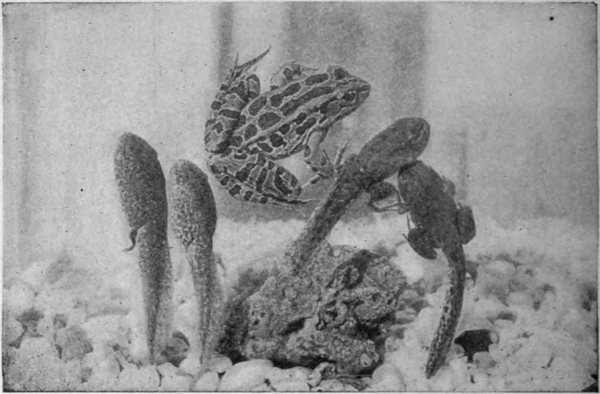
METAMORPHOSIS OF THE LEOPARD FROG.
So long as this larval creature remains in water, its external gills remain and do duty, and the larval stage continues indefinitely. Remove it from water, or let its home pool dry up, and, presto! its gills dry up, its tail loses its fin-like edges, and the creature goes about on land, breathing air instead of water, with lungs instead of gills.
The “Water-Dog” or “Hellbender,” (Cryptobranchus allegheniensis), is a salamander-like amphibian, from 18 to 22 inches long when adult, found more frequently in Pennsylvania than elsewhere. They are said to be very tenacious of life, and voracious in their food habits, feeding on worms, minnows and crayfish, and often taking the hook of the fisherman in quest of that most repulsive of all American fishes, the cat-fish. Between cat-fish and water-dog there would seem to be small choice. Mr. William Frear offers this testimony in regard to the tenacity of life of this creature:
“One specimen, about 18 inches in length, which had lain on the ground exposed to a summer sun for 48 hours, was brought to the museum, and left lying a day longer before it was placed in alcohol. The day following, desiring to 185 note a few points of structure, I removed it from the alcohol in which it had been completely submerged for at least 20 hours, and had no sooner placed in on the table than it began to open its big mouth, vigorously sway its tail to and fro, and give other undoubted signs of vitality.”
The Congo Snake, or Amphiuma, (Amphiuma means), is a creature which closely resembles a thick-tailed snake. A close examination, however, discloses a tiny pair of front legs; and far back, well toward the end of the tail, a small pair of hind legs appear. These are about as valuable to the animal as the tiger’s clavicle is to him. There are but two species belonging to this strange genus, both of which are found in the stagnant waters of our southeastern states. Still lower than the amphiuma, is The Mud Eel, (Siren lacertina), of the southeastern quarter of the United States, which possesses small external gills, and only one pair of legs, which are in front.
The Menobranchus, or Mud Puppy, (Necturus maculatus), possesses external gills and four legs, and inhabits many of the rivers of Ohio, Pennsylvania, Indiana, the great lakes and also the lakes of northern New York. It is often taken in fisherman’s nets.
A collection of insects was formed and placed on exhibition during the early summer of 1910. While this first exhibit was not elaborate, it excited such interest that it was decided to enlarge it, by taking advantage of the season which then was at its best for insect collecting.
A series of long shelves has been built in the Pavilion between the Small-Mammal House and the Ostrich House, and thirty-five glass-fronted cages, together with a row of aquaria for aquatic specimens, were installed. A number of collecting trips were made into the country within a radius of twenty-five miles of the city, with such marked success, that by the middle of July the collection was pronounced by a number of visitors to equal in interest any exhibition of the kind heretofore attempted in this country, or in Europe. In view of the marked interest created by this display, the insect collection will hereafter be a permanent feature of the Park.
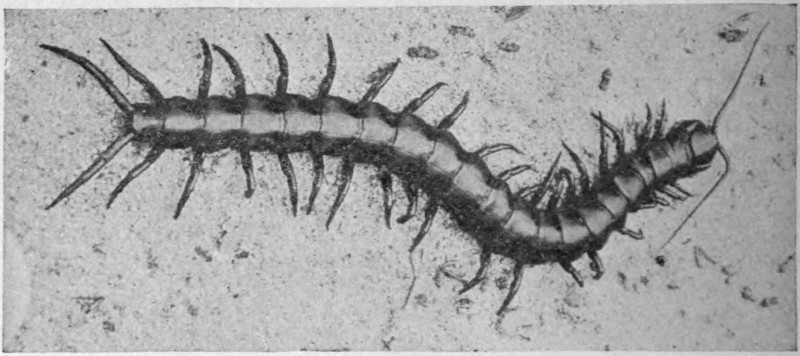
GIANT CENTIPEDE.
There are so many possibilities in exhibiting living insects that it is difficult to select groups to feature for the summer. Our efforts were first directed toward exhibiting a series of the different insects that sing, and also a series of species injurious to the interests of the agriculturists, together with a number of the insects that prey upon the noxious species. The collection of singing insects was a marked success and will hereafter be continued each summer.
We are gathering from both the Old World and the New, a fine collection of the larger silk moths. The cocoons will be shown on panels, and inasmuch as a number of the moths will be emerging daily, this exhibit should be instructive. During the winter the insect collection is made up largely of tropical species; and in this series we include the large bird-killing spiders, scorpions and centipedes, even though these creatures are not to be classified as true insects.
The collection of singing insects of the past summer was composed of the meadow locust, greater and lesser cone-headed locust, the Katy-did, broad-winged locust, field cricket, lesser field cricket, smooth-winged cricket and two species of the tree crickets. There were about five hundred specimens in the collection, and at times the noise made by them was so great that visitors had to shout to one another to make their own voices audible. The sounds coming from this collection varied according to the time of day. It was late in the afternoon, when the larger locusts commenced their singing (which continued throughout the night), and inasmuch as the strictly diurnal species were yet active, the insect chorus was quite vociferous.
It is only with considerable difficulty that singing insects are collected. The best time to capture them is at 187 night, when the collector stalks the loudest singers, and by approaching within definite investigating distance, can accurately locate the insects by bringing into use an electric flash-lamp. The glare of the light usually causes the insect to stop its calls, but it remains motionless upon a branch or leaf and may be grasped with a delicate pair of forceps, provided the movements of the collector’s arm are performed outside the rays of light. If the locust has become silent and cannot be detected when the light is thrown upon it, the collector simply switches off the light and remains quiet. In a few minutes the creature continues its song, when its exact location is again determined. In this way the night songsters of a big meadow are collected, one by one, and the collector leaves behind him a silent field that a few hours before resounded with the stridulations of the insect chorus.
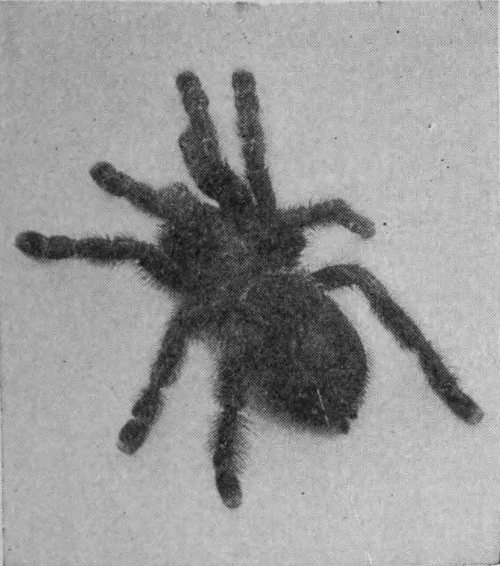
TARANTULA.
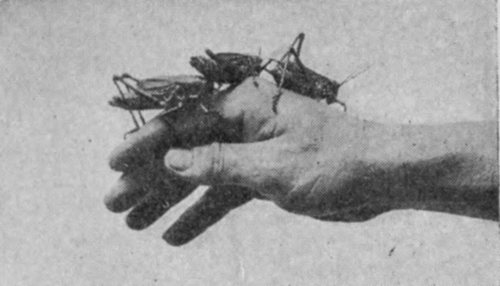
RED-WINGED LOCUST.
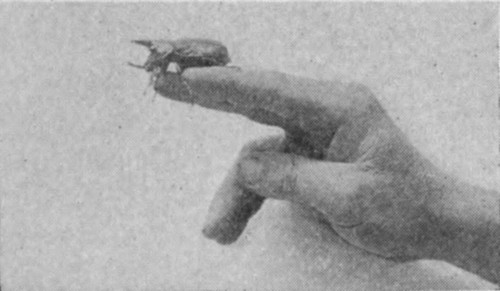
HERCULES BEETLE.
Among the more interesting insects exhibited, in our series are to be found the walking-stick, the praying mantis, the huge red-winged locust of the South, the Egyptian scarab, the luminous beetle of Central and South America, and broods of silk worm. The life history of the mosquito will be permanently illustrated in a series of tanks, and adjoining these an exhibit of natural enemies of these pests.
The insect collection is supplied with interesting descriptive labels. During the latter part of spring it is removed from the Reptile House, where, during the winter the number of its cages are much reduced, and replaced in the quarters occupied during the summer.
A B C D E F G H I J K L M N O P Q R S T U V W X Y Z
Membership in the Zoological Society is open to all who are interested in the objects of the organization, and desire to contribute toward its support.
The cost of Annual Membership is $10 per year, which entitles the holder to admission to the Zoological Park on all pay days, when he may see the collections to the best advantage. Members are entitled to all the Annual Reports, bi-monthly Bulletins, Zoologica, privileges of the Administration Building, all lectures and special exhibitions, and ten complimentary tickets to the Zoological Park for distribution.
Any Annual Member may become a Life Member by the payment of $200. A subscriber of $1,000 becomes a Patron; $2,500, an Associate Founder; $5,000, a Founder; $10,000, a Founder in Perpetuity, and $25,000 a Benefactor.
Applications for membership may be handed to the Chief Clerk, in the Zoological Park; Dr. C. H. Townsend, N. Y. Aquarium, Battery Park, New York City, or forwarded to the General Secretary, No. 11 Wall Street, New York City.
Reports and Publications of the Zoological Society are for sale at prices affixed below:
| Annual | Report | No. | 1 | Paper | $ .40 | ||
| “ | “ | “ | 2 | “ | .75 | Cloth | $1.00 |
| “ | “ | “ | 3 and 4, each | “ | .40 | “ | .60 |
| “ | “ | “ | 5 “ 6 “ | “ | .75 | “ | 1.00 |
| “ | “ | “ | 7 “ 8 “ | “ | 1.00 | “ | 1.25 |
| “ | “ | “ | 9 “ 10 “ | “ | 1.25 | “ | 1.50 |
| “ | “ | “ | 11, 12, 13, 14, 15, 16, 17, 18, 19, each | “ | 1.00 | “ | 1.25 |
| Our Vanishing Wild Life (Hornaday) postpaid | “ | 1.65 | |||
| Destruction of Our Birds and Mammals (Hornaday) | “ | .15 | |||
| Notes on Mountain Sheep of North America (Hornaday) | “ | .40 | |||
| The Caribou (Grant) | “ | .40 | “ | .60 | |
| The Origin and Relationship of the Large Mammals of North America (Grant) | “ | 1.00 | |||
| The Rocky Mountain Goat (Grant) | “ | 1.00 | |||
| Zoologica Vol. 1, Nos 1-11 inclusive, set | “ | 2.30 | |||
| Sea-Shore Life (Mayer) | “ | 1.20 | |||
| The National Collection of Heads and Horns (Hornaday) Large Quarto. Parts 1 and 2, each | “ | 1.00 |
Address all inquiries and orders to
H. R. MITCHELL,
Manager of Privileges,
Zoological Park, 185th St. & Southern Boulevard. New York City.
Rocking-Stone Restaurant
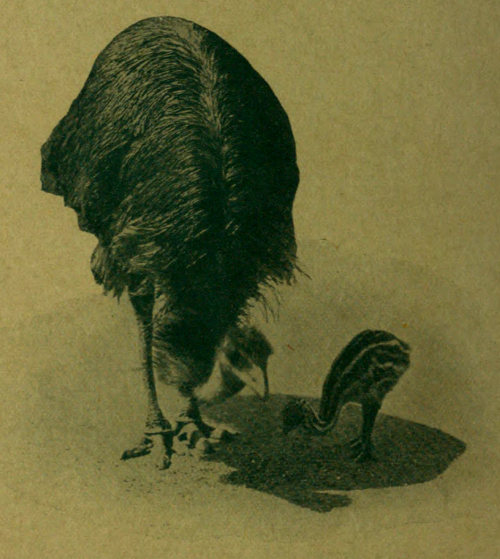
EMU AND YOUNG BIRD HATCHED IN THE ZOOLOGICAL PARK